Check here for outlet offers!

- Violin Travel Set
- Violin Travel Set Basic
- Viola Travel Set
- Product List
- Order Now
- User Manuals
- Violin Set
- Viola Set
- Viola Case Large
- Upgrade your ViolinCase!
- About us...

- Violin Travel Set
- Violin Travel Set Basic
- Viola Travel Set
- Product list
- User Manuals
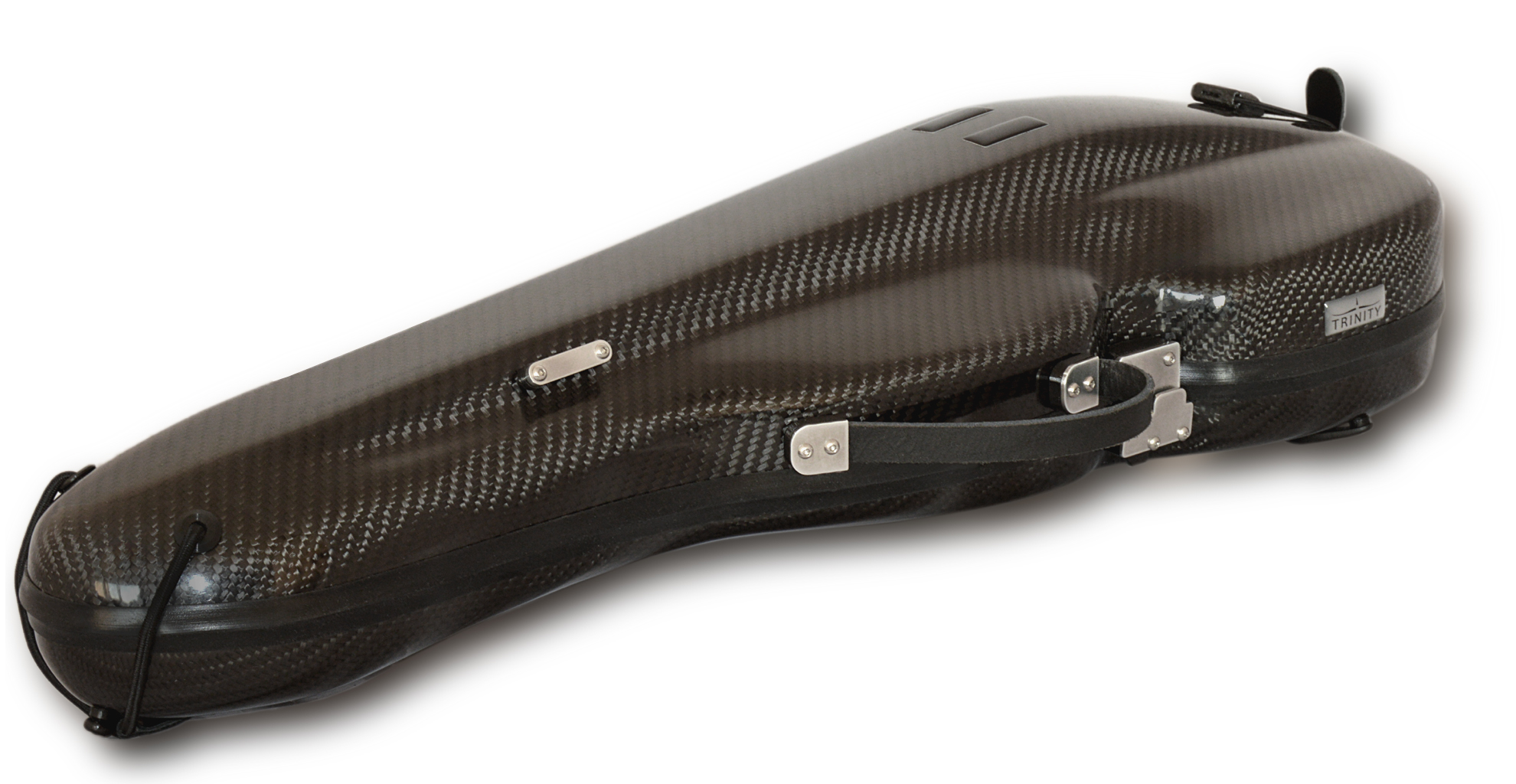
Trinity ViolinCase model 2
Newer version of our ViolinCase. More space inside and even more rigidity.
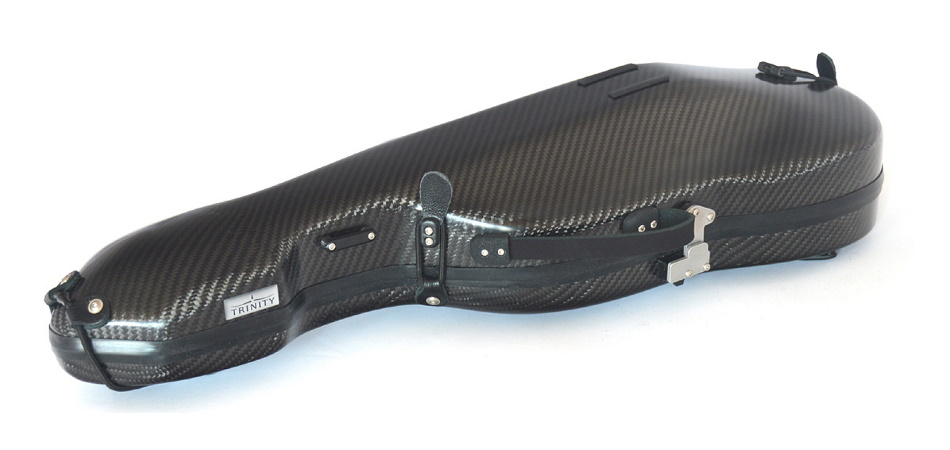
Trinity ViolinCase (model 1)
This model is not available anymore. But some ViolinCases model 1 are still offered in our Outlet subpage.
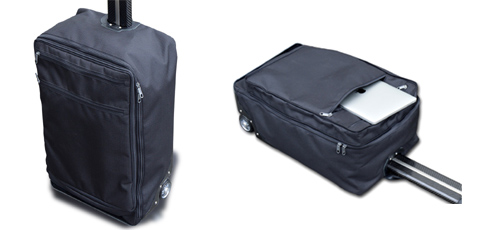
Trinity SuitCase
The Trinity SuitCase was created specially for the Trinity ViolinCase and BowCase . It uses every millimeter of your baggage allowance.
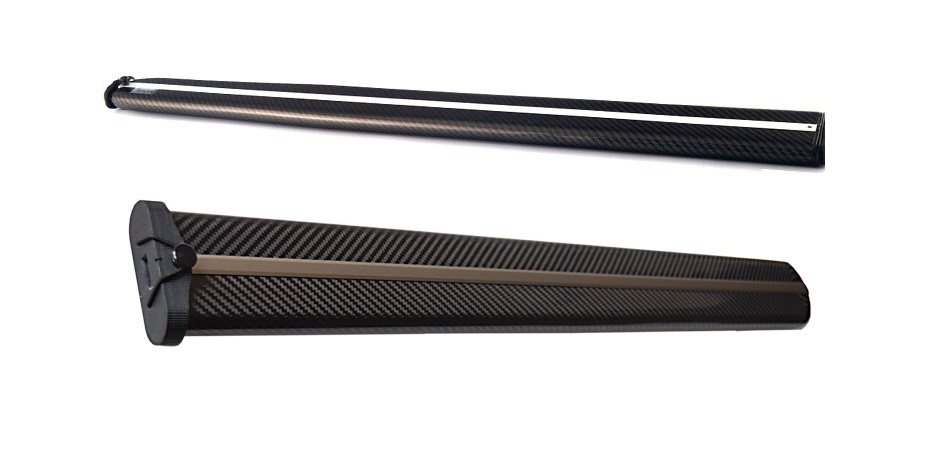
Trinity BowCase Compact
Compact version is 4 cm (1.67’’) shorter, a little lighter and doesn't have any mechanical parts. The inside is as long as the original Trinity BowCase - for all bow lengths (up to 75,5 cm/29,72'')
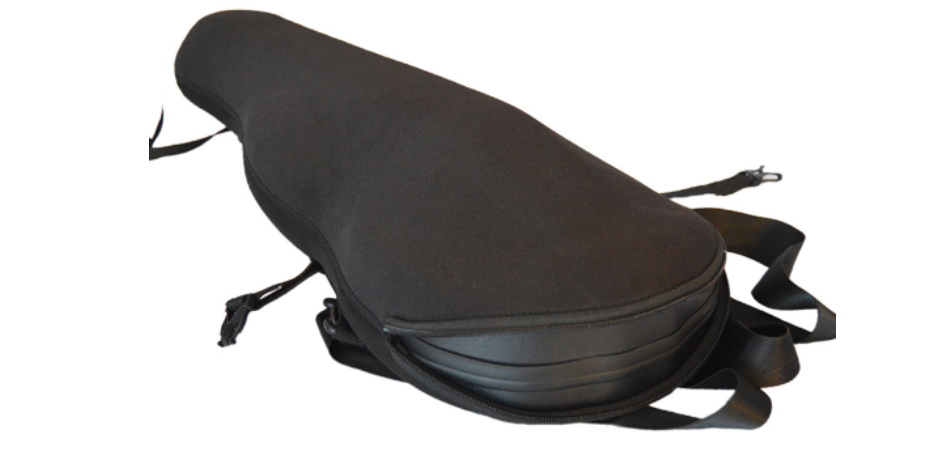
Trinity ViolinCase Basic
The same shape as our new model of the carbon fiber Trinity ViolinCase Model 2 but, thanks to its cheaper materials, some simpler solutions and only one standard version, we can offer it the for the really low price.
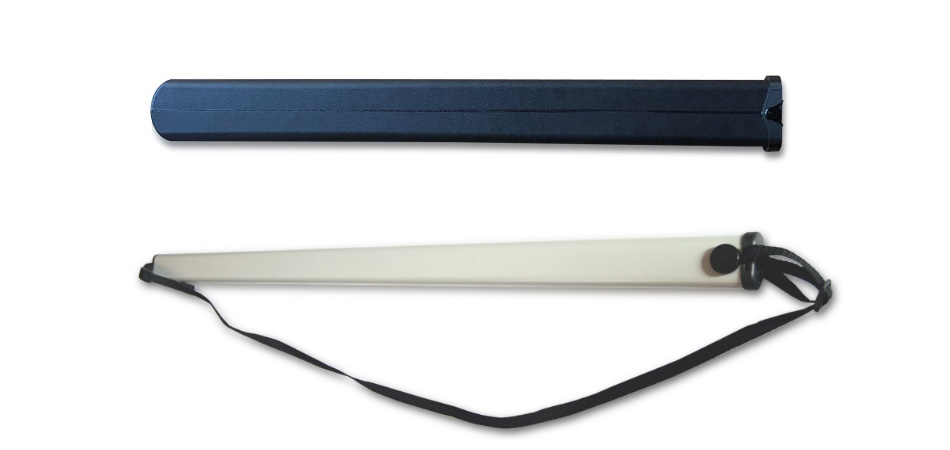
Trinity BowCase Basic
ABS plastic shell isn’t as resilient to impact as our composite cases but still very strong and extra protected by its Soft Cover (included in the price).
Trinity BowCase Single
Made of aluminu m, for one bow only.

Trinity ViolinCase Model 1
Trinity ViolinCase Model 2
Trinity BowCase Standard
Trinity SuitCase Basic
Full Product List
Trinity ViolaCase S - Small
Trinity ViolaCase M - Medium
Trinity ViolaCase L - Large
Trinity Wheeled SuitCase - Large
Trinity Travel Bags
Order Form - Viola Case 'M' and 'L' and bags
Order Form - Viola Case Large - L
Other links:
Contact us...
- Five-strings
- Instruments for children
- Antique instruments
- Carbon bows
- Wooden bows
- Violin bows
- Bows by Guillaume KESSLER
- Cases and protections
- Fine adjusters
- Bow maintenance and rehair
- Cello restoration and repair
- Custom-made instruments
- Rent an instrument
- Violin maintenance, setup and adjustment
- Internships in violin-making
- Payment and Shipping
- Track your order
No products in the cart.
- Search for: 78543

Travel violin bow by Guillaume Kessler
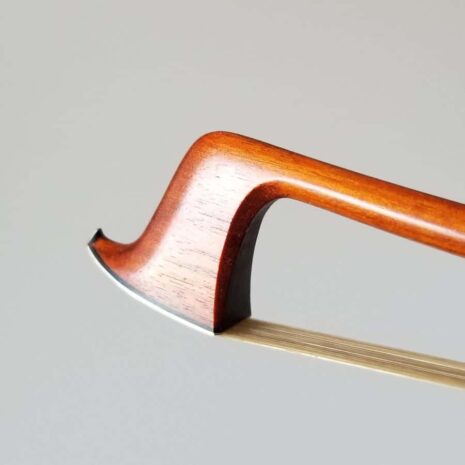
3395,70 € – 4851,00 €
First and foremost, these bows are unique pieces, handmade in the French bow making tradition. First and foremost, these bows are unique pieces, handmade in the French bow making tradition. They are for violinists who want a great sound and an unmatched playability. If you go abroad often, this bow is your new passport – with it, you will go through no more troubles at the check-in-procedures, and, what’s more, it only needs a small change to turn into a completely vegan bow.
Description
More details.
- Payment and delivery
I’ve designed this travel bow with one thing in mind: making travels easier for today’s violinists. As you know, customs set restrictions on materials that are used in bow making (ivory, mother-of-pearl, some leathers, etc…). These decisions have made travelling more and more difficult for musicians. No one wants to have its bow seized or damaged because of check-in-procedures! That’s why I offer you a bow without any of these composites, but in keeping with the usual bow-making qualities.
Guillaume Kessler
Soloist / Concert bow
Strasbourg – France
Travel violin bow
Designed to be free from all customs issues, this bow gets down to basics.
To begin with, every stick I carve is selected from very nice pieces of Pernambuco . They are chosen them for their acoustics, aesthetics and mechanics.
The adjuster is simple, not adorned with mother-of-pearl or any other decoration. As for the thumbpieces, they are in shagreen leather, a material that is both resistant and easy to find because it is not so much used.
Then this model is fitted with a silver tip wrapped in a fine, high-quality ebony strip.
Finally, the wrapping, lining, button and eyelet on the bow are all silver mounted. Of course, I can make a gold mounting if you want one.
A top-of-the-range vegan bow
Obviously the standard model I offer is not vegan. However, it takes only a few changes to make a fully vegan bow, such as fitting Coruss hair and a vegan leather thumbpiece .
If this is important for you, feel free to ask me about it!
Classical or modern camber
In order to suit various styles, bows are available in two different tension models:
- The classical camber is after Tourte ’s bows. Their bow’s legato is incredibly smooth and they display a great fullness of sound.
- Then you have the modern camber after Sartory ’s bows. It offers very quick spring and response, as well as a great bite.
A stick matching your needs
Each Pernambuco sticks is selected to answer your needs in the best way possible. This is why I offer you three main choices:
- Brightness : the very quick response of this stick will give a most precise and clear sound to your violin.
- Balance : the perfect compromise between clarity and fullness
- Fullness of sound : this rather flexible stick displays a smooth play and a very full sound.
Your travel violin bow
Each bow is made just for you. Hence the possibilities are endless. Feel free to contact me now so that we find out what you need.
Moreover, each bow comes along a certificate of authenticity.
There are no reviews yet.
Show only reviews in English (0)
Be the first to review “Travel violin bow by Guillaume Kessler” Cancel reply
Your email address will not be published. Required fields are marked *
Your Rating * Rate… Perfect Good Average Not that bad Very Poor
Review title
Please check to consent to our Politique de confidentialité *
Your Review *
Username or Email Address
Remember Me
Don't have an account? Sign Up
Payment and shipping
Read about our various payment and shipping options .
Payment options
Each order must be paid in full before it is shipped. We currently accept the following forms of payment:
- Card ( Visa, Mastercard, etc. )
- Bank transfer
*Large accessories that cannot be sent in a tracked letter format will be sent in the same class packaging as bows. This will be the case for chin straps, for example.
Countries outside the European Union may apply a customs tax. Additional charges may apply depending on the content of the package. Please do not hesitate to contact me or the customs office in your country if you have any questions or concerns.
Deliveries for strings and accessories that measure under 3 cm are made in registered mail format and are therefore sent by the French Post Office. This applies both to national and international deliveries. This is a simple and efficient way to have your order shipped to you directly.
For larger accessories and instruments, I use the Chronopost or TNT solutions. A tracked shipment can either be delivered directly to your home or to a pick-up location, depending on your preference, which you will be asked to specify at checkout.
I generally ship orders between 1 and 4 working days. However, in exceptional circumstances, such as when travelling, I may not be able to meet these deadlines. In this case I will inform you as soon as possible.
For shipments outside of France, transporters may differ depending on the daily quotation.
DOM-TOM : Guadeloupe – Martinique – Guyana – Mayotte – Reunion – Saint Pierre and Miquelon – Saint Barthélemy – Saint Martin.
World zone 1: Albania – Andorra – Armenia – Belarus – Bosnia – Georgia – Gibraltar – Guernsey – Canary Islands – Faroe Islands – Iceland – Jersey – Macedonia – Moldova – Montenegro – Russia – San Marino – Serbia – Turkey – Ukraine – Vatican.
World zone 2: All other countries outside of Europe, DOM-TOM and world zone 1 territories.
Returns and exchanges
You have 14 days from the date of delivery to make a return or exchange. You must return all the items within 30 days of delivery , with the return form and your receipt of purchase included. Returns and exchanges will be refused if the return form and receipt are not included.
If you have any questions regarding payment or delivery, please contact me directly.
Related Products
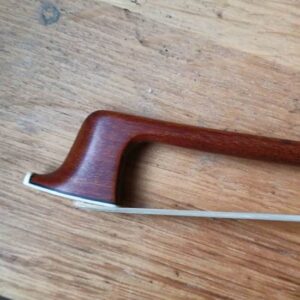
Cello bow by Simon Bourgeois
The Pernambuco stick on a cello bow by Simon Bourgeois offers a whole range of possibilities. Not only does the finish look neat, but the stick is extremely attractive as well: its sound and playability are up the expectations of modern bow series.
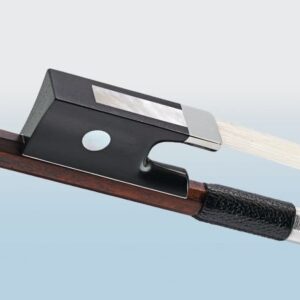
Dörfler Pernambuco student violin bow
Brazilwood stick, labelled “Werner” and made by Dörfler.
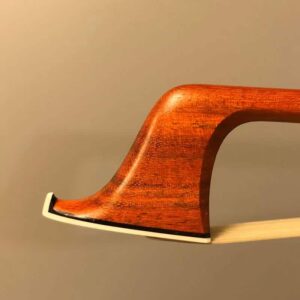
Cello bows by Guillaume KESSLER
Here’s a bow made just for you in my workshop.
Viola bow by Simon Bourgeois
The Pernambuco stick on a viola bow by Simon Bourgeois offers a whole range of possibilities. Not only does the finish look neat, but the stick is most beautiful as well: its sound and playability are up the expectations of modern bow series.
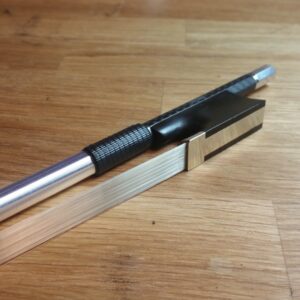
Vegan Coruss violin bow
Finally, here’s a bow to satisfy the people who are the most concerned about animal welfare – a bow that uses no animal product. Of course, even if you’re not vegan, you’re welcome to use it!
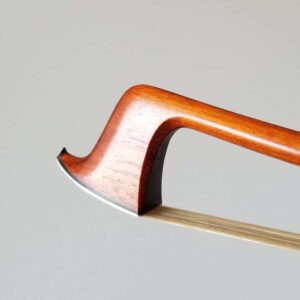
Travel cello bow by Guillaume KESSLER
First and foremost, these bows are unique pieces, handmade in the French bow making tradition. They are for cellists who want a great sound and an unmatched playability. If you go abroad often, this bow is your new passport – with it, you will go through no more troubles at the check-in-procedures, and, what’s more, it only needs a small change to turn into a completely vegan bow.
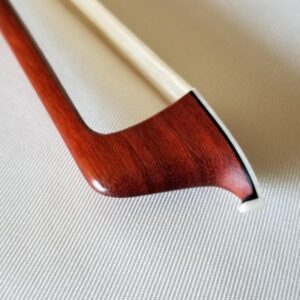
Violin bow by Florian Bailly
First and foremost, violin bows by Florian Bailly are unique pieces, handmade in the French bow making tradition. They are for violinists who want a great sound and an unmatched playability.
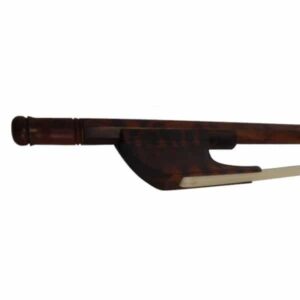
Baroque violin bow
Snakewood violin bow
WIPLSTIX.COM
828 713 2424
Wiplstix Travel/ Practice Violin
the "infiddel".

WipLstix is a very handy travel violin I invented in 1999. There are now over 850 of them floating around the galaxy, and they are still made solely by me in my shop in the southern Appalachians. The length between its bridge and nut is that of a standard 4/4 violin, but the body has been minimized to maximize portability. WipLstix is a self contained unit, and with a 1/8th size bow and inflatable chinrest (sold separately), they will fit inside a 2" diameter by 24" long watertight, traveling, tube transporter.
As of 03/20/22
Wiplstix are back in production! After a 3 year break to pursue other interests I am excited to be making my "pretty liddle fiddle" again. I hope to have these new Wiplstix ready to send out by early April.
New things:
I am adding an option for higher-quality strings on the Wiplstix. Currently, I am waiting for the cheap strings That are included in the cost of the Wiplstix. They are on a slow boat from China and wont be here until the end of April. The schwanky Larson Danish strings will be here in a week or so. Those will allow me to send it out a month earlier. If you dont order the Larson Strings then your fiddle will be sent out in early May.
For those that want a more traditional set up, I am excited about adding the option of a traditional chinrest/ shoulder rest . An adaptor will replace the tuning pitch pipe at the butt of the instrument and a lightweight chin/ shoulder rest can be screwed in and out. The rests won't fit in the case like the inner tube but they break down and are quite minimal.
There are 3 options of wood:
Black Walnut- is native to the East coast. It is a common, fast growing, "early succession" tree which makes it high on my list for regenerative agriculture. It is the standard workhorse wood that I prefer for wiplstix being very stable, having a warm sound, and rich dark chocolate color.
Figured cherry wood- As I was cleaning up the shop this winter I found one last board of this uniquely figured old growth cherry. This exceptional wood is reserved for fiddles if you like a little eye candy.
Tulip Poplar- is a light cream/ greenish color. It is the least dense wood of the three. The softer the wood in wiplstix the warmer and louder the tones, but you may compromise durability. I made wiplstix guitars a long time ago, and the ones made from the poplar wood had the best tone. Im not sure whether that will translate to the fiddles. The wood is very ordinary looking, and very light of weight if that is important.
If you would like to order a wiplstix this spring, send me an email to [email protected]
and I will let you know when to make a payment Thank you for your interest, and please feel to browse the site especially the wiplworld pages.

"Proves you not only think outside the box,
you don't even know where the box is!"
- A. Miller
Wiplstix customer
Flying with a Violin: Transport Your Musical Instrument Safely
by Editorial Staff Last Updated December 22, 2020
Editorial Staff
Our editorial staff consists of a multitude of talented people consisting of musicians, enthusiasts, and talented researchers and copywriters. Our goal? To help you, our readers, get the information you need in the best way possible.
Consordinis articles are written by musicians who independently research, test, and recommend the best instruments and products. We are reader-supported. When you purchase through links in our articles, we may earn an affiliate commission.
Every musician loves his instrument. There can be nothing more traumatizing for a musician than damaging his precious instrument.
And, if you play the violin and you are going somewhere that requires you to travel by air, it’s only normal that you want to continue creating music with your instrument.
However, a violin is an extremely delicate “music-making-machine” (just as how all the other stringed instruments are).
And, it is a grave risk that you are taking if you are planning to check it in with the very cold environment at the cargo section of the plane.
Also, you can never be sure that the baggage handlers won’t break it.

With this in mind, you’ll have to learn how to keep your instrument safe during transit and avoid any damage.
10 Tips and Tricks to Pack your Violin
It probably isn’t the greatest idea to just grab any box and stick a “fragile” note on it.
Keep in mind that in preparing to pack your most beloved violin, you must be equipped with the knowledge on how to do it:
1. Take a bow and wrap it
I am actually talking about your violin bow . It may be tempting to just let it stay inside the case with your violin, but to ensure added safety to your bow, an extra measure is needed. You have to:
- Get a separate bow case or a small PVC pipe slightly longer than your bow.
- Make sure to loosen the bow hair to prevent it from tightening during the travel period. If the bow hair becomes too tight, it might probably snap.
- Once it is loosened, pad both sides of the bow, or wrap it with packing material to prevent the bow from moving.
- Wrap the packed bow in PVC with bubble wrap .
- Place your PVC pipe or bow case into your violin case (if it fits) or inside your checked-in baggage.
2. Loosen the violin strings
While it is true that your violin case is a good protection , your violin will still be exposed to temperature changes.
Excess tension on the violin string may occur due to decreased humidity and fluctuating weather/temperature conditions.
Loosening the strings prevent the bridge from warping, as they are vulnerable and sensitive to temperature changes.
It can also prevent the strings from snapping because of the effect on the tautness of the string as a result of temperature changes.
To loosen your string:
Turn your tuning pegs to loosen the strings (not too much). You can do it by lowering the string a little or even a whole step lower . From sounding G, D, A, E, your violin string should sound F, C, G, and D.
3. Pack your violin with a hygrometer and a humidifier
What is a hygrometer?
Hygrometers are devices used to measure the moisture content of the atmosphere.
Ideal conditions for violins and other stringed-musical instruments are at 50–55% with relative humidity at 20°C.
Dryness (below 40%) involves greater risk as well as excessive humidity (over 70%).
Most violin hard cases come with a standard humidity gauge, but these hygrometers are usually not very accurate.
If you travel a lot and humidity is a major concern for you, I will recommend for you to buy a good-quality hygrometer or digital gauge.
Humidifiers
Wild swings in humidity and temperature can have an enormous effect on your violin’s performance – and sometimes on its structural integrity, most especially with antique instruments.
Prepping humidifiers and using it during your flight allows a controlled and continuous provision of moisture into your violin. This ensures optimum conditions to your violin.
As we have discussed, violins are vulnerable to the rapid changes in humidity and temperature fluctuations.
4. Turn the tuning pegs parallel to the scroll
Tuning pegs are extremely delicate and are easy to break. To decrease the risk of breaking, turn them parallel to the headstock or the scroll .
If you don’t want to, you can remove them and store them in your case’ inside pocket.
Just remember that by removing your pegs, the bridge gets less support so you can also remove it and keep it.
5. Use bubble wraps (and plenty of paddings!)
If you have bubble wraps or soft pads (or extra socks), you can ensure more protection for your violin.
You can put your paddings around the tuning pegs, under the fingerboard, and around the bridge, as they are your violin’s weak spots .
If space on your case permits, you can even wrap your violin with it. If you don’t like bubble wraps, you can get a small silk cloth or a silk bag to wrap your violin before placing it in the case.

Don’t use shredded paper or smaller packing materials for packing the violin. This stuff can fall through the f-holes of your violin and you’ll have a hard time taking them out.
6. Place the violin in a hard carrying case
First of all, if your violin costs more than $500 , it is best to consider investing on a hard case.
Even though the prices of hard cases are higher than the soft violin cases, hard cases merit the expense.
They guarantee you a safer place for your violin, rosin, mutes, tuners, and other violin accessories.
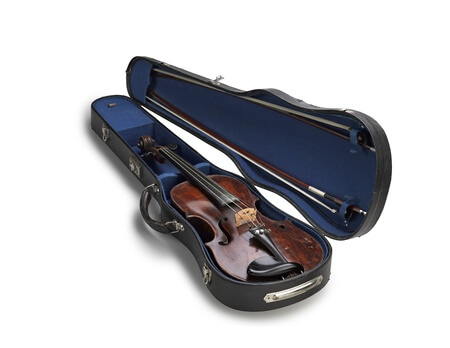
You can’t deny it but there are obvious benefits to having a hard violin case .
So, it is better for you to have one. If you still want to know why, consider these information below:
- Baggage handlers are always in a rush to pack the cargo, and sometimes they don’t heed any notes or “fragile stickers” on the baggage.
- Extreme humid environment and dry weather conditions are your violin’s worst enemy.
- Plane rides can be bumpy due to air turbulence.
Hard cases are like safety capsule that protects your violin while you are traveling.
7. Bring extra set of violin strings
Travelling on a plane is tricky. It poses real risks to your strings. Even if you followed all the safety tips in flying with your violin, strings still break.
It is best for you to bring an extra set of strings . There’s no harm for being sure just in case your string snaps anyway.
8. Purchase an instrument insurance policy
If your instrument costs you a fortune, you can get an insurance policy to cover your travel with your violin.
Most (if not all) airlines don’t pay for theft or damage to your instrument so being insured is essential.
If you have an existing insurance for your violin, be sure it is updated. You can contact your insurance provider about your policy for more details.
Remember, “Sometimes bad things just happen.” Insure your instrument.
9. Depend your violin
Whatever they say and do (as long as you know your rights), resist from staff taking your violin and putting it in the cargo section. Horror stories abound. Sad news exists.
Depend (but don’t argue), and ask mercy from the boarding team – beg and cry if necessary.
Weep heart-wrenching tears and don’t ever let them take your violin away from you.
10. Know the rules
Pablo Picasso once said, “Learn the rules like a pro, so you can break them like an artist.”
Understanding ‘how things work’ is really useful.
I am not advising you to just go ahead and break the rules for the sake of your violin but there could be techniques and tricks to help you get pass through the tight inspection and security checks.
After all, if you think about it, no matter how or when your instrument is born – it is far more valuable than any baggage you can think of (yes, if you are thinking of flying with your violin, I am sure it is pretty valuable).
Rules for Flying with your Violin
1. verify your airlines’ rules for musical instrument.
While airlines are prohibited from asking you special fees for bringing your violin as a carry-on luggage, they can (and of course they will!) charge you with additional fees for exceeding the allowed number, or dimensions, and weight of your carry-ons.
To avoid any delays and problems like not being allowed to bring your violin as a carry-on baggage, be sure to read your airlines’ rules and regulations.
One airline’s rules sometimes differ from another airlines.
While it can be confusing due to these inconsistent policies that violinists face when flying with an instrument, as a passenger, you owe it to yourself to be knowledgeable of what your rights are.
2. Familiarize yourself with the Department of Transportation’s general rule on carriage of musical instruments
If you find it hard to grok each and every airline that you will be flying with, you can familiarize yourself with the guidelines created by the Department of Transportation.
This guideline called “ Federal Aviation Administration (FAA) Modernization and Reform Act of 2012 ” is issued by the DOT.
It requires airlines to follow certain rules in transporting instruments.
This guideline also lists how employees should be trained regarding the carriage of violins, and other musical instruments as checked baggage or as a hand-carry.
The guideline states that passengers must be allowed to carry a small musical instrument like a violin or guitar, and stow it in a suitable baggage compartment, which includes the overhead bin and under the seats in accordance with the Federal’s safety regulations.
You can read more about the FAA’s guideline on carrying musical instruments on a flight, here .
Wherever you’re headed with your violin, enjoy your trip! Keep calm and carry on.
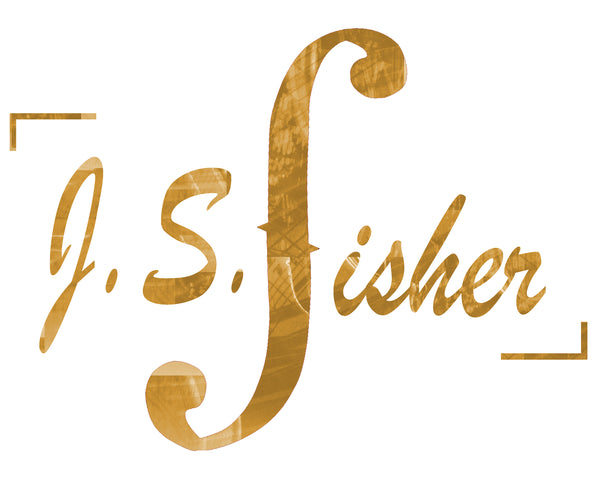
Item added to your cart
Violin bows.
Arcos Brasil Arcus CodaBow Core Select JonPaul
At J.S. Fisher Violins, we specialize in helping players to find their ideal violin bows. We offer a curated selection of the best new pernambuco, ipe, and carbon fiber bows available. Contact us today to arrange your free consultation or in-home bow trial .
Bows for Professionals (Classical)
For the professional seeking a primary bow for orchestral or studio work, a fine wooden bow is something to consider, particularly if a darker sound is desired (pairing with a brighter instrument). For professionals seeking greater power, dynamic range, or agility, a carbon fiber bow may be a better fit. Much depends on the instrument and the player's tastes and priorities. We invite you to contact us to arrange a time to talk by phone. We've been matching professionals with their ideal bows for many years - let us share our experience and guide you in your selection.
For any player struggling with tendinitis or arthritis, a lighter Arcus bow may help tremendously with hand/arm fatigue and pain.
For professionals seeking a bow for outdoor work, for international travel, or as a backup bow, a mid-priced carbon fiber bow can be an excellent choice.
Fine Wooden Bows
For the player seeking a fine, traditional, pernambuco or ipe wood bow.
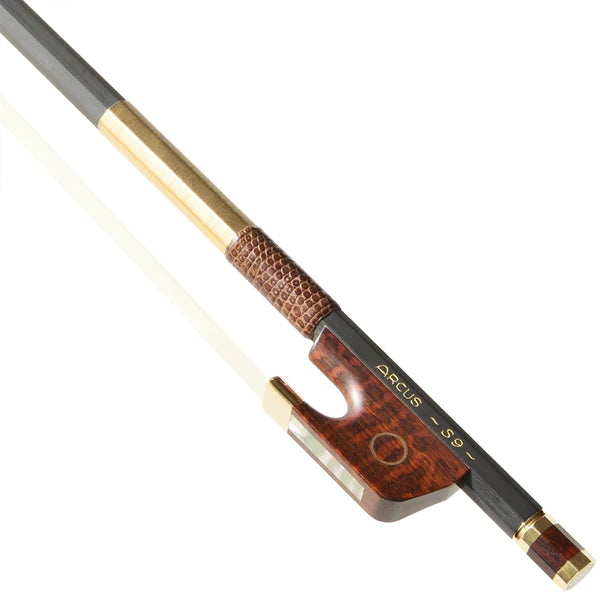
Arcus Violin Bows
Modern bows for the professional player. The strength and lightness of Arcus bows results in a speed and agility simply not possible with traditional bows. Multiple lines available to match the tonality of your particular instrument. Nuanced, unparalled performance.
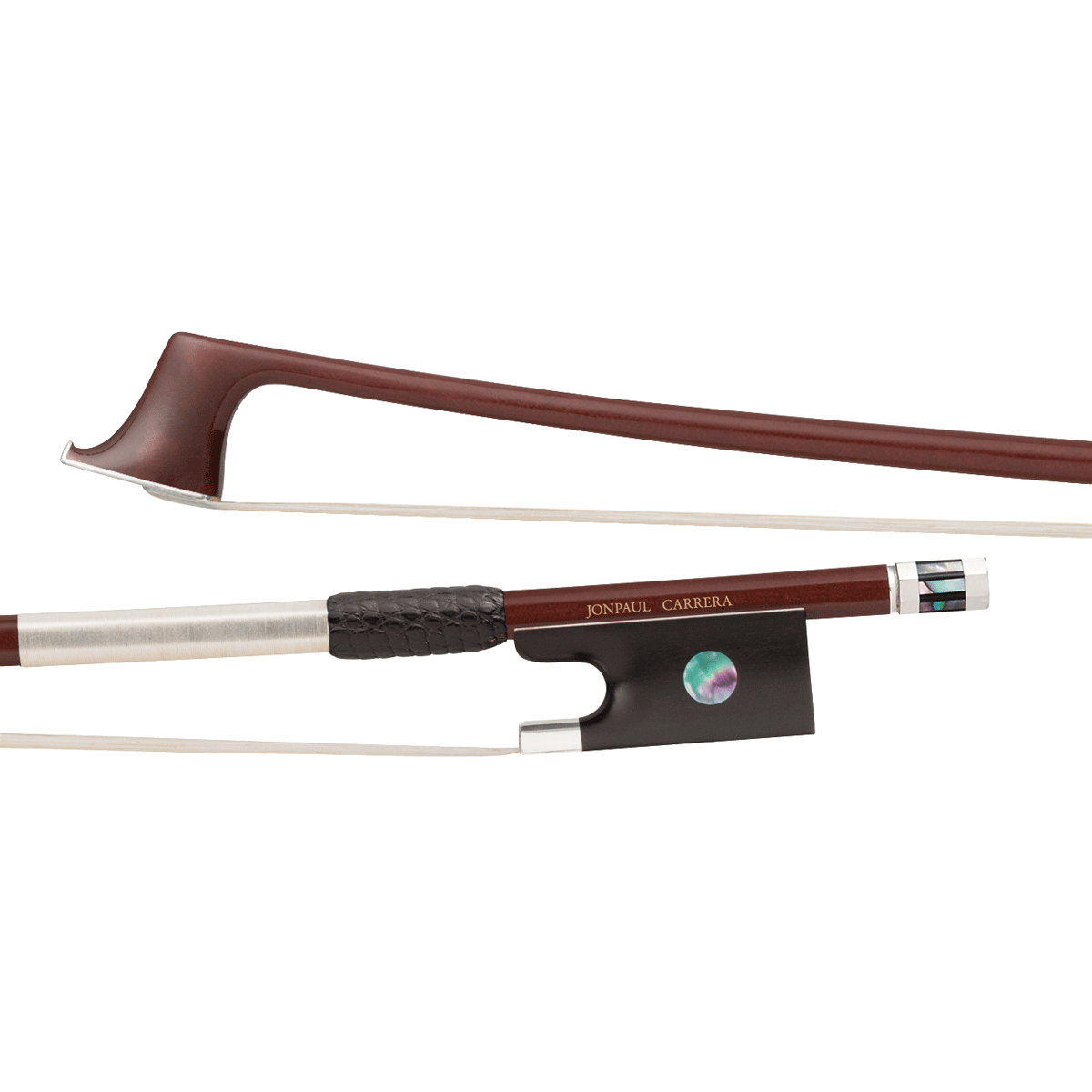
JonPaul Carrera Violin Bow
For professionals seeking a traditional weight and balance in a high-end carbon fiber bow, our first recommendation is the JonPaul Carrera. Superb handling. Beautiful, complex, warm tone.
Bows for Fiddlers
For fiddlers, quickness, agility and the ability to project tend to be the priorities. And, fiddlers often use different strings and seek a different kind of tone than classical players. It makes perfect sense then that fiddlers would be drawn to different bows. Wooden bows can still a good choice, but high-end carbon fiber bows are extremely popular for their greater power, and faster articulation.
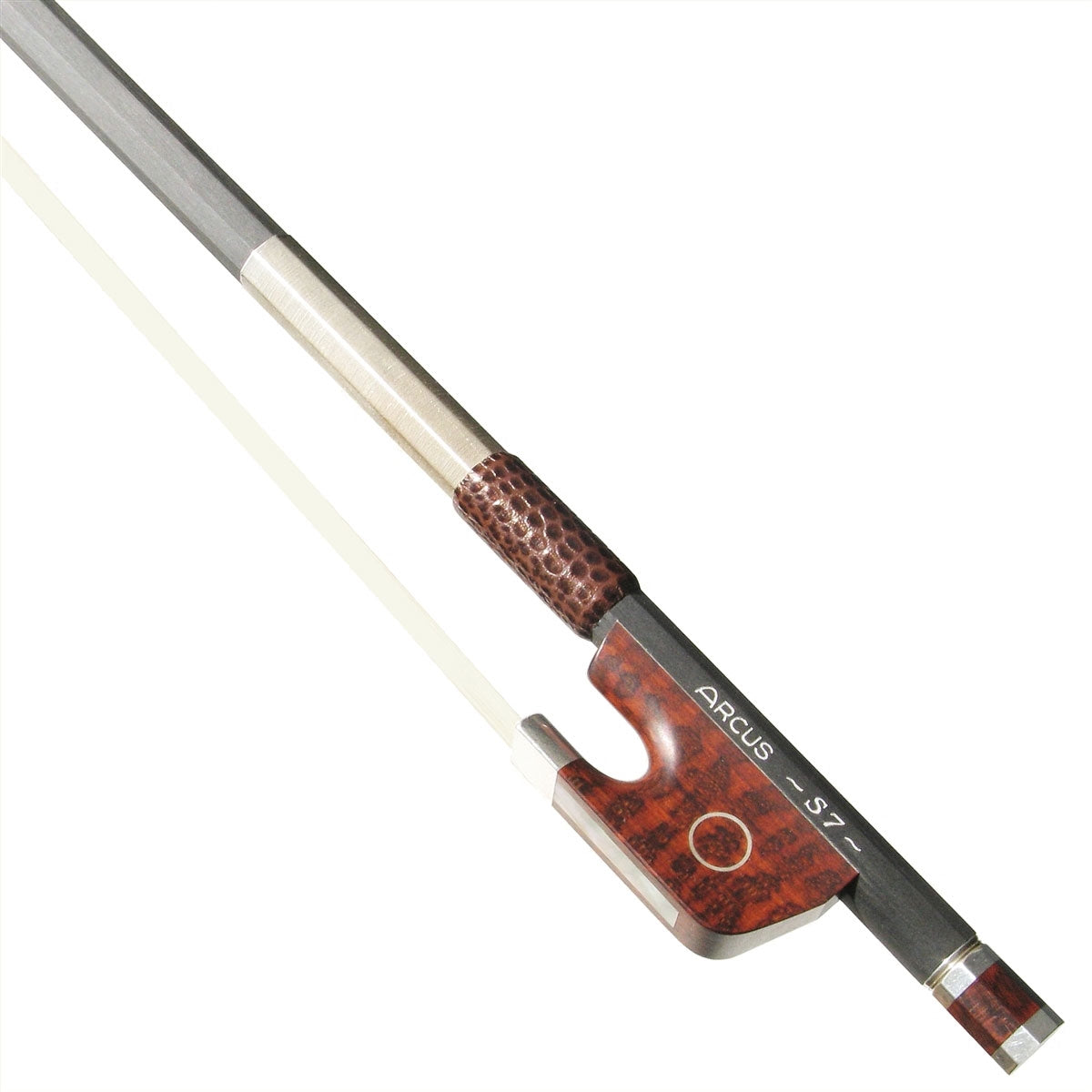
Arcus bows are much lighter and stronger than traditional pernambuco. They are, therefore, extremely popular with fiddlers for their greater speed, agility, and projection. Contact us to arrange a bow trial - we'll assist you in selecting the right line of Arcus bows to match the tone of your fiddle.
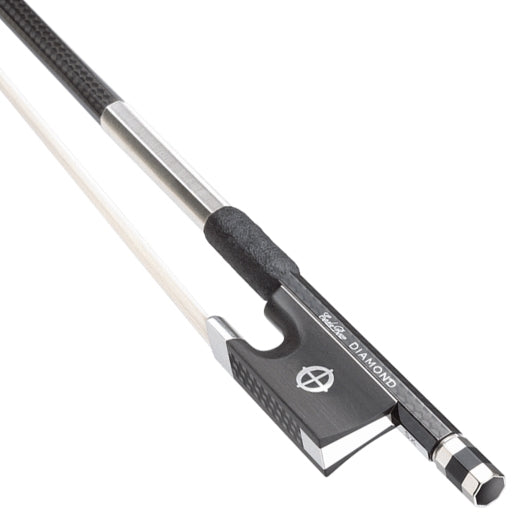
CodaBow Joule Violin Bow
If you prefer a more solid feel to your bow and a traditional weight, but still seek agility and a quick articulation, the CodaBow Joule will be an excellent fit. Originally designed for 5-string electric violin, the Joule is a fiddler favorite (on acoustic instruments). It offers a fast attack and a lively bounce.
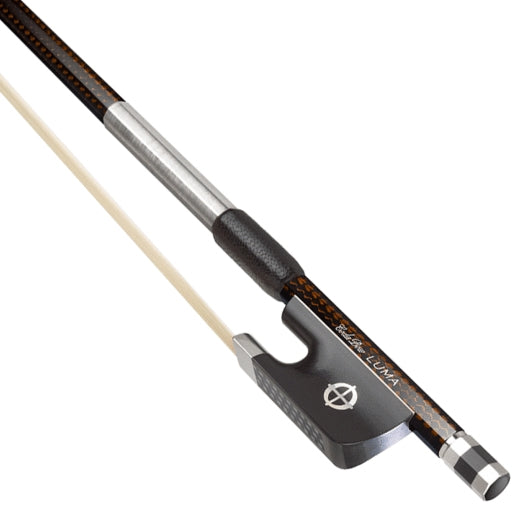
CodaBow Luma Violin Bow
On the other hand, some fiddlers aren't looking for agility. If you're an old-time fiddler who plays a basic, on the string bow stroke, with little bounce and little need for fast articulation, then you may prefer a lighter bow that offers a slower, softer, attack. For you, we recommend the CodaBow Luma.
Bows for Advancing Students
The advancing student will require a bow agile enough for difficult bowing techniques and versatile enough to allow for a wide range of dynamics.
One of our best-selling bows, the Carrera is an advanced carbon fiber bow with exceptional handling. It also draws a beautiful tone and matches well with a wide range of instruments. Suitable for professionals and advancing students.
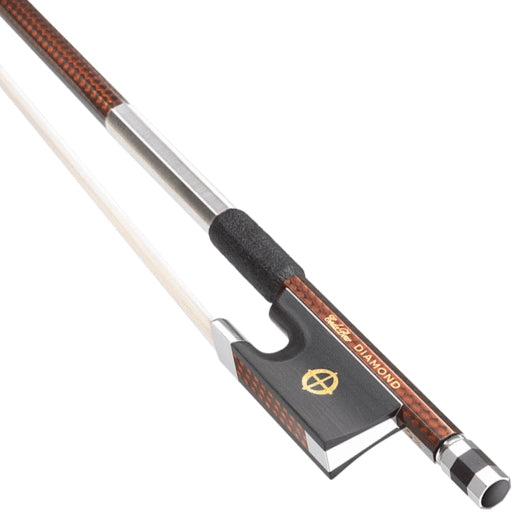
CodaBow Diamond GX Violin Bow
The rich, powerful tonality of the Diamond GX, combined with excellent overall handling, makes this a best-in-class option for bows in this price range. An excellent value.
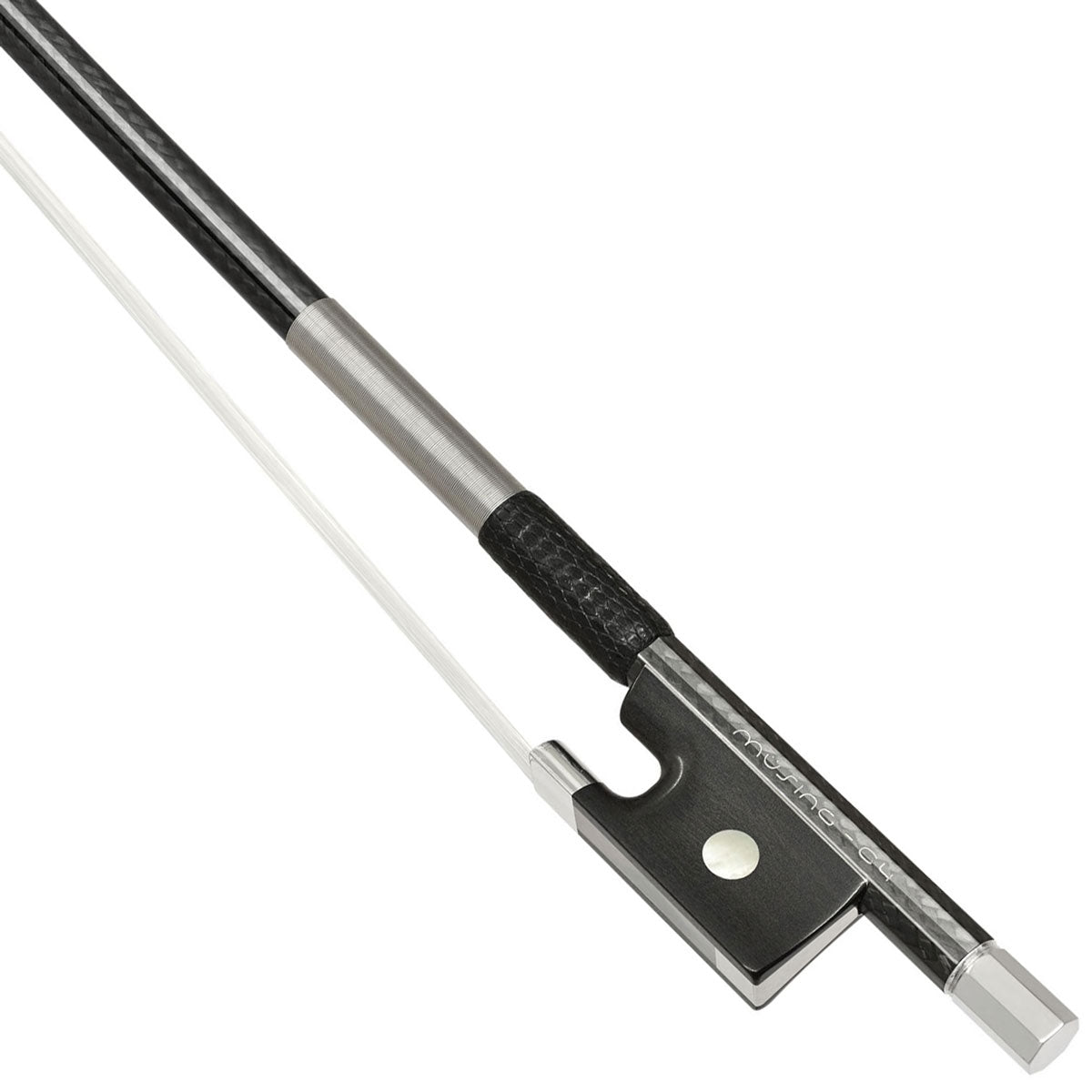
Arcus Musing Violin Bows
Although Arcus bows are generally recommended for professionals, the Musing line has been specifically designed for advancing players. The light weight and exceptional strength of these bows offers a speed and agility simply not possible with traditional bows.
Bows for Beginners
The beginner will benefit from a bow that feels solid and stable in the hand (tip-heavy) and has a soft, forgiving attack. Beginners should avoid cheap bows that may be warped, twisted, or overly-flexible, bows with a sharp, bright attack (that would emphasize squeaks and squawks), and ultra-light bows that require a professional's hand to keep stable. Often, a good quality carbon fiber bow will be the best choice.
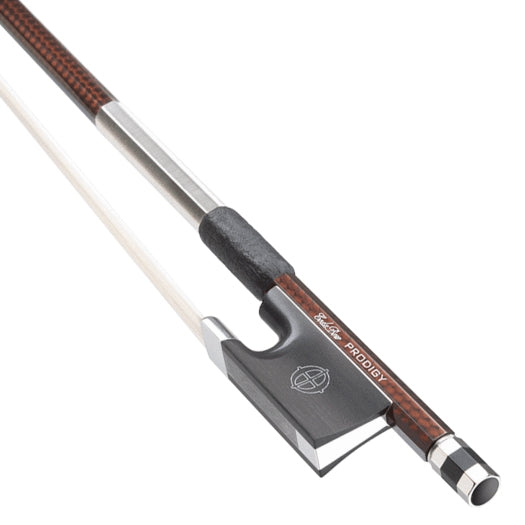
CodaBow Prodigy Violin Bow
A significant step up from the typical beginner bow, the Prodigy has a balance and handling that allow beginners to learn proper bowing technique from the start. Stable feel, easy handling.
Arcus Brasil Nickel Violin Bow
Fine craftsmanship, well-balanced, straight, pernambuco bow, suitable for beginners and advancing students
The Luma has a smooth, forgiving articulation that students love. The softer, lusher attack helps reduce squeaks and squawks. Lighter and more agile than the Prodigy, the Luma is also a popular bow with professional fiddlers.
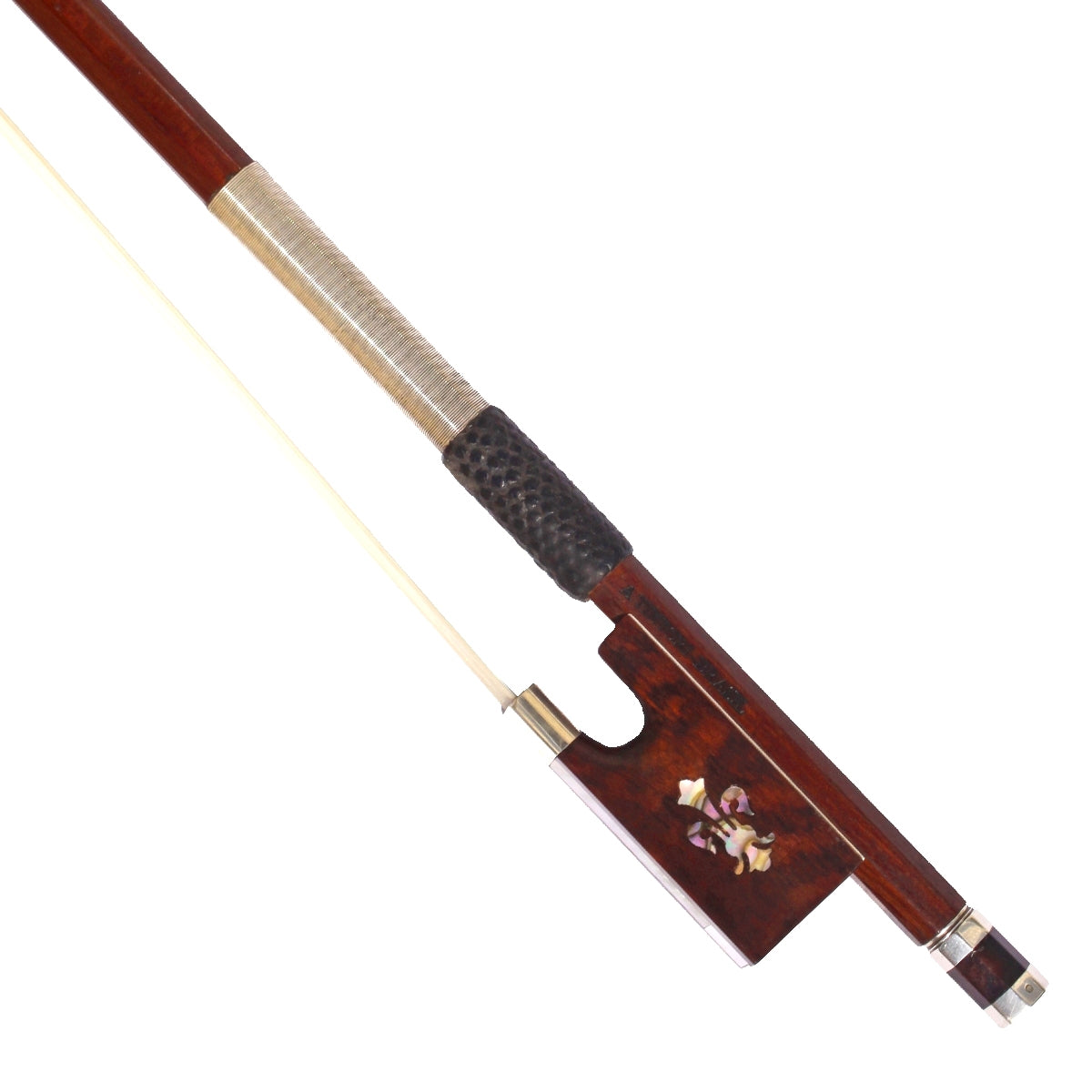
Arcos Brasil
Traditional, Wooden (Pernambuco) Violin Bows of Exceptional Quality.
Hand-crafted in Brazil from select, aged, Pernambuco wood, Arcos Brasil is well known for the quality of their materials and the extraordinary level of fine craftsmanship they bring to each and every bow. Beautiful, warm, complex, nuanced tonality.
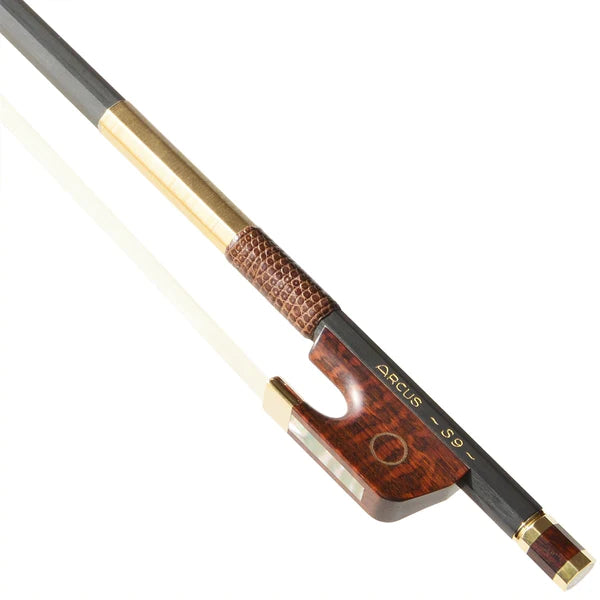
Light-Weight Carbon Fiber Violin Bows for Professionals - Lightweight, Powerful, and Lightning-Fast
Extraordinarily lightweight, these bows have an agility and speed simply not possible with traditional bows. They produce a beautiful, complex tone. But, the real draw is how they feel in the hand and how they touch the strings. Particularly with the upper level Arcus bows, the performance is clear, smooth, and effortless. They also have the advantage of allowing the player to practice or perform for hours with little hand and arm fatigue (since the hand has much less weight to hold). A must-try bow for all professionals.
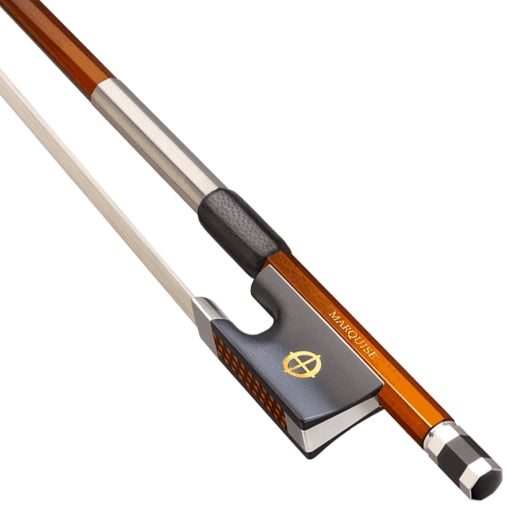
Carbon Fiber Violin Bows for Professionals and Students - Responsive and Well Balanced
CodaBow bows are meticulously crafted in a small shop in Minnesota, under the direct supervision of the company's founders. Outstanding quality. Perfectly balanced, agile, with a beautiful, complex tone. A variety of models, designed for beginners and professionals. CodaBow is one of the only makers to produce bows designed specifically for the needs of fiddlers and folk players (Joule and Luma Models). We highly recommend.
World Class Carbon Fiber Violin Bows for Professionals & Advancing Students
JonPaul makes wonderfully responsive carbon fiber bows. A bit more flexible than CodaBow models, the JonPaul Carrera, in particular, has consistently received excellent reviews. Excellent balance, response, and tonality. Other models available by special order.
Fine Wooden Violin Bows
There is a joy in crafting a bow from fine wood, and each bow is as unique as the wood from which it was made. Fine wooden bows tend to produce a warm, rich, complex tone that suits a wide range of instruments. Wooden bows match especially well, tonally, with relatively brilliant sounding fine instruments instruments, and with inexpensive student instruments that also tend to be rather bright. Fine wooden bows also tend to respond to the player's motions - i.e. changes in bow speed, pressure, angle, etc., with corresponding changes in tone color, allowing the player a nuanced range of expression. This is often true of even quite modestly-priced wooden bows . However, wooden bows are limited to the strength and weight of wood, and therefore can not be made as lightweight or as resilient as fine carbon fiber bows.
Carbon Fiber Violin Bows
The craft of making bows from synthetic materials has seen extraordinary advances. Of course, there are still poorly made carbon fiber bows, just as there are poorly made wooden bows. And, these cheap bows tend to give the carbon fiber industry a bad name. But, there are also carbon fiber bows available today with beautiful, complex tonal characteristics. The modern player can now choose from a wide range of carbon fiber bows. Some produce dark, brooding tone colors and pair well with brilliant sounding violins. Others produce a fantastically brilliant, projecting sound that pairs wonderfully with darker sounding instruments.
Carbon fiber is lighter and more resilient than wood. Indeed, our professional customers are frequently surprised, not just about the beautiful tone of these bows, but at the power, speed, agility, and ease of play, that is simply not possible with traditional materials. Among students and teachers, carbon fiber has found a strong following, since fine bows can be consistently produced at a reasonable cost. CodaBow in particular produces wonderfully made, well-cambered, responsive bows, at a great price.
The key for the buyer, with so many bows available with such varying characteristics, is to find the bow that matches well to your instrument and style. We specialize in helping our customers to do just that. Contact us now for a free consultation and a bow trial .
Brazilwood Violin Bows (i.e. Cheap Wooden Bows)
The term "Brazilwood bow" (technically a bow made from Brazilian tone wood) more commonly refers to any inexpensive wooden bow. These can be suitable for students, but often have mechanical problems such as warp, twist, or overly-flexible or overly-thick shafts, which make them difficult to play. They are commonly used in student rental programs, simply because they are so inexpensive. Note that Pernambuo is a Brazilwood, but the term has traditionally been reserved for bows made from higher-quality wood. These days, there are many bows being marketed as Pernambuco that would not measure up to our standards. We are very particular about what we sell as Pernambuco.
Characteristics of Violin Bows
- Straightness - Warp, Twist: These types of problems are quite common in cheaper bows, and can cause significant problems for the player.
- Stiffness - Strength, both toward the strings and side to side - A stronger, stiffer stick allows the player to increase pressure on the string without breaking the sound; it increases the upper end of the available dynamic range. However, all things being equal, a more flexible shaft will yield a warmer , rounder timbre. An overly -flexible bow (common with cheap bows) will be difficult to play properly, particularly if the bow is too flexible in a side-to-side direction, preventing the player from tilting it to a proper angle. The highest quality Pernambuco wood is prized for its ability to produce both a full round tone and, simultaneously, allow the player to dig powerfully into the string, without the sound breaking.
- Camber - A bow's camber refers to its curve toward the strings. A quality bow will curve gently and evenly toward the mid-point of the playing length of the bow. Poor quality bows may have kinks or flat spots where the curve is uneven, or may curve to a point other than the middle of the bow. A quality bow will also have the proper amount of camber, with the curve (when not under tension) arcing just enough to touch the hairline. A bow with uneven camber will have dead spots and an uneven sound. A bow with too little camber will be weak and difficult to play.
- Weight & Balance - Weight and balance are separate, but related characteristics. The balance of a bow greatly effects the player's perception of its weight. A bow weighted toward the tip, for example, will feel heavier to the player. In terms of actual weight, a bow that is lighter will generally be faster and easier to handle, because there is less mass to move around and to vibrate. Heavier sticks tend to have a fuller sound, but can be more cumbersome to handle. Players have their own preferences for both weight and balance, and there is no correct measurement for either. Note that many players who think that they like a heavier or lighter bow, are actually referring to their preference for a tip-heavy or tip-light balance, rather than a preference for actual weight. It's also worth noting that lighter bows can be helpful for players with tendinitis or arthritis. Extremely light bows may allow the professional greater agility, but will require greater skill to control and keep steady.
- Quality of Attack - By attack we refer to the way the bow interacts with the string at the start of the bow stroke. Both the sound quality and the speed of the attack are important playing characteristics. A bow the speaks more quickly can be very desirable when fiddling or playing demanding classical passages. A bow with a very clean, smooth, attack is advantageous for all players, but particularly for beginners. To a great extent, the highest quality bows are sought after for the ease with which they cleanly and beautifully articulate each bow stroke. A fine bow articulates so effortlessly that it feels as though it plays itself . Note that aside from the characteristics of the bow itself, the way a bow articulates is greatly effected by the choice of rosin and the quality and age of the bow hair.
- Tone Quality - Quality of the Sustain - This is often the first thing that players listen for when purchasing a new bow. It is the most obvious (though, perhaps, not the most important) aspect of a bow's overall quality. How does the bow sound when playing long, sustained, tones? Is the overall quality of the sound pure and open, or more nasal and pinched? Note that the quality of the sound that carries to the listener is often quite different from what the player hears under the ear.
- Tone Color - Does the bow produce a dark, warm tone or does it have a more brilliant quality? Brighter sounding bows are preferred by soloists for their power and clean articulation, but can also accentuate the harsher more sibilant qualities of the sound. A darker/warmer sounding bow will accentuate lower frequencies, but can run the risk of sounding dull or muddy when articulating.
- Dynamic Range - How powerful is the bow; can the player draw out rich, full, powerful sounds? How does the bow respond to a lighter touch; how softly can the player play and still produce a clean tone? How do the tone colors and the quality of the tone change with various dynamics? How well does the bow articulate at various dynamic levels?
- Agility/Liveliness - How easily can the player handle the bow? How well does the bow bounce? Do you like how it feels when playing off the string with a more brushy stroke? How does it handle when playing spiccato or sautille'?
- Directional Changes - How easily are the bow's directional changes accomplished? How do they sound when playing legato, detache'?
- Overall Palette - Does the bow offer a wide range of tone colors and articulations, altering with changes in pressure, speed, vibrato? Poor bows sound pretty much the same, no matter how they are played. Fine bows respond to the players motions with a range of colors and sounds. How expressive does the bow allow the player to be?
Violin Bow Hair
A wide range of horse hair is available for bows. For classical violinists, fine hair form Mongolian or Siberian horses is most common. Fiddlers often prefer somewhat coarser hair and sometimes enjoy a ribbon of mixed white and black hair (salt & pepper). Professionals seeking supreme hair with the richest, most complex tonality and articulation, sometimes seek out very fresh, Siberian stallion hair. The age/freshness of the hair can be gauged by how far it will stretch without breaking. (A strand of supreme, very fresh hair can be stretched full inches without breaking.) But, such hair is more strongly affected by changes in humidity (making the bow unable to tighten in humid weather, or unable to loosen in dry weather). It also stretches considerably over time, while on the bow. As such, it can be problematic for players and must be replaced rather more frequently than the usual hair available in shops.
Hair should be replaced or cleaned regularly - every 6-12 months as a general rule, though professionals often replace hair more frequently. If hair is missing or the bow cannot be tightened properly due to the hair stretching, then a rehair is necessary. If the hair is simply dirty, cleaning it will restore vitality and tone.
- Choosing a selection results in a full page refresh.
- Opens in a new window.

A Musician’s Tips for Traveling with Your Violin

Traveling any distance with your violin could lead to damage if your instrument isn’t properly packed and cared for along the way. So should you leave it behind? No way!
Whether you’re traveling over the hills and through the woods to grandmother’s house or just around the corner for a gathering with old friends, you can use these tips to make sure your violin and bow arrive at your destination undamaged and ready for a song.
Learn how to travel with your instrument and pack your violin for air or road travel!
How to Travel with a Violin by Air

Check your insurance coverage.
Is your violin covered under your homeowners or renters insurance policy? It might be. Call your insurance company to check coverage and limitations. Surprises and accidents are just as likely on local trips as on international ones! You can also purchase an independent violin insurance policy that covers everything from accidental damage to theft.

Leave your bow at home if it is made with ivory or tortoise shell.
Your bow could be confiscated at the airport if it contains ivory or tortoiseshell, as these are banned materials. If you must travel with a bow featuring ivory or tortoiseshell, apply for a CITES (Convention on International Trade in Endangered Species) certificate. A CITES certificate provides proof to customs that all materials from protected species used in the bow were either legally acquired or used at a time when the material was not yet protected. A CITES certificate is valid for three years.
On the flip side, a negative certificate or materials declaration from the bow’s manufacturer can serve a similar purpose in proving there are no materials on the bow from a protected species. Contact CodaBow for a materials declaration for any CodaBow violin bow .
What about Pernambuco bows? Traveling with a finished violin bow made from pernambuco wood is alright, reports the American Federation of Musicians . “You do not need documentation to travel with bows containing pernambuco wood as long as these instruments do not also contain ivory or other endangered species material.” The Federation recommends bookmarking or printing this letter from the U.S. government in case your TSA agent or airport official is unaware of this allowance for pernambuco wood bows.
Plan for extra security screening.
Allow time in your travel schedule for extra security screening. Assume that your violin case will be opened and inspected by a TSA agent (and that the agent may need to learn how to handle a violin and bow properly).
“Musical instruments transported as carry-on require a physical inspection at the security checkpoint. Inform the TSA officer if your instrument requires special care and handling,” reports TSA .
Invest in a sturdy violin case.
Avoid traveling with a soft-cover violin case that can’t bear much weight. You need a protective, durable, and weather-resistant case. Once you put your violin in an overhead bin, another airplane passenger could sling their suitcase into your instrument or place a heavy bag on top of it.
Check out these top violin cases for traveling from Great Violin Cases. No matter how sturdy your case is, you can also add padding to limit jostling. Just put a little bubble warp around the neck, bridge, fingerboard, tailpiece, and between the sides of the violin!
Loosen your violin strings and bow hairs.
Loosen your violin strings and bow hairs to avoid breakage. At flying altitude–even in a pressurized cabin–the tension in your violin strings can increase and damage the instrument’s body. This travel tip applies when traveling with any stringed instrument, not just a violin!
Buy a humidifier.
Airplane cabins are notoriously dry. You’ve felt the effects of it, too! The dry air dehydrates your skin and body, causing dry skin irritation, thirst, and headaches. Your violin can also “dry out,” fall out of tune, and crack.
With the help of a violin humidifier, your instrument can better maintain its integrity and be kept in the 45-55% humidity range. Violin humidifiers range in price from $10-$100. Consider removing the humidifier from the case once you reach your destination, especially if you’re traveling to a humid climate.
Note that changes in humidity aren’t as big of a deal if you have a carbon fiber bow as opposed to a wooden one . Humidity and temperature swings can change the camber of a wood bow, affecting the sound of your playing. A carbon fiber bow, however, is engineered to hold its shape no matter what.
Avoid putting your violin in checked baggage.
Sure, the plane’s baggage hold is pressurized and temperature controlled. One travel website reports that temperatures are held between 45-65℉. But your violin could be thrown about and damaged by baggage handlers along the way, and violins are genuinely happiest in the 60-70℉ temperature range .
Check-in early, and don’t be the last one on the plane.
This tip is crucial for musicians traveling on Southwest, where the seating is first come, first served in designated groups. Airline staff could start checking or moving bags to the cargo hold as overhead compartments fill up. You don’t want your instrument case to find its way down there, and you don’t want to make another passenger check their luggage because you were the last one to board, and now there’s no room for your violin case in an overhead bin. Board as early as possible and pay attention to your nearest overhead compartment.
How to Travel with a Violin by Car

Driving with your violin is much easier than flying! You control almost every aspect of your trip, from temperature to luggage setup.
- Similarly to flying with your violin, loosen the strings and bow hairs before hitting the road to prevent expansion and contraction damage.
- Don’t put your instrument in the trunk where it could get jostled about or crushed by other luggage.
- Go with a durable, weather-resistant case.
- Don’t leave your instrument in the car overnight. Consider taking it with you when leaving the vehicle if the A/C or heat will be off for more than 30 minutes.
- Again, check your insurance coverage!
Is Your Violin Ready to Travel?
With the proper preparation and care, your violin can fly or drive with you to any destination. Carbon fiber violin bows are especially well-suited for the rigors of travel and fluctuating temperature and humidity levels. Upgrade your bow (right alongside your violin case!) to one that’s more durable and reliable than your average violin bow. Request an at-home trial of a carbon fiber bow today, and get ready to pack your bags. CodaBow is there for you with some of the most durable and highest-quality violin bows. Feel free to sign up on our email list for additional information for top orchestral instrument traveling tips.
Fill out the form below to get the download and learn more!
Since pioneering the original carbon fiber bow, CodaBow’s master makers and leading scientists have created award-winning bows for players of every style, station, and aspiration. Generations of players throughout the world trust their performance to CodaBow.
Search In-Home Trial Register Your Bow Contact Us Warranty Information Policy Careers
Stay Connected
© 2024 Codabow
Need your CodaBow serviced? Receive Exploratory bows during your service so you never have to miss a beat!
My shopping cart
Your cart is currently empty.
Master the Holidays Sale: Get 15% off the Master Collection
Experience CodaBow like never before! We are in the holiday spirit and offering 15% Off our Master Bow line for the first time ever. Whether you are looking for the classical elegance of the Marquise GS or the swift power of the Aero, this is an opportunity you won’t want to miss!
Click here to shop our Master the Holidays Sale now!
Diamond SX Violin
The ultimate gigging bow, now available as a customizable Chroma Experience!
Customize This Bow
Please allow up to 10 days for all custom orders.
With a traditional design, the CodaBow Diamond SX carbon fiber violin bow offers a more focused, brighter tone. A subtle frog-ward shift of the balance point and engineered facility delivers a livelier violin bow frequently sought-after by professional players. The CodaBow Diamond SX has a modern, sleek black finish that hints at its sophistication, and its focused timbre is excellent for both outdoor venues and those with difficult acoustics. Built for traveling or gigging musicians, the CodaBow Diamond SX violin bow is the top choice for anyone seeking durability without compromising professional performance.
Purchase this bow from CodaBow.com to receive free shipping and 30-day risk-free return.
Your Go-To Violin Gigging Bow
Blended acoustic core.
A pressure-infused Blended Acoustic Core utilizes a distinct blend of both Kevlar and S-Glass that offers a natural sensitivity unattainable with carbon fiber alone and a nuanced tone rivaled only by the finest Pernambuco.
Diamond Weave
This violin bow uses graphite fibers, woven with precision in our exclusive pattern, spanning from button to tip, achieving the highly sought balance between flexibility and strength.
Built for a Lifetime of Play
All components subject to high wear (such as the tip plate and wedge and button bearings) on the CodaBow Diamond SX violin bow are precision-made with cutting-edge composite materials to bring a lifetime of enjoyment, worry-free.
Xebony® Frog Solution
The world's supply of instrument-grade ebony is endangered. Xebony® is an exclusive combination of natural fibers and resin with a stunning sheen and natural grain, impressing players and violin bow makers alike. Xebony® stronger and more durable than natural ebony, and offers peace of mind while contributing to the preservation of endangered resources.
Travel Internationally with Ease
The GlobalBow® designation on the CodaBow Diamond SX violin bow ensures that each carbon fiber bow we make contains no endangered, monitored, or regulated species (flora or fauna) and can pass worry-free through international Customs.
Want to set up an In-Home Trial?
Fill out the form and be connected with a CodaBow team member.

Vegan options available upon request. Contact [email protected].
Customer Reviews
Sign up for our newsletter.
Sign up for our email list to stay up to date on all things CodaBow.
© 2024 CodaBow | Powered by Shopify
- American Express
- Diners Club

- Date: December 29, 2020
- Posted In: Violin
Best Violin Bows (2023 Buyer’s Guide)

- By Hannah Frey
I’m a professional violinist and teacher, and I’ve been playing the violin for over 30 years. People often ask me a variety of questions about bows, including, what’s the best violin bow to buy?
The first thing to do is to make sure you have a violin that you love, and then you’re ready to look for a bow. You want to find a bow for your violin, not the other way around.
Quick Look: Best Violin Bows
★ #1 Best Violin Bow Overall: CodaBow Diamond SX ★
- Best Cheap Violin Bow: Fiddlerman Carbon Fiber Violin Bow
- Best Violin Bow for Beginners: Fiddlerman Carbon Fiber Violin Bow
- Best Violin Bow for Intermediate Players: CodaBow Diamond SX
- Best Violin Bow for Professionals: JonPaul Avanti Carbon Fiber Bow
- Best Carbon Fiber Violin Bow : CodaBow Diamond SX
SEE THE FULL LIST
I’ve put together some information on what to look for and created a list of some of the best violin bows out there. I tried to include a good range of prices, so no matter what your budget is, you’ll be able to find the best bow for you.
- What Is a Violin Bow?
A violin bow is necessary to play the violin unless you just want to pluck your violin like a mandolin !
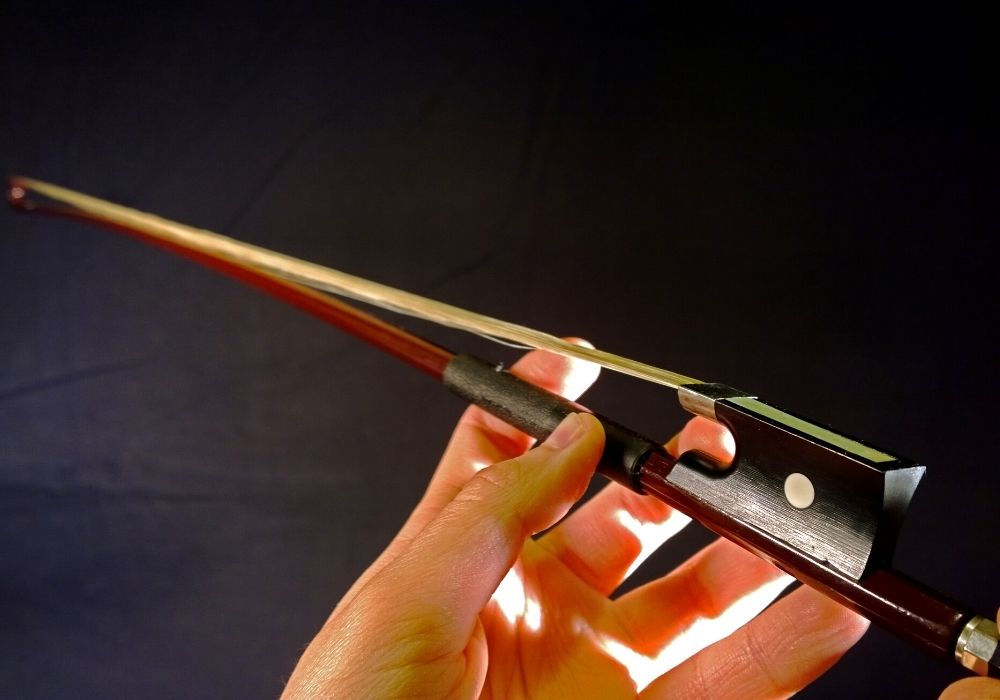
Most beginning violin sets are sold with a bow included, but you may need a new bow or wish to upgrade to a better one. You may also want to have an extra bow on hand in case of an emergency.
- Types of Violin Bows
There are two main kinds of bows, wood and carbon fiber. Traditionally all bows were made of wood, but these days many of the top violin bows are made of carbon fiber.
There are a few bows you’ll see made of materials such as fiberglass or other composites. These bows are usually the cheapest of the cheap, and I generally don’t recommend buying a bow made of those materials. You definitely want a bow with real horsehair as well.
There are other parts of the bow made of different materials that I’ll talk about later, but keep in mind that we’re talking about the “stick” part of the bow when we talk about wood or carbon fiber. This affects the weight, balance, and sturdiness of the bow.
Wooden bows are more traditional and how violin bows were made for hundreds of years. The highest quality and most expensive wooden bows are made of pernambuco, which is a Brazilian wood that’s endangered.
Some bows are made of other woods such as sandalwood or brazilwood, which are cheaper woods that are easier to come by than pernambuco. If you’re looking at a bow made of different wood, consider the quality of the craftsmanship and look at the reviews.
Carbon Fiber
These days many bows are made of carbon fiber. I often recommend carbon fiber bows to my students because they’re sturdier than wood and often have a better quality for the price.
Carbon fiber is better for changes of humidity and temperature that wood is more sensitive to, and it won’t break as easily if you drop it. Many carbon fiber bows are made to exact specifications and are well balanced and sensitive to play.
Fiberglass or Composite
Some cheap bows are made of fiberglass or another synthetic composite material. These bows are often the cheapest bows and not easy to make a good sound with.
- Things to Consider When Choosing a Violin Bow
There are a variety of factors to consider when you’re looking for a violin bow. You’ll want a bow that feels good in your hand, that’s well balanced (this affects how easy it is to use), and that’s well made.
You’ll want to be able to play in a variety of bow strokes and be able to easily play in different dynamics and on and off the string if you know how to do that. A beginner doesn’t need the same kind of bow as an advanced player, but a beginner still needs a good quality bow.
As with violins, bows come in different sizes. If you play on a 1/2 size violin, you’ll need a 1/2 size bow. Occasionally a player will use a bow that is one size up from their violin, but this is pretty rare and only done with a teacher supervising.
You’ll want to make sure that you can care for your bow properly, which means when you aren’t playing it, you’ll keep it in the case or hang it on the wall or violin stand. If you’re the sort of person who’s hard on bows, make sure that you consider a sturdier bow that’s made of carbon fiber rather than an antique wooden bow.
You can expect to pay between $50 and $1,200 for a decent violin bow. You can also spend, as with violins, many times more money and get a beautiful, one-of-a-kind handmade bow. I won’t even tell you how expensive the bow I use most is.
However, you’re likely here because you’re looking to buy an affordable but good quality bow, and you’re looking for the best bow you can get without breaking the bank or selling your house. That means getting a bow that’s part of a line of bows and knowing the best one for that parameter. You’ll pay as little as $50 and upwards of $1,000, with many great options in between.
- 5 Best Violin Bows
1. Fiddlerman Carbon Fiber Violin Bow
- Size: 1/16 up to full size
- Weight: (full size) 60-64 grams
- Material & finish: Carbon fiber bow, real horsehair, leather grip
- Best for: Beginner and intermediate violinists
The Fiddlerman Carbon Fiber Violin Bow is a great budget bow for beginning and intermediate violinists. It’s excellent quality for the price and comes with a warranty as well.
Why I Recommend It
For a beginning level bow, this is a fantastic bow. The reviewers are so happy with it, and it’s just a good all-around bow.
VIEW ON AMAZON
2. CodaBow Diamond SX Violin Bow
- Size: Full size only, 29.5 inches long
- Weight: 60-61 grams
- Material & finish: Black carbon fiber, graphite diamond weave, XEBONY frog
- Best for: Advanced to professional level players, those who traveling, playing outside
The CodaBow Diamond SX is the best all-around bow made by CodaBow. I highly recommend bows by CodaBow, and they have more options than this one. So, if you like the look of this bow but want something a little bit different, you can find that too.
In case you can’t tell, I really love the CodaBow Diamond SX. This is a bow I play on my viola, and it works as well as far more expensive wooden bows. You can’t go wrong with this bow if you have the budget for it.
VIEW ON FIDDLERSHOP
3. Holstein Sandalwood Violin Bow
- Size: 1/4- full size
- Weight: N/a
- Material & finish: Sandalwood, ebony frog, horsehair, leather wrapping
- Best for: Beginners who prefer a wooden bow
The Holstein Sandalwood Violin Bow is a budget choice for beginners who want the feel of a wooden bow without sacrificing any quality. It’s a bow you’ll grow out of, but it’s a solid choice if you’re towards the beginning of your violin journey.
I wanted to include at least two wooden bows on my list, and this is a good quality budget option. It’s also good that it comes in a variety of smaller sizes, as many people start playing the violin quite young and take years to grow into a full-size violin.
4. JonPaul Avanti Violin Bow
- Size: Full size only
- Weight: 62-63 grams
- Material & finish: Reddish-brown carbon fiber, silver tip and mountings
- Best for: Advanced to professional players
The JonPaul Avanti Bow has an almost cult following, and it’s a good bow for professionals who want a quality bow for a carbon fiber price. It’s made to look similar to wooden bows, so you can sneak it into a serious setting and no one will know it’s not wooden.
I haven’t played this bow myself, but many trusted colleagues highly recommend the JP Avanti Bow. Like for many top quality carbon fiber bows, you’d have to pay two or three times as much (or more) in order to get as smooth and balanced of an experience from a wooden bow.
5. DZ Strad Model 524 Violin Bow
- Size: Full size
- Weight: 62 grams or so
- Material & finish: Brazilwood bow, polished ox horn frog, real horsehair
- Best for: Beginners to intermediate players wanting a real violin bow
The DZ Strad Model 524 Violin Bow is a solid quality wooden bow for beginners and intermediates players It’s advertised as completely handmade, so there will be variations from bow to bow.
DZ Strad bows are good quality violin bows for beginning and intermediate students. If you want a wooden bow, this is a good one to get, which is a possible step up from the Holstein.
Best Violin Bow Brands
As you might expect, some companies have a better line of bows than others. Oftentimes, the best bow company is one that only makes bows, so they can really specialize. In other cases, the brand makes violins and other products as well.
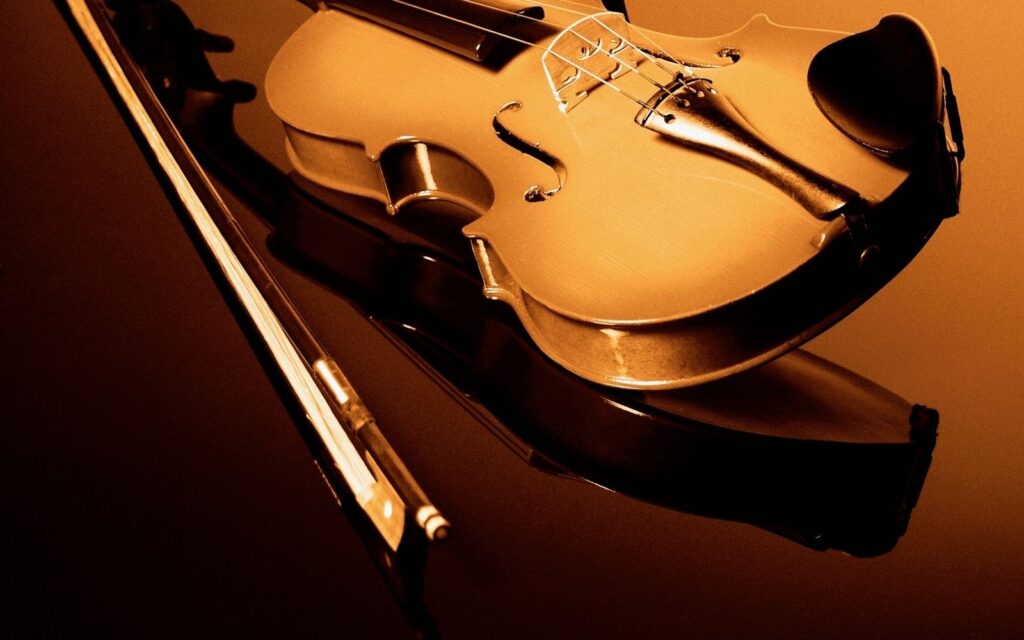
CodaBow is the oldest carbon fiber bow company, making bows from 1958 on. They have a high quality of craftsmanship and a huge variety of bows to try out. I recommend trying several different bows and choosing the one you like best.
Arcus is an Austrian company that started making carbon fiber bows in 1999. Their bows tend to be lighter and more agile than other carbon fiber bows, and are worth checking out.
DZ Strad makes violins, violas, and cellos as well as bows. They also sell cases and other accessories. They have good quality and great customer service.
Holstein is a family-run company that works with international makers and workshops to make their products to exacting specifications.
- Violin Bow Aesthetics & Build
Different bows look different and are made of slightly different materials. I’ve mentioned some of this already, but there are a few things I haven’t talked about yet.
I’ve already talked about carbon fiber versus wooden bows, but let me reiterate. Wooden bows are more traditional and some players swear by them, that nothing matches the sound.
Carbon fiber bows vary from brand to brand and from model to model, but generally are cheaper than wooden bows. Therefore, you’ll get a better quality bow for the price. You’ll find they’re also sturdier and not as susceptible to temperature and humidity changes.
Other parts of the bow have different materials. For the hair, you’ll want genuine horsehair.
For the frog, ebony is most common, but you’ll see different materials, including some antique bows with ivory frogs. You won’t find that on any modern bows, but you’ll find things like XEBONY on the CodaBow, which is their specific frog material, unique to CodaBow.
For the grip, leather is the most common and feels nice on the hand. The winding and tip are made of silver or another color.
Bows tend to be shades of brown or black. You’ll see different colors sometimes, especially for the smaller bows for younger players. If you want a traditional looking bow, you’ll want to choose one that’s a shade of brown.
- Buying New vs Used
You’ll likely be looking at a new bow, but a used bow is great if it’s well made, well taken care of, and can be rehaired. Bows need to be rehaired once a year or more.
- Violin Bow Brands To Avoid
I don’t like to say specific brands, because usually the brand to avoid is the one you’ve never heard of, with no reviews or bad reviews, sold by a source that you don’t know.
- Frequently Asked Questions:
How do I know which bow to choose? Play them! If you’re beyond a beginner, I recommend getting a few bows and then returning some.
Which is better, wood or carbon fiber? I think this is a personal choice, but I often recommend trying carbon fiber bows before you rule them out. Many players find they’re very responsive and a great choice.
Will a better bow make me a better player? A great player can make any bow sound good. Nothing is a substitute for practice, but a better bow can make it easier to make the sounds you want to hear.
How Much Do Violin Bows Cost?
You can expect to pay anywhere from $50 to $1,200 for a good bow. You can pay $2,000 to $10,000 (or more) for a fine, antique wooden bow, but you don’t want to do that unless you’re a professional or advanced player who really knows what you want in a bow.
What Are The Best Violin Bows?
Codabow diamond sx bow: best overall.
I just love this bow. You’ll find it will help you play in a variety of situations and it’s just a good all-around bow.
JeanPaul Avanti Bow: Best Repeat Customer
The people who love this bow really love it, so that says something. They will pop on your message board telling you to try it and recommend it to all of their students.
Fiddlerman Carbon Fiber Violin Bow: Best Beginning and Budget Model
This is the best starter bow on my list, and the least expensive.
Where to Buy Violin Bows
You can buy bows online or in person. In person means you can try out quite a lot at once, but usually online you can order several, and some shops will send you some bows that you can try out and return. I recommend making sure whatever you order has a good return policy.
Many people don’t have access to an in-person shop, so don’t feel bad if you’re shopping online. That’s why it’s there!
You’ll find a good variety of bows on Amazon, and they always have a good return policy and easy shipping all over the world.
Online Music Retailers
Fiddlershop.com has a good selection of bows and a great warranty. Sharmusic.com is another great place to shop, and they have a good service to send you some bows out to try.
Your Local Music Store
In person is great for bows, as you’ll get that personal touch and get to try far more bows in one hour than you could at home. I always recommend using a local music store if you have one available to you.
Review This Post
Table of Contents
In Conclusion
Finding the best violin bow is a personal and artistic choice. No matter what your level or commitment to playing is, there’s a great violin bow out there for you.
I hope you learned something about bows from this article and that I helped you make a better decision about the best violin bow to buy.
Let me know in the comments if you have thoughts, and share this with your friends!
SHARE THIS POST
Disclaimer: IntoStrings.com is a participant in the Amazon Services LLC Associates Program, as an Amazon Associate I earn from qualifying purchases. Please see our Privacy Page for more information.
You may also like...

Best Acoustic Guitars for Fingerstyle (2023 Buyer’s Guide)
The best acoustic guitars for fingerstyle as chosen by a professional guitar player and musician who’s played dozens of guitars.
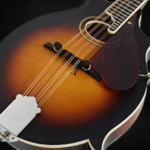
Gretsch G9350 Mandolin Review (Hands-On & In-Depth)
In this Gretsch G9350 Mandolin Review, a professional musician and mandolin player offers his firsthand experience.
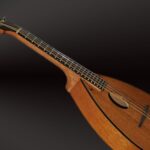
Big Muddy M-11 Mandolin Review (Hands-On & In-Depth)
An expert musician and a mandolin player shares his personal experience in this Big Muddy M-11 Mandolin Review.
- +1 215-438-9031
- 6665 Germantown Avenue Philadelphia, PA 19119

- Appointments
- Violin Bows
[vc_row css=”.vc_custom_1564849582161{margin-top: 0px !important;margin-bottom: 0px !important;border-top-width: 0px !important;border-bottom-width: 0px !important;padding-top: 0px !important;padding-bottom: 0px !important;}”][vc_column][vc_tta_tabs active_section=”1″][vc_tta_section title=”$$$$” tab_id=”1585763142046-82079f76-e1d8″][vc_row_inner][vc_column_inner width=”1/2″][vc_column_text]
Jean-Joseph Martin [/vc_column_text][vc_gallery interval=”0″ images=”3722″ img_size=”full” css=”.vc_custom_1599878068383{margin-top: 5px !important;margin-bottom: 5px !important;border-top-width: 5px !important;border-bottom-width: 5px !important;padding-top: 5px !important;padding-bottom: 5px !important;}”][vc_gallery interval=”0″ images=”3721″ img_size=”full” css=”.vc_custom_1599878079886{margin-top: 5px !important;margin-bottom: 5px !important;border-top-width: 5px !important;border-bottom-width: 5px !important;padding-top: 5px !important;padding-bottom: 5px !important;}”][vc_column_text css=”.vc_custom_1564594021235{margin-top: -75px !important;}”]Jean-Joseph Martin violin bow. Excellent historic bow from this French maker. Pernambuco stick, with tortoiseshell frog and gold mountings. 60.6 gm. [SOLD] [/vc_column_text][/vc_column_inner][vc_column_inner width=”1/2″][vc_column_text]
Eugene Sartory
[/vc_column_text][vc_gallery interval=”0″ images=”3712″ img_size=”full” css=”.vc_custom_1599878093752{margin-top: 5px !important;margin-bottom: 5px !important;border-top-width: 5px !important;border-bottom-width: 5px !important;padding-top: 5px !important;padding-bottom: 5px !important;}”][vc_gallery interval=”0″ images=”3711″ img_size=”full” css=”.vc_custom_1599878104916{margin-top: 5px !important;margin-bottom: 5px !important;border-top-width: 5px !important;border-bottom-width: 5px !important;padding-top: 5px !important;padding-bottom: 5px !important;}”][vc_column_text css=”.vc_custom_1585756737211{margin-top: -75px !important;}”]Eugene Sartory violin bow. Excellent historic bow from this French maker’s early period, ca 1910, with original winding and thumb grip. Pernambuco stick, with ebony frog and silver mountings. Sold with certificate from Salchow & Sons. 59.2 gm. [SOLD] [/vc_column_text][/vc_column_inner][/vc_row_inner][vc_row_inner][vc_column_inner width=”1/2″][vc_column_text]
Joseph Alfred Lamy [/vc_column_text][vc_gallery interval=”0″ images=”3710″ img_size=”full” css=”.vc_custom_1599878123157{margin-top: 5px !important;margin-bottom: 5px !important;border-top-width: 5px !important;border-bottom-width: 5px !important;padding-top: 5px !important;padding-bottom: 5px !important;}”][vc_gallery interval=”0″ images=”3709″ img_size=”full” css=”.vc_custom_1599878135871{margin-top: 5px !important;margin-bottom: 5px !important;border-top-width: 5px !important;border-bottom-width: 5px !important;padding-top: 5px !important;padding-bottom: 5px !important;}”][vc_column_text css=”.vc_custom_1542133148548{margin-top: -50px !important;}”]Joseph Alfred Lamy violin bow. Excellent historic bow from this French maker. Pernambuco stick, ebony frog, and silver mountings. 59.3 gm.[/vc_column_text][/vc_column_inner][vc_column_inner width=”1/2″][vc_column_text]
Bernard Ouchard [/vc_column_text][vc_gallery interval=”0″ images=”6505″ img_size=”full” css=”.vc_custom_1599878149521{margin-top: 5px !important;margin-bottom: 5px !important;border-top-width: 5px !important;border-bottom-width: 5px !important;padding-top: 5px !important;padding-bottom: 5px !important;}”][vc_gallery interval=”0″ images=”6504″ img_size=”full” css=”.vc_custom_1599878162747{margin-top: 5px !important;margin-bottom: 5px !important;border-top-width: 5px !important;border-bottom-width: 5px !important;padding-top: 5px !important;padding-bottom: 5px !important;}”][vc_column_text css=”.vc_custom_1599874860356{margin-top: -50px !important;}”]Bernard Ouchard violin bow, made for the Vidoudez firm in Geneva. Excellent condition. Pernambuco stick, ivory frog, and silver mountings. 63.9 gm.[/vc_column_text][vc_column_text][/vc_column_text][/vc_column_inner][/vc_row_inner][/vc_tta_section][vc_tta_section title=”$$$” tab_id=”1585759492109-1c822fb1-7572″][vc_row_inner][vc_column_inner width=”1/2″][vc_column_text]
AJ Srubis (Guthrie Shop) [/vc_column_text][vc_gallery interval=”0″ images=”3732″ img_size=”full”][vc_gallery interval=”0″ images=”3731″ img_size=”full”][vc_column_text]AJ Srubis violin bow, made in the Lee Guthrie shop, Minnesota. Stamped ‘St. Croix’. Pernambuco stick with ebony frog and silver fittings. 62.5 gm.[/vc_column_text][/vc_column_inner][vc_column_inner width=”1/2″][vc_column_text]
Lee Guthrie [/vc_column_text][vc_gallery interval=”0″ images=”3720″ img_size=”full”][vc_gallery interval=”0″ images=”3703″ img_size=”full”][vc_column_text]Lee Guthrie violin bow, his #189. Minnesota maker. Pernambuco stick, with ebony frog and silver fittings. 60.5 gm.[/vc_column_text][/vc_column_inner][/vc_row_inner][vc_row_inner css=”.vc_custom_1564849764138{margin-top: 0px !important;margin-bottom: 0px !important;border-top-width: 0px !important;border-bottom-width: 0px !important;padding-top: 0px !important;padding-bottom: 0px !important;}”][vc_column_inner width=”1/2″ css=”.vc_custom_1564849711337{margin-top: 0px !important;margin-bottom: 0px !important;border-top-width: 0px !important;border-bottom-width: 0px !important;padding-top: 0px !important;padding-bottom: 0px !important;}”][vc_column_text css=”.vc_custom_1564849731099{margin-top: 0px !important;margin-bottom: 0px !important;border-top-width: 0px !important;border-bottom-width: 0px !important;padding-top: 0px !important;padding-bottom: 0px !important;}”]
William Halsey [/vc_column_text][vc_gallery interval=”0″ images=”3696″ img_size=”full” css=”.vc_custom_1564849737233{margin-top: 0px !important;margin-right: 0px !important;margin-bottom: 0px !important;margin-left: 0px !important;border-top-width: 0px !important;border-bottom-width: 0px !important;padding-top: 0px !important;padding-right: 0px !important;padding-bottom: 0px !important;padding-left: 0px !important;}”][vc_gallery interval=”0″ images=”3695″ img_size=”full” css=”.vc_custom_1564849746091{margin-top: 0px !important;margin-bottom: 0px !important;border-top-width: 0px !important;border-bottom-width: 0px !important;padding-top: 0px !important;padding-bottom: 0px !important;}”][vc_column_text css=”.vc_custom_1564849110437{margin-top: 0px !important;margin-bottom: 0px !important;border-top-width: 0px !important;border-bottom-width: 0px !important;padding-top: 0px !important;padding-bottom: 0px !important;}”]William Halsey violin bow. American maker. Pernambuco stick, ebony frog, with silver fittings. 60.2 gm.[/vc_column_text][vc_column_text css=”.vc_custom_1542652374353{margin-top: -50px !important;}”][/vc_column_text][/vc_column_inner][vc_column_inner width=”1/2″ css=”.vc_custom_1564849176987{margin-top: 0px !important;margin-bottom: 0px !important;border-top-width: 0px !important;border-bottom-width: 0px !important;padding-top: 0px !important;padding-bottom: 0px !important;}”][vc_column_text css=”.vc_custom_1564849347619{margin-top: 0px !important;margin-bottom: 0px !important;border-top-width: 0px !important;border-bottom-width: 0px !important;padding-top: 0px !important;padding-bottom: 0px !important;}”]
E. Vander Veer Shaak [/vc_column_text][vc_gallery interval=”0″ images=”3739″ img_size=”full” css=”.vc_custom_1564849209774{margin-top: 0px !important;margin-bottom: 0px !important;border-top-width: 0px !important;border-bottom-width: 0px !important;padding-top: 0px !important;padding-bottom: 0px !important;}”][vc_gallery interval=”0″ images=”3738″ img_size=”full” css=”.vc_custom_1564849226705{margin-top: 0px !important;margin-bottom: 0px !important;border-top-width: 0px !important;border-bottom-width: 0px !important;padding-top: 0px !important;padding-bottom: 0px !important;}”][vc_column_text css=”.vc_custom_1564849252115{margin-top: 0px !important;margin-bottom: 0px !important;border-top-width: 0px !important;border-bottom-width: 0px !important;padding-top: 0px !important;padding-bottom: 0px !important;}”]Elizabeth Shaak violin bow. Pernambuco stick and ebony frog with silver fittings, from the owner of Mount Airy Violins & Bows.[/vc_column_text][/vc_column_inner][/vc_row_inner][vc_row_inner][vc_column_inner width=”1/2″][vc_column_text]
Samuel Payton [/vc_column_text][vc_gallery interval=”0″ images=”3718″ img_size=”full”][vc_gallery interval=”0″ images=”3717″ img_size=”full”][vc_column_text]Samuel Payton violin bow. Philadelphia maker. Pernambuco stick with ebony frog and silver fittings. 60.1 gm.[/vc_column_text][/vc_column_inner][vc_column_inner width=”1/2″][vc_column_text]
Andre Lavoye [/vc_column_text][vc_gallery interval=”0″ images=”3727″ img_size=”full”][vc_gallery interval=”0″ images=”3726″ img_size=”full”][vc_column_text]Andre Lavoye violin bow. Montreal maker. Pernambuco stick with ebony frog and silver fittings. 62.1 gm.[/vc_column_text][/vc_column_inner][/vc_row_inner][vc_row_inner][vc_column_inner width=”1/2″][vc_column_text]
Jesse Berndt [/vc_column_text][vc_gallery interval=”0″ images=”3729″ img_size=”full”][vc_gallery interval=”0″ images=”3728″ img_size=”full”][vc_column_text]Jesse Berndt violin bow. Minneapolis maker. Pernambuco stick with ebony frog and silver fittings. 60.7 gm.[/vc_column_text][/vc_column_inner][vc_column_inner width=”1/2″][vc_column_text]
Joseph Kun [/vc_column_text][vc_gallery interval=”0″ images=”5363″ img_size=”full”][vc_gallery interval=”0″ images=”5364″ img_size=”full”][vc_column_text]Joseph Kun violin bow. Gold and tortoiseshell bow from this VSA award-winning bowmaker and luthier. 62.0gm[/vc_column_text][/vc_column_inner][/vc_row_inner][vc_row_inner][vc_column_inner width=”1/2″][vc_column_text]
Lee Guthrie [/vc_column_text][vc_gallery interval=”0″ images=”3715″ img_size=”full”][vc_gallery interval=”0″ images=”3714″ img_size=”full”][vc_column_text]Lee Guthrie violin bow, his #234. Minnesota maker. Pernambuco stick, with ebony frog and silver fittings. 60.4 gm.[/vc_column_text][/vc_column_inner][vc_column_inner width=”1/2″][/vc_column_inner][/vc_row_inner][/vc_tta_section][vc_tta_section title=”$$” tab_id=”1585759494885-8391131e-385a”][vc_row_inner][vc_column_inner width=”1/2″][vc_column_text]
Arcos Brasil ‘Replica’, A. Carlesso [/vc_column_text][vc_gallery interval=”0″ images=”3701,3700″ img_size=”full”][vc_column_text css=”.vc_custom_1542131181048{margin-top: -75px !important;}”]’Replica’-level violin bow from Arcos Brasil. We keep a few of these on hand, in various styles (Sartory, Lamy, etc). Pernambuco, with ebony frog and silver fittings. 60.1 gm.[/vc_column_text][/vc_column_inner][vc_column_inner width=”1/2″][vc_column_text]
Zdzislaw Prochownik
[/vc_column_text][vc_gallery interval=”0″ images=”3699,3698″ img_size=”full”][vc_column_text css=”.vc_custom_1542652392672{margin-top: -75px !important;}”]Zdzislaw Prochownik violin bow. Longtime member of the Winnipeg Symphony, known for his bass bows. Pernambuco stick, ebony frog, with silver fittings. 61.1 gm.[/vc_column_text][/vc_column_inner][/vc_row_inner][vc_row_inner][vc_column_inner width=”1/2″][vc_column_text] Conrad Gotz [/vc_column_text][vc_gallery interval=”0″ images=”3073″ img_size=”full”][vc_column_text css=”.vc_custom_1435689070036{margin-top: -75px !important;}”]Gotz violin bow made in Germany[/vc_column_text][/vc_column_inner][vc_column_inner width=”1/2″][vc_column_text] Arcos Silver-Mounted Bows [/vc_column_text][vc_gallery interval=”0″ images=”3073″ img_size=”full”][vc_column_text css=”.vc_custom_1585850020969{margin-top: -75px !important;}”]We maintain a selection of silver-mounted bows of several levels from the Arcos Brazil company, chosen for workmanship and appearance. Contact us to find out precisely what we have in stock.[/vc_column_text][/vc_column_inner][/vc_row_inner][vc_row_inner][vc_column_inner width=”1/2″][vc_column_text] Marco Raposo Silver-Mounted Bow [/vc_column_text][vc_gallery interval=”0″ images=”3073″ img_size=”full”][vc_column_text css=”.vc_custom_1585850493890{margin-top: -75px !important;}”]We maintain a selection of silver-mounted bows of several levels from the Marco Raposo company from Brazil, chosen for workmanship and appearance. Contact us to find out precisely what we have in stock.[/vc_column_text][/vc_column_inner][vc_column_inner width=”1/2″][vc_column_text] Brazil Buzatto Silver-Mounted Bows [/vc_column_text][vc_gallery interval=”0″ images=”3073″ img_size=”full”][vc_column_text css=”.vc_custom_1585850475660{margin-top: -75px !important;}”]We maintain a selection of silver-mounted bows of several levels from the Brazil Buzatto company, chosen for workmanship and appearance. Contact us to find out precisely what we have in stock.[/vc_column_text][/vc_column_inner][/vc_row_inner][vc_column_text] Gallery above is only a sample of our collection which is constantly changing. The bows below are also in at this time. Photos available on request. – JonPaul “Carrera” composite travel bow, made in USA – Older German silver-mounted violin bows – Silver-mounted bows from SousaBows[/vc_column_text][/vc_tta_section][vc_tta_section title=”$” tab_id=”1585759496322-f49097c1-c98d”][vc_row_inner][vc_column_inner width=”1/2″][vc_column_text]
Arcos Brasil [/vc_column_text][vc_gallery interval=”0″ images=”3073″ img_size=”full”][vc_column_text css=”.vc_custom_1586825730613{margin-top: -75px !important;}”]Nickel-mounted pernambuco bows from Arcos Brasil company. We try to maintain a stock of several of these at all times, selected for attractive craftsmanship and excellent wood choice. Contact us for more information.[/vc_column_text][/vc_column_inner][vc_column_inner width=”1/2″][vc_column_text]
[/vc_column_text][vc_gallery interval=”0″ images=”3073″ img_size=”full”][vc_column_text css=”.vc_custom_1586825710526{margin-top: -75px !important;}”]We maintain a supply of CodaBows of all levels (Prodigy, NX, SX, and GX). We can also special-order CodaBow’s ‘Marquise’ line if you are interested.[/vc_column_text][/vc_column_inner][/vc_row_inner][vc_column_text]
[/vc_column_text][/vc_tta_section][vc_tta_section title=”Shipping” tab_id=”1585759547236-d1c191fe-37fb”][vc_column_text]Have you found something on our website that catches your fancy, but you live hours away? Have you heard about us at a summer festival, and you’re curious about what we’ve got available?
We’re willing to ship instruments and bows for your trial. Contact us so that we can discuss what you’re looking for and confirm that it is in stock.
We’ll need a copy of your driver’s license or other valid photo ID, as well as your credit card info, which we will keep on file for the duration of your trial period. In addition, we ask that you give us contact info for your current teacher or a musical colleague who can vouch for you, and the name of a local shop where you get your repairs done.
We’ll cover the cost of shipping the instruments or bows to you, and provide you with a tracking number. You are responsible for the return shipping costs of any instruments or bows you choose not to purchase.[/vc_column_text][/vc_tta_section][/vc_tta_tabs][/vc_column][/vc_row]
We Are Here To Assist You
Contact us today.

Curated News for String Musicians Keep up to date on our best sales, occasional free offers, and upcoming concerts.
- By appointment only. Walk-ins accommodated as staff availability allows.
- Mon – Closed
- Tue – Pick-ups Only
- Wed – 1:00 to 6:00
- Thu – 1:00 to 6:00
- Fri – 1:00 to 6:00
- Sat – 11:00 to 4:00
- Sun – Closed
Quick Links
- Repair & Restorations
- [email protected]
FREE Shipping on ALL Cases + 30-Day Return Guarantee
- Violin Cases
- Viola Cases
- Cello Cases
- Double Cases
- Guitar Cases
- Saxophone Cases
- Trumpet Cases
- Clarinet Cases
- Trombone Cases
- Mandolin Cases
- Case Accessories
- Case Covers
- Shoulder Rests
- Violin Strings
- All Blogs & Reviews
- Violin Case Buyer's Guide
- Cello Case Buyer's Guide
- Viola Case Buyer's Guide
- About Bam Violin Cases
- About Gewa Violin Cases
- Testimonials
Your Cart is Empty
- $ 0.00 Subtotal
Tax included. Shipping calculated at checkout.
- All Violin Cases
- Best Selling Cases
- Lightest Violin Cases
- Oblong Cases
- Contoured Cases
- Student Favorites
- 3/4 Violin Cases
- All Viola Cases
- Lightest Viola Cases
- Adjustable Cases
- All Cello Cases
- Fiberglass Cello Cases
- Lightest Cello Cases
- With Wheels
- Woodwind & Brass
- Bass Gig Bags
Best Violin Cases for Travel
One of the most common questions we get at Great Violin Cases, is what violin case is best for travel?
So we've created this article to answer that exact question! Along with our top 4 most popular cases for traveling musicians. Some of the key factors we take into consideration are:
- Lightweight
- Compact & easy to stow
- Sturdy & durable
- Temperature-resistant
- Budget airline friendly (for strict carry-on regulations). These are typically cases that can only fit the violin, and the bow goes in a separate bow tube.
Best "Go-To" Violin Travel Case
Gewa space bag.
Why we love it
✅ Bag meets carry-on regulations
✅ Elastic rings to secure bow-tube
✅ Backpack-style compartment for sheet music & accessories
✅ Breathable mesh backpack straps
Price: $261
Weight: 5.9 lb.
Size: 4/4 & 3/4 options
Show More...
Top made of polycarbonate shells
2 mesh pockets on the sides
Subway handle on the top
High-density foam cushioning for violin
Great temperature resistance & insulation
When we say a good "go-to" case, we mean something that is well balanced between price, weight, protection, design, functonality and durability.
The Gewa Space Bag is a good balance of all these aspects. It features polycarbonate shells for protection and durability (without breaking the bank).
It's also very functional. There's a backpack compartment for all your sheet music and accessories. Along with 2 side pockets. The shoulder straps and backside are also made of breatheable mesh. Making it very comfortable to carry.
Most Protective Violin Case for Travel
Bam cabin violin case.
✅ Extremely protective & durable
✅ Sleek & modern looking case
✅ Can be locked with 3-digit combinations
✅ Only 2.6 lb.
✅ Bow tube included as free gift! (Great Violin Cases offer).
Price: $715
Weight: 2.6 lb.
Size: 4/4 violins
Water-resistant seal
Bam's signature high-density foam
Great temperature resistance
Comes with 2 neoprene backpack straps
As the name suggests, the Bam cabin violin cases were specifically designed by Bam for airline travel.
The case itself does not exceed 24 inches in length (maximum carry-on length). There are no bow-holders in the case. It comes with a separate bow tube that can fit up to 2 bows.
This case is ideal for violinists who travel quite often on strict budget airlines . The bow tube itself can be placed in a large-size suitcase, or directly stowed under the plane (you can just check-in the bow tube).
The case also comes with two elastic bands that can be wrapped around the case and the bow tube.
However, if you prefer to keep your bow and instrument in the same place, we would suggest the regular Bam Hightech Contoured Violin Cases .
Bam Cabin Violin Case Video Review
Video Details
In this video, we do a full review of the Bam Cabin violin case. The model (color) in this video is "Tweed".
Most Durable Case for Travel (won't Break the Bank)
Bobelock 1063 violin case.
✅ Extremely protective. Affordable price
✅ Several colors to choose from.
✅ Comes with free travel cover!
Price: $240
Weight: 5 lb.
Sturdy fiberglass shells
1 shoulder strap included
Comes with black nylon travel cover
Has hydrometer
The Bobelock cases are not designed specifically for air travel. The case itself can fit 2 bows. So it'll exceed strict carry-on regulations (the bow itself exceeds the longest length allowed).
However, 95% of airlines are fine with these violin cases (to be honest, we haven't heard of any airlines rejecting violins as carry-on luggage).
We added these Bobelock cases to this list because they're the most durable violin cases under $300. They're not the lightest cases, but they're known to take a beating!
If you're forced to check-in your violin case, you'll feel relieved that at least it's going under the plane in a Bobelock case.
Best Overall Violin Case for Travel (and Daily Use)
Gewa pure violin case.
✅ Best selling case on our site
✅ Sturdy & protective polycarbonate shells
✅ A simple, "gets the job done" case
✅ Scratch-resistant surface
Price: starting at $238
Weight: 4+ lb.
Size: can fit 3/4 & 4/4 violins
Movable neck cushion to fit 4/4 & 3/4 violins
Water-resistant seals
Comes with 2 backpack straps
Removable accessory pouch
The Gewa Pure violin case is one of our best selling cases!
It's a good "go to" case for travel and daily use.
Even though the Bam Cabin case is ideal for travel and strict-budget airlines, violinists may not want to carry their bows separately for day-to-day rehearsals.
Which is why we recommend this Gewa Pure case. Even though it doesn't meet strict carry-on regulations, 95% of airlines will accept this case.
And it also has that great balance we mentioned earlier (weight, protection, design, functionality, etc.).
Gewa Pure Violin Case Video Review
In this video, we do a full review of the Gewa Pure violin cases. We feature both shapes - contoured and oblong. Though we recommend the contoured case for travel.
What Makes a Case Good for Travel?
In this section, we go into more detail as to how we came up with our list of top violin cases for travel.
The ideal case should be light, compact, protective, durable and temperature-resistant.
But Wait, There's A Problem...
Technically, all violin cases are too big for carry-on. That's because the length of the bow itself exceeds the maximum length of carry-on restrictions. Check out this carry-on luggage guide for more information.
But no worries! Over the years, most major airlines have become more lenient when it comes to bringing instruments as carry-on.
Some smaller budget airlines may still be fairly strict though. Which is why certain brands (like Gewa and Bam), designed carry-on friendly cases. These feature detachable bow tubes that can be checked in.
Quick Airline Tip
If an airplane is running out of space in the overhead compartments as passengers are boarding, airline staff will pick luggages at random to stow under the plane.
You definitely do not want your case to attract any attention. So don’t be the last one to board the airplane!
If the overhead compartments have already filled up, it’s going to be more hassle for the airline staff to take someone else’s luggage out of the overhead compartments to make space for your case.
Some cases are definitely more protective, durable and weather-resistant compared to others, but it really depends on your needs.
How much do you travel? Do you mostly fly major airlines? Or do you fly a lot of budget airlines throughout Europe?
Do you have a large shoulder rest? Are you forgetful? Would it be a hassle for you to bring a separate bow tube when going to rehearsals?
And remember, there's no rule against having 2 or more violin cases. Many professional violinists have different cases for different purposes. Such as a compact case for travel, and an oblong case for daily rehearsals.
Be sure to check out our full collection of violin cases at Great Violin Cases.

16 Best Violin Bows in 2023: Ultimate Buying Guide for the Right Violin Bow
by Zlata | Jun 28, 2023 | 9 comments
Buying the best violin bow is at least as important as the violin you buy
If you have a fantastic violin, but your bow is wobbly, the hair doesn’t respond to the string and it never seems to do what you want, you will be discouraged in your violin playing.
For example you could notice the violin bow jumps or shakes when you want to play legato or just doesn’t want to jump when you want to play spiccato. Also you might have the idea that your violin doesn’t sound that good with the bow that you have.
The violin bow makes an enormous difference in the sound you make, how you tackle fast runs, the bowing techniques you can perform and the overall ease of playing violin
Violin bows cost from $ 6 ( see review here ) up to $ 288,960 (more info below). In this article I will discuss what to look for when buying a violin, how much a violin bow costs and my reviews of beginner, intermediate and professional bows of different prices.
Table of contents:
- Top 3 violin bows
- What difference a violin bow makes
- What to look for when buying a violin bow
- 16 best violin bow reviews
- beginner violin bow recommendations
- best violin bows for intermediate players
- best all-round violin bows for advanced players
- professional violin bow prices and reviews
Top 3 violin bows in 2023
Let’s start with what I think are the best violin bows for beginner, intermediate and advanced players. Then I will discuss what difference a bow makes and what to look for when buying a bow. After that I will continue with the promised 16 best violin bows on the market right now and more depth violin bow reviews.
Best violin bow for a beginner violinist
Do you feel the violin bow that ‘came with’ your violin set just doesn’t seem to do what you want? Do you want to sound better, tackle fast runs and perform different bow strokes?
A good violin bow doesn’t have to be expensive. While good pernambuco wooden bows start around $ 600, these days carbon fiber bows make it possible to get a good violin bow at a very low price.
I think this bow is the best under $ 100:
Fiddlerman carbon fiber violin bow
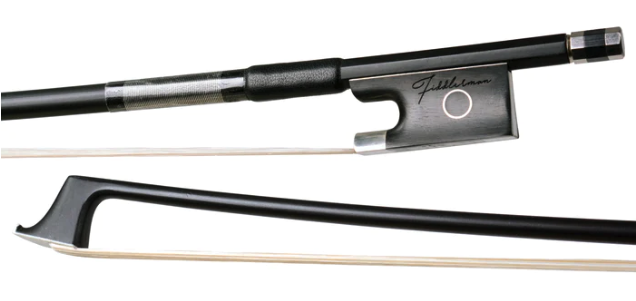
Best all-round violin bow for intermediate to advanced players
As an intermediate player you want a bow that not makes your violin sound great, but also can perform all different violin bowing techniques.
CodaBow Marquise GS violin bow
This bow gives a warm, but full sound on almost every violin. It feels like it follows your hand beautifully and subtly. The stick is round and a little flexible making it easier to switch between detaché and spiccato. Still it’s stiff and punchy enough for a crispy staccato or ricochet.
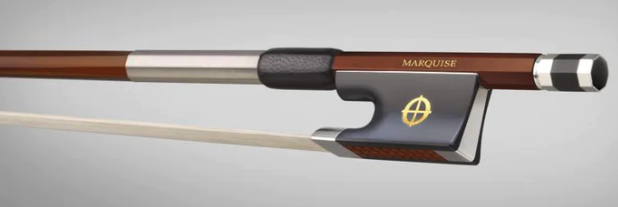
Top violin bow for an advanced or professional player
In the price range for advanced and professional players (say from around $ 3,000 for a violin) one often speaks more of individual bow makers of the past and present more than brands and types. It’s important to select a unique bow that suits your playing style and violin.
Arcus S9 round violin bow
This bow has an extremely light weight (49 grams), which makes it very agile and light and easy to play with. Switching between all different bowing techniques is a breeze. It allows the maximum resonance from your instrument and you’ll have a large brilliant sound without it being too harsh.

What difference does a violin bow make in your playing?
You might be wondering: Does a violin bow make a difference? It looks like a simple stick with some hair, right? Why do violinist pay thousands for a special bow?
Certainly as you’ll learn different violin bowing techniques, a good violin bow will make it a lot easier to perform a smooth detaché or legato, a jumpy spiccato or ricochet and a crispy staccato.
A good violin bow will help you make a beautiful sound on your violin, make it easier to play difficult pieces and give you a lot more confidence in your violin playing.
Professionals will agree that they’d rather play a mediocre violin with a top range bow than the other way around. ‘Le violon, c’est l’archet.’ (the violin, it’s the bow) said the famous bow maker François Tourte around 1800. Most bows are still made after the design he developed.
To show an extreme difference between violin bows, check out this video review I made with a $ 29 bow vs a $ 8,000 bow.
Sure, Zlata, now we know the violin bow is extremely important for your violin playing, but…
What to look for when buying a violin bow?
How are different violin bows different.
Before I go into the reviews of violin bows, let’s discuss what differences you can notice between violin bows. When you are choosing a violin bow to buy, there are several characteristics to look out for.
#1 How the violin bow makes your violin sound
When you play with different violin bows, you’ll start to notice that your violin produces a different sound depending on the bow you use. Some bows will make it sound warmer, mellower and softer, while other bows will make your violin sound more brilliant, louder or even shrill.
It’s important to consider where you will use the bow for. Are you a soloist who needs to carry the sound over the orchestra in a large concert hall? Or are you second violinist who wants her sound to blend in the orchestra? Maybe you mainly play chamber music.
‘Response’
Response might seem like a vague term that’s hard to imagine if you haven’t experienced differences in it yourself when trying out different bows. In essence it means how the violin bow reacts when you start a note. Is the sound there right away? Or do you very consciously need to start the sound? Or do you feel the sound starts delayed? It’s pleasant when the sound starts right away as you make the bow stroke.
Dynamic range
When you’re testing a violin bow try out playing pianissimo in all places of the bow (for example also at the extreme tip) and playing fortissimo. You’ll discover that some bows can play very very soft and still have sound, while other bows seem to respond less and have a smaller dynamic range. To play the violin expressively, it’s important that you can play all dynamics easily with your bow.
#2 How it feels to play with a violin bow
When you start trying out different violin bows in your quest to buy the right one, you’ll quickly notice the bows feel differently while playing.
Weight (light vs heavy)
Some bows are extremely light like the Arcus bows of 49 grams. Other bows feel quite heavy, some even over 60 grams. This might not seem like lot, but you DO feel it a lot when playing.
Balance (stable vs bouncy)
A violin bow could be heavier at the tip or heavier at the frog.
Pros and cons of a heavy violin bow
When the bow is heavy at the tip it feels very secure, you can easily do a smooth legato, but jumping bowing techniques might take more effort and might seem more difficult. Also your pinky needs to do more work.
Pros and cons of a light violin bow
When the bow is relatively heavy at the frog OR particularly light at the tip (or both) the bow can feel a bit more nervous and jumps easily. This is an advantage for jumping bowing techniques like spiccato, sautillé and ricochet, but it can make smooth bowing more difficult. If the bow is too nervous for you, it feels like you can’t control it. Obviously a light bow is agile and fast runs can be easier. In general with a light bow you feel more ease in your playing and it’s less strenuous for your arm, hand and fingers. In wooden bows a very light weight often means that the bow is soft and can feel wobbly. In carbon fiber bows, like Arcus, it’s possible to make very light bows that are also stiff.
Stiff vs flexible
With a stiff bow it’s easier to put weight into the bow. When you press your index finger into the bow while playing, this pressure (or weight) will transfer through the bow and the bow hair into the string. If you have a soft or flexible bow, you will see that the bow easily bends in the direction of the hair (or even almost touch the hair) when you put pressure on the bow.
The pro of a stiff bow is that you can easily transfer weight, have a good response and play jumping bowing techniques like spiccato and ricochet. However, a stiff bow might also feel a bit nervous and miss a certain nuance. A more flexible bow can feel like you’re more in control and can make more subtle jumps in spiccato and a smoother legato. When a bow is too soft, it doesn’t function and is really hard to manage.
Isn’t the stiff vs flexible a matter of tightening the bow? Yes, when the bow is tighter it will feel a bit stiffer. This is why it’s important that you know exactly how much to tighten your violin bow (watch the video here) . However, the stick itself has a certain resilience and even if you tighten a very soft bow a lot, it will still be soft.
#3 Types of violin bows and what they’re made of
Carbon vs wood violin bow: what is better.
Carbon fiber violin bows are good news for a few reasons:
- It’s possible to make very good bow for very little money as you don’t need rare types of wood
- You can manufacture types of bows (also higher range) that have benefits that wood bows can’t have (like the very light Arcus bows that are still stiff and offer the advantages of both baroque and Tourte bows).
- Carbon fiber violin bows are far less sensitive for wrapping due to humidity and temperature changes. The are more durable.
- Pernambuco is an endangered type of wood, so good quality wooden bows will become more and more expensive in the future.
Some violinists think the cheap carbon composite bows from Chinese factories are what carbon has to offer. However, these days in carbon as well as wood there are so many quality levels and types of bows that one cannot say something general about either of them.
Lots of violinists still like the charm of an individual wooden bow and love their precious pernambuco bow from a certain (maybe antique) bow maker.
Read more about wood vs carbon violin bows in my article right here.
Read here about all the different materials the parts of the violin bow are made of.
Octagonal vs Round violin bow: what is better?
The part of the violin bow at the frog is always octagonal (so the wood has eight edges). The stick of the bow can either be round (smooth) or octagonal. In general octagonal bows are stiffer, more agile and jumpier. Round bows are smoother, more flexible and peaceful.
Violinists play for 50% on round bows and 50% on octagonal bows, which proves that one isn’t better than the other. It’s a matter of personal preference. You can be a ’round bow person’ or an ‘octagonal bow person’ and you can switch during your career.
Please also know that the characteristics of each bow differ a lot and the fact that they are octagonal or round doesn’t say everything. When you’re looking to buy a violin bow, don’t limit yourself to one bow.
Watch this violin bow review video to find out more about round vs octagonal.
Now you know what to look for when buying a violin bow
How much does a good violin bow cost.
There are beginner level bows that cost under $ 100 and are still great bows to start out with. Intermediate bows cost between $ 500 and $ 2,000. Professional level bows start around $ 3,000 and cost up to six figures. I will review some great violin bows in each price range below.
Let’s get started with my bow reviews, so you can pick the right bow for you!
Top 16 violin bows of 2023: reviews by a violin teacher.
I will review violin bows from cheap to expensive and will start with some bows that are great for beginners and a good ‘bang for your buck’. After that I will continue with bows for intermediate, advanced and professional players.
Selecting and buying the right bow for you is very personal, which is why it’s important to try out different bows for yourself if you have the possibility to. You can do this in a violin shop or have a selection of bows shipped to your home if you’d like to buy your violin bow online. I hope my reviews can help you make your selection.

Best violin bows for beginners
Price range $ 63 to $ 400.
What are good violin bows for beginner violinists? Check out these top picks:
P&J Fiberglass violin bow you can rehair yourself!
Price: $ 63
Features: fiberglass stick, easy rehair system you can do yourself at home, Parisian eye, mother of pearl inlay, available in lots of sizes and colors (fun for kids)
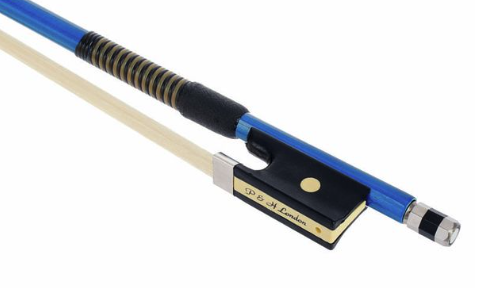
So your kid is a budding violinist and one day while playing the bow hair gets caught up in the finetuners of the violin when he’s not looking. Then he tries to get the bow lose himself and SNAP… the bow hairs are broken.
Or you’re an adult, want to take your bow out of the violin case and EECK… the bow hairs get stuck behind the bow holder and break. Noooo!
For bows under $ 100 there’s no point in getting a rehair that can cost the same as your bow except if you get a P&J bow with the easy at home rehair system. Yes, you can rehair this bow yourself!
Of course that’s a big advantage, but also know that this bow is fiberglass (not carbon or carbon fiber) and will not have the sound and characteristics of bows made out of better materials.
However, for schools this bow is ideal!
Price: $ 69
Weight: 60 grams
Features: carbon fiber stick, ebony frog, circle eye, horse hair
This bow is truly the best bang for your buck and the bow I recommend to everyone with a tight budget looking to upgrade from the bow that ‘came with their violin’. The sound is nice and full and it can easily do all the different bow strokes for you. Because it’s carbon fiber, the quality will be consistent and it’s very durable.
Dörfler D7 massaranduba violin bow
Price: $ 109
Features: ebony frog, simple eye and round massaranduba stick
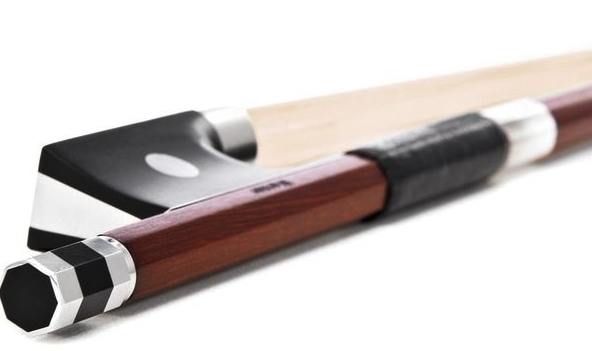
Dörfler makes excellent violin bows in Germany and really is a brand to look for when buying a wooden violin bow. Massaranduba is a municipality in Brazil making this a brazil wooden (but not pernambuco) violin bow.
This bow is nice and stable for a beginner, has a flexible round stick and produces a warm not too full tone. When you’re going into more advanced bowing techniques, you might however want to look for
Holstein pernambuco violin bow
Price: $ 199
Features: pernambuco stick, silver mounting, ebony frog, Siberian horse hair, mother of pearl inlay
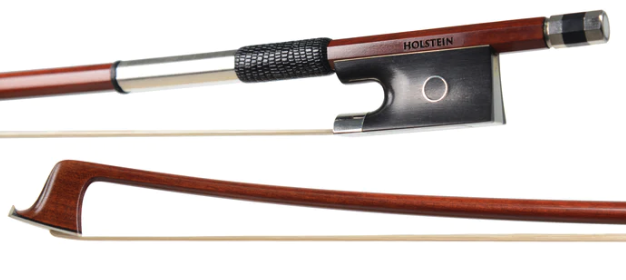
Forget that I said that only above $ 600 you can get a quality pernambuco bow. What!? This Holstein bow is made of quality pernambuco, it has a great response, good open sound on your violin, a strong resilient stick and… it’s under $ 200. On top of that it comes with the great warranty and service of the friendly guys at Fiddlershop. If you want a traditional quality bow with small budget, get this bow!
CodaBow Prodigy Carbon Fiber Violin Bow
Get rid of bow shakes and feel in control as a beginner violinist.
Price: $ 365
Features: graphite fiber weave stick with kevlar fiber acoustic core, nickel silver fittings, ‘Xebony’ frog, Mongolian horse hair
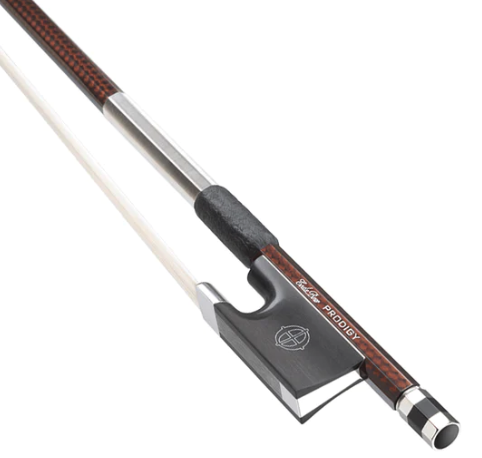
If you want to feel secure as a beginner and stop your shaky bow, get this Prodigy. It feels very stable, is on the stiff and slightly heavy side. It might not be as agile as the more expensive models by CodaBow, but it can be an extremely pleasant bow for the first years. It’s simply very forgiving and I recommend it time after time when beginner(ish) students complain about not being able to control their bow.
Best mid range violin bows for intermediate players
Price range: $ 500 to $ 750.
If you’re playing more technically challenging pieces and start to deepen your musical expression, upgrading your bow can be really rewarding as an intermediate violinist.
Over the years I’ve convinced quite some intermediate players who thought they needed a different violin, to look into a new bow first. It can make all the difference.
Fiddlerman Pro Series carbon fiber violin bow
Price: $ 599
Weight: 53 grams
Features: carbon fiber stick, snakewood frog, sterling silver fittings,
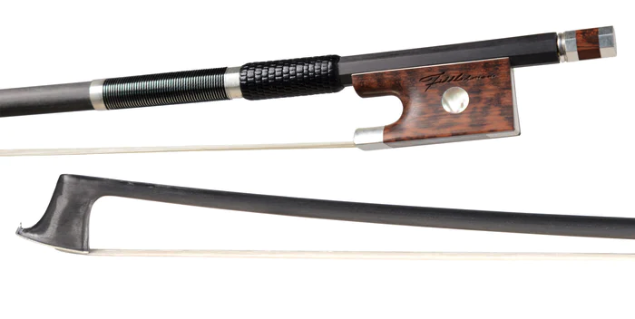
The sound of this bow is brilliant, open and clear. It’s nice and light, easy to handle and very agile. You can easily perform all bowing techniques with it and it offers excellent value for money. It’s a great affordable alternative for the more expensive carbon fiber bow brands.
Watch my video review of the Fiddlerman Pro series here and decide for yourself if it’s PRO or NO.
Conrad Götz No.76 Pernambuco Violin Bow
Price: $ 639
Features: round pernambuco stick, Parisian eye, ebony frog, made in Germany
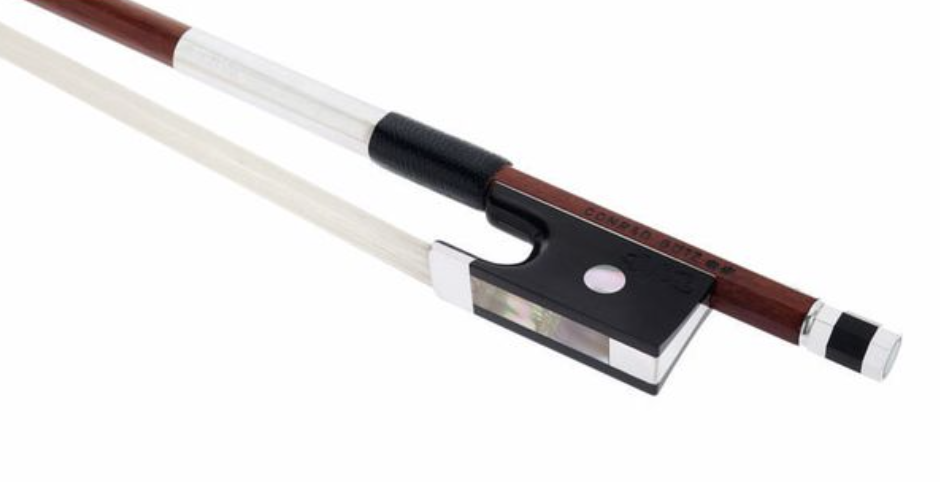
Round bow with a mellow sound that’s comfortable to hold and easy to play. If you’re looking for a great intermediate traditional bow, this is a good pick!
Musing C3 Carbon Fiber Violin Bow
Price: $ 675 (Müsing bows start at $ 495)
Weight: 54 grams
Features: 80% carbon fiber stick, steel fittings, star shaped button and ergonomic frog

Great quality carbon fiber bow that’s 80% carbon fiber, which means it allows great resonance of your violin (too much epoxy mutes the sound). These bows are agile and you can perform different bowing techniques with ease. Also it’s lighter than most wooden bows.
Jean-Paul Pernambuco Silver 2-star Violin Bow
Price: $ 739
Weight: 60-62 grams
Features: carefully selected pernambuco stick, horn frog, large pearl eye
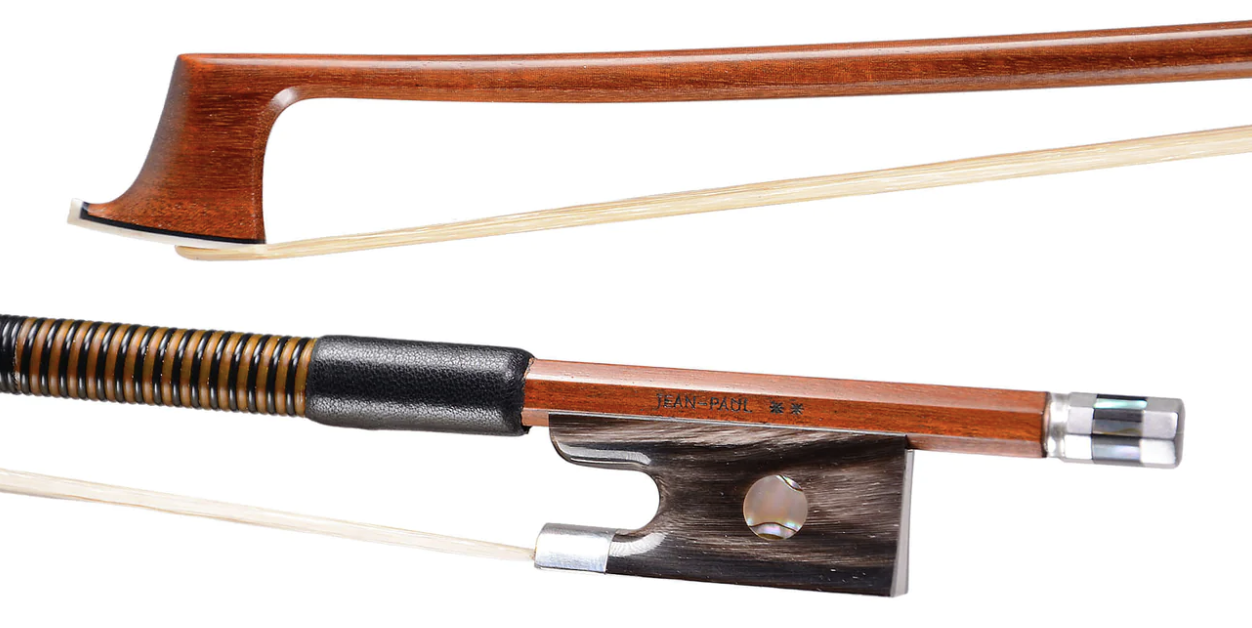
A traditionally crafted pernambuco bow with a beautiful full and warm sound. This bow is made with great attention for details.
Jean-Paul is known to make excellent bows with a peaceful character and a warm sound. Make sure to also check out their carbon fiber bows if you want the advantages of carbon fiber with the look and feel of a traditional pernambuco bow.
Best all-round violin bows for intermediate, advanced and professional players
Price range: $ 1,200 to $ 2,250.
Are you looking for a bow that can blend in in an orchestra, help you shine as a soloist, enjoy chamber music, be great at your wedding gig and does all bowing techniques with ease while at the same time make your violin sound best?
These bows can really do everything for the active amateur or the professional with a variety of gigs:
Codabow Marquise GS Violin Bow
Price: $ 1,295
Features: unidirectional carbon fiber stick, natural acoustic core, ‘Xebony’ frog,
This is the top of the line bow by CodaBow and compared to it’s ‘little brothers and sisters’ it’s definitely worth the extra money. It really gives you the smooth subtle feeling from a traditional master bow and it sounds warm, but full, and has a great response.
For example the GX does everything it needs to do, but the Marquise allows for more expressive playing and a more complex tone. I know this all sounds vague, so definitely give it a try.
Michael Mönnig Violin Bow Silver
Price: $ 1,739
Features: very high quality aged round pernambuco stick, silver mounting, Paris eye
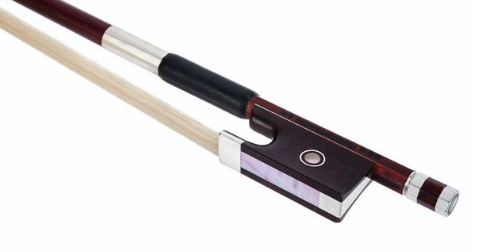
This is a great example of a versatile, high quality hand made pernambuco bow. It has a powerful and sonorous sound with a great response. This bow will express all the subtleties in your playing in a beautiful sound.
Arcus T6 Violin Bow
Price: $ 2,250 (for the T6, the T-series starts at $ 1,080)
Weight: 52 grams
Features: unidirectional hollow carbon fiber stick, snakewood frog, silver mounting
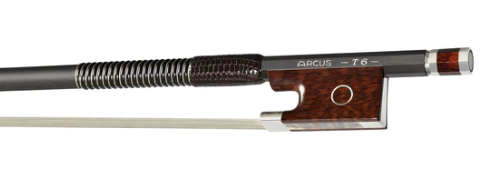
The T-models are the most universal bows made by Arcus. It’s also their newest series and since it’s introduction I’ve been recommending them so much to a variety of players. They cover a huge spectrum of sound colors and playing styles. Violinists can expect great warmth and brilliance at the same time, which make them suitable for a majority of instruments.
For this review I chose the T6, because I think the sound and playing quality is noticeably better than the T4 or the T5 and definitely worth the upgrade if you can afford it. Above the 6 it’s a bit more costly, still worth it, but more luxury than necessity for a professional.
Watch my review video of the Arcus T-series right here. In it I also walk you through the different classes (T4 to T9), because I know that can be very confusing if you’re new to Arcus bows.
Most expensive violin bows for professional violinists
Price range: $ 3,799 to $ 288,960 ().
Get ready to be tempted by these top tier violin bows suitable for the most demanding professional players. Usually when you want to buy a high quality violin bow, the way is to visit a violin shop, try out several bows and perhaps take a selection home. You will find unique bows by bow makers of the past and present. For this article I have selected some professional violin bows that one could buy online.
What is the most expensive violin bow in the world?
Did you know that violin bows can cost up to six figures? Antique bows of famous makers that are in a good state and have a history of being played by famous violin virtuosos like Kreisler or Paganini can be auctioned for very high prices. The most expensive violin bows are made by the famous bow maker François Xavier Tourte (1747 to 1835). Most bows are still made after his design. Recently a silver and ebony bow Tourte made and was played by Bronislaw Huberman is sold for a whopping $ 288,960.
Why are expensive bows gold mounted?
All bows I review below of the higher price range are gold mounted. Are expensive violin bows more expensive because of the gold mounting? Yes and no. It’s a tradition in bow making for a maker to use the most precious materials for their best bows. Gold mounting is to indicate that this a a top level bow. However, of course the maker must calculate the gold price in the violin bow price. Gold is a little lighter than other materials, but it doesn’t really make a difference in the playing characteristics of the bow.
Penzel Violin Bow Goldbow
Price: $ 3,799
Features: top level pernambuco aged 40 years, gold mounting, Parisian eye, Hill liner, sequential numbering of the stick and frog
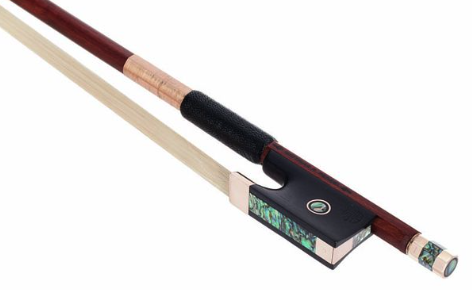
Traditional violin bow made out of top level pernambuco wood by master bow maker Matthias Penzel in Germany. This is a family business with a tradition going back over 100 years. This is a bow one could for example play in a professional orchestra, but it’s also a gem to have or the demanding amateur.
JonPaul Vetta 14K Gold Violin Bow
Price: $ 4,348
Features: carbon fiber bow with a varnish finish made after the example of a Pecatte bow, rose gold mounting, white horn frog (also possible to choose ebony or black horn)
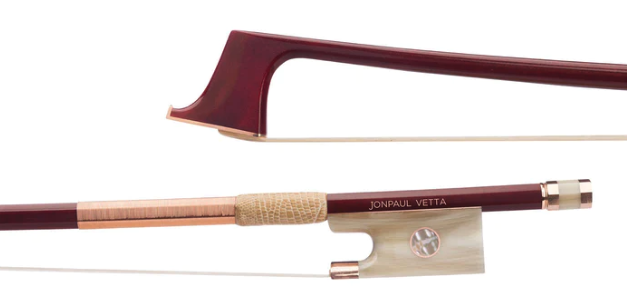
Made after the example of an actual Pecatte violin bow (a famous antique bow). This bow really has the advantages both of a high priced antique pernambuco bow and a top level carbon fiber bow. The best of both worlds! The balance, weight and flexibility are optimized. The sound is warm, rich and powerful. You’ll feel you have a precious antique bow.
Archet SLC Gold-Mounted Pernambuco Violin Bow
Price: $ 4,500
Features: 35 to 80 years aged pernambuco stick of top quality, gold mounting, mother of pearl inlays
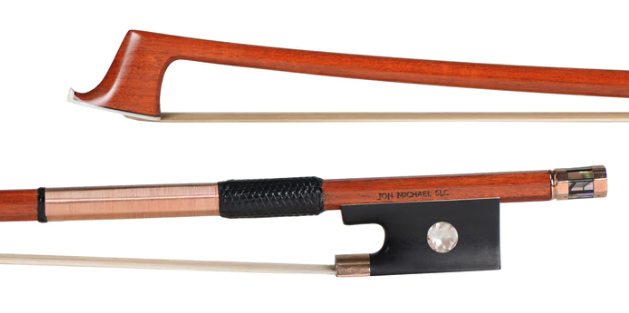
Top quality pernambuco violin bow hand made in Salt Lake City (Utah, USA) in the French style of Pecatte and Maline.
Arcus S9 round Violin Bow
Price: $ 8,000
Weight: 48 grams
Features: top quality unidirectional carbon fiber stick, gold mounting, snake wood frog
We end this article with the violin bow I own myself as a violin teacher. Of course I’m extremely biased, but I just love this bow. The light weight makes everything feel easier. It almost feels like you are cheating. It performs every bowing technique with ease (I made my 102 violin bowing techniques video with this one) and it gives a full brilliant sound on my violin.
As I’m biased, I asked my colleague and professional violinist Giedre to review this bow in this video , so you can judge for yourself what you think.
You’ve learned what difference a violin bow makes in your playing, how much a good bow costs, what to look for when buying a violin bow and I’ve reviewed some great violin bows for you in each price range. I hope you find this useful and it will help you find the right bow for you.
What I get asked a lot about violin bows
How much to tighten a violin bow.
If your bow is too lose, you will play with the stick on the string. If it’s too tight, your bow will be worn down faster. In this video I show you exactly how to tighten your violin bow.
Why is a violin bow bent?
The distance between the stick and the hair of your violin bow should be smaller in the middle of the bow than at the frog and the tip. This creates a spring system, so you can perform bouncing bow strokes like spiccato. Never tighten your bow so much that the bow is straight.
Wrapping of the bow
If your bow is bent in the other direction, for example that you see that the bow is curved outwards to the left or the right and doesn’t align with the hair (looking from the top, not the side), then your alarm bells should go off. Often this can’t be repaired and the bow doesn’t play as well.
Wrapping can happen due to changes in temperature and humidity. What you can do to prevent is to not tighten your bow too much, don’t expose it to too much temperate/humidity changes and be careful when putting away the bow in your case.

Hi! I'm Zlata
Let me help you find a great bow for your violin, so you can improve your bowing technique and sound quality:

Classical violinist helping you overcome technical struggles and play with feeling by improving your bow technique.
How often to rosin your violin bow?
If you don’t rosin enough, the bow slips and doesn’t make (much) sound. If you rosin too much, the sound will be harsh and squeaky. In this article I explain all the dos and don’ts around rosining your violin bow.
How to known when to upgrade your violin bow?
Usually this starts with a feeling that you know a better bow would help you sound and/or play better. Then you might want to try some bows out and see what difference a violin bow makes. If you have a cheap violin bow that ‘came with’ a factory violin set, I usually recommend upgrading even if you’re still a beginner.
What to play when trying out a violin bow?
It’s important that you do a good test drive when you’re making a selection and buying a violin bow. Check out this article and download the exact excerpts I use when testing violin bows.
What violin bow strokes and bowing techniques are there?
Dive more into the technique of bowing with my video about 102 different violin bowing techniques right here . If that sounds too overwhelming, just start with these six most common bow strokes .
What violin bow do you have?
Leave a comment! I’d love to read it what you’d recommend.
I had a possibility test Musing C3 Carbon Fiber Violin Bow in Finland. It had nice and warm tone. I was a little suprised is this bow stiff enough? It was very easy to tighten the bow compared my “packet-in-bow”. What you think about C3 bow and do you see in same price range better alternatives for C3? I want a bow that will offer many years to come in my new violin path.
I’m a beginner level violin player and want to upgrade my cheap tree bow. I’d appreciate any feedback from the bow nerd.
The C3 is definitely stiff enough and will last you many years, so it’s a great option. If you want alternatives, check out the bows I list above and also watch the videos in my carbon fiber bow buying guide right here .
Hi Zlata I’ve juste discovered your YouTube channel and wow how helpful it is! I have a ”study pernambuco we. Doerfler ” which has a Nice sound with my violin ( good student violin), titanium orchestra strings (definitely à good choice for this violin). It lacks à bit of punchy sound on the G string especially on higher positions… of course I have to practice hard, but…. I Just sometimes get this feeling that I have to fight against my bow, when I do some fast passages, or staccato then legato that goes well with my supercheap carbonbow…. Would you think I could have benefit trying à codabow, like the diamond GX or the SX, or the musing c3?which one would you pick? Thank you
Hi Nathalie, a stiffer bow could definitely give your playing more ‘punch’. It’s very personal what you would choose. I think my guide with bow reviews right here will give you more clarity. Personally I like the Müsings very much, but I also own a CodaBow Marquise that I like. What you can do is order three bow or so and try them out. They much also match your violin and your playing.
Merci Zlata! Je pense aller vers un C3 qui est dans mes prix et chez un luthier que je connais Je suis de niveau intermédiaire mais j’ai besoin d’un archet fiable qui me permettra d’explorer toutes les techniques d’archet! Merci pour tes vidéos et c’est super mignon quand on entend tes enfants c’est cute Merci cela me rassure d’avoir un avis professionnel
I just recently got the Holstein 2 Pernambuco bow, upgraded from the Fiddlerman Carbon Fiber. I love the warm sound and feel of the Holstein, it was well worth the investment. I still like the carbon fiber for its bright sound but I noticed the pernambuco is more steady and isn’t as jumpy. Both sound good for different reasons on my Fiddlerman Soloist. Very happy with the combo 🙂
Wonderful, thanks for sharing!
Bonjour Zlata, j’ai acquis un muesing c3 . Juste pour te faire un retour qu’il est vraiment super et précis, bonne réponse, rien à voir avec mon doerfler. Il est plus puissant aussi, j’arrive à faire plus de nuances. Notes rapides plus faciles, plus propres. Moins d’accrochages des autres cordes. À moi maintenant de pratiquer! Merci Zlata pour les vidéos et toutes les explications!
Wow, I love to read that you found such a good match!
Submit a Comment Cancel reply
Your email address will not be published. Required fields are marked *
Submit Comment
What topic would you like to learn about?
- Beautiful Tone (50)
- Bowing Technique (113)
- Career in Music (18)
- Christmas Songs on the Violin (25)
- FREE Violin Lessons for Beginners (41)
- Interviews (20)
- Learn Vibrato (20)
- Maintenance (35)
- Music Theory (16)
- Play Comfortably (42)
- Play in Tune (49)
- Position Play (17)
- Practice Tips (52)
- Repertoire (122)
- Start to Play (104)
- Uncategorized (3)
- Violin for Kids (5)
Recent Posts
- Violin for children buying guide | Violin Lounge TV 545
- Violin sizes for very young children (5 years and under) Violin Lounge TV #544
- How to choose the right violin size | Violin Lounge TV #543
- ‘Pa pa pa’ Mozart’s The Magic Flute | Violin Lounge TV #542
- How to make your violin sound better with different strings | Violin Lounge TV #540
NEW: Join my FREE 5 day Paganini violin technique challenge
- 4 common vibrato mistakes and how to avoid them
- 4 steps to learning a beautiful vibrato on the violin
FREE 5 day challenge
Paganini violin technique
shortcut to solid intonation
Get started coming Monday:
Sign up for the FREE 5 Day Paganini Challenge

- Musical Instruments
- Band & Orchestra
- Orchestral Strings
- Acoustic Violins

Image Unavailable

- To view this video download Flash Player
Pyle Full Size Beginner Violin Starter Kit, Violin Starter Package with Travel Case & Bow, Extra Strings, Digital Tuner, Shoulder Rest & Cleaning Cloth for Students, Kids, Adults

About this item
- Item Package Dimension: 32.28L x 12.204W x 5.905H inches
- Item Package Weight - 4.27 Pounds
- Item Package Quantity - 1
- Product Type - STRINGED INSTRUMENTS
Similar items that may deliver to you quickly

Product information
Videos for this product.

Click to play video

Customer Review: Great beginner violin kit
Affordable Beginner Violin
Awesome violin for beginners
Customer Video

Customer Review: Seems like a good quality violin
Customer Review: Nice violin for beginners
Product Description
Features: - High-Quality Piano Code - Wood Grain Visible - Double F Control Uniform Symmetry - Professionally Set Up and Ready to Play - Lightweight and Smooth Finish - 90% Glossy and 10% Matt - Plywood Body with Nice Flames Veneer on Top, Back & Side - Dyed Hardwood Fingerboard & Chin Rest, Carbon Fiber Tailpiece - Ebonized Pegs and Nut - Includes Student Foamed Triangle Case and Student Bow - With Rosin and Bridge - Metal Pull Plate - Durable and Fine Tuning to Ensure Standard Tuning What's in the Box: - Violin - Extra Set of String - Tuner - Shoulder Rest - Cleaning cloth Digital Violin Tuner: - Convenient Clip-on Design - Tuning Range: A0 - C8 (27.5 - 4186 Hz) - Response Time: Technical Specs: - Bow Frog Material: Ebony - Panel Material: Splint - Side Panel Material: Maple - Pull String Material: Metal - Total Violin Length: 23.6'' -inches - Headstock Material: Maple - Fretboard/Fingerboard Material: Maple - String Material: Steel - Product Dimension (L x W x H): 23.6'' x 8.3'' x 3.4'' -inches
From the manufacturer

From the brand
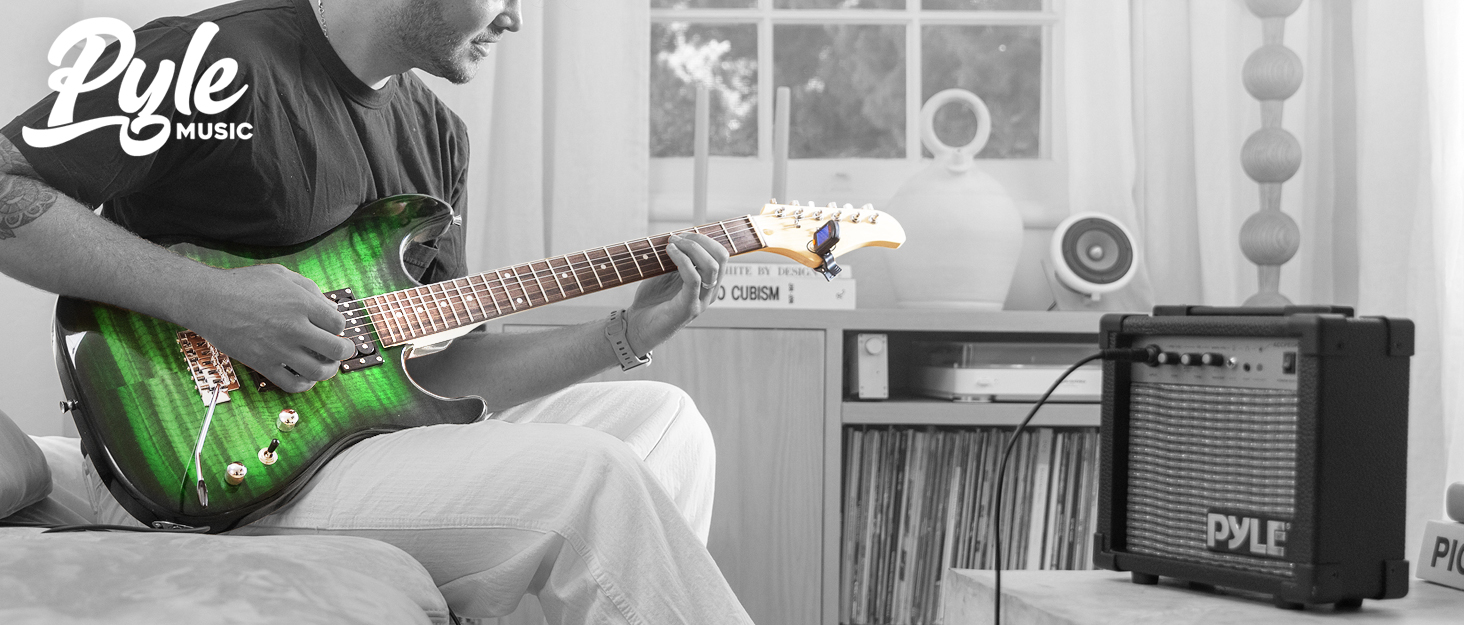
• 3,000+ VIDEO LESSONS • HUNDREDS OF COURSES • 80,000+ SONG TRACKS • VIDEO LESSONS FOR POPULAR SONGS

Visit the Store

Compare with similar items
Looking for specific info, customer reviews.
Customer Reviews, including Product Star Ratings help customers to learn more about the product and decide whether it is the right product for them.
To calculate the overall star rating and percentage breakdown by star, we don’t use a simple average. Instead, our system considers things like how recent a review is and if the reviewer bought the item on Amazon. It also analyzed reviews to verify trustworthiness.
Customers say
Customers like the quality, appearance, performance, sound quality and completeness of the stringed instruments. They mention that it's a decent product for beginners, looks professional and that it works well. Some are satisfied with size. However, some disagree on strings.
AI-generated from the text of customer reviews
Customers like the quality of the violin. They say it's a great starter kit that includes everything a beginner needs to begin learning. Customers also mention that the quality for price is pretty good.
"...Comes with a blanket, good amount of rosin in a nice case, electric tuner , booklet, rest, replacement strings, cleaning cloth and a long strap for..." Read more
"This is a great violin\fiddle for a new learner. I bought it to relearn to play...." Read more
"...Beautiful finish and all the supplies needed to begin learning ." Read more
"...The music teacher did say that the bow was kinda crappy , so we bought a better bow ($50) made of real horse hair (I believe) and bought better..." Read more
Customers are satisfied with the appearance of the violin. They mention it looks professional, is well-made, and is a great addition to the home decor. Some say that the bow is nice and the product is well presented.
"...Comes with a blanket, good amount of rosin in a nice case , electric tuner, booklet, rest, replacement strings, cleaning cloth and a long strap for..." Read more
"...This violin set was suggested by the violin teacher. Beautiful finish and all the supplies needed to begin learning." Read more
"This is a very nice set for beginners. Bow is nice - brand new, so make sure you put a lot of rosin...." Read more
"... All looks in order . I am trying to register the instrument to take advantage of a free metronome." Read more
Customers like that the stringed instruments come with everything they need to get started playing. They also appreciate the good accessories and lightweight case. Customers also mention that it's a great kit to buy and that it comes with all the tools they need.
"...I really like how it's a complete set with a nice lightweight case, shoulder rest, tuner, cleaning cloth and rosin...." Read more
"...It even came with all the tools he needed to get started. My son’s music teachers actually told him after his first day he had a great violin!!..." Read more
"Great instrument for our child. Everything you want is included and works great. Kids and parents all impressed." Read more
"Ordered this for a young family member and many items were missing from the order . No digital tuner. No extra set of strings. No picks...." Read more
Customers like the sound quality of the stringed instruments. They mention that it has a great sound, the resonance is remarkable, and it makes beautiful music.
"...The resonance is remarkable and the smell immediately brought back childhood orchestra memories and ones of my grandfather playing his fiddle when I..." Read more
"...The sound of the instrument itself is OK - acceptable for beginners - but you get what you pay for...." Read more
"...it made beautiful music . It even came with all the tools he needed to get started...." Read more
"...i mean it sounds like a violin to my untrained ears, the sound may not be deep or rich , or whatever other adjective violin players use, but hey!..." Read more
Customers are satisfied with the size of the stringed instruments. They mention that it is the perfect size and fits very well inside the case.
"Just perfect size for my 10yo children...." Read more
"...travel case is very convenient and the violin plus the other items fits snuggly without any worry of damage while on the go. Perfect for beginners." Read more
"...I had high hopes for this Pyle guitar. The size is right and the overall build is what I'd expect for about $60. The whole package show value...." Read more
" Guitar was just right size for my grandson. I was disappointed in the strapping. There should have been a post on guitar to attach both ends of strap." Read more
Customers like the performance of the violin. They say it works great, plays well, and is a working violin. Some customers also like the different modes of the tuner.
"...OK. For the price, cannot be beat; this is a working violin , i mean it sounds like a violin to my untrained ears, the sound may not be deep or rich,..." Read more
"... Better result than expected !!" Read more
"...it was fine but when I went to give to my student, the fine tuner didn't work at all ! Went back to music store for exchange or refund...." Read more
"So far I really like it. The tuner included works really well , I like the different modes for it...." Read more
Customers find the weight of the stringed instruments to be very light, making it perfect for beginners.
"...I really like how it's a complete set with a nice lightweight case , shoulder rest, tuner, cleaning cloth and rosin...." Read more
"...We bought it for our 8year old son. It’s a beautiful violin, lightweight and love that it brings everything a starter needs...." Read more
"...but the product is well presented, looks beautiful and it is very light , perfect for beginners." Read more
"...Its very lightweight and beautiful and came with multiple items that make it very beginner friendly, such as the rosin, tuner with baterry included,..." Read more
Customers are mixed about the strings. Some mention that the case, tuner, and extra strings are handy. However, some say that the strings are very tough on little fingers, and some of the strings were loose when it arrived.
"...amount of rosin in a nice case, electric tuner, booklet, rest, replacement strings , cleaning cloth and a long strap for the case...." Read more
"Violin is perfect for my 9 yr old child. A The bridge on the violin needs a grip so it does not slide. Overall, price is decent for a beginner...." Read more
"...with everything that comes with this kit including a tuner, extra strings , and a great case!..." Read more
"...•Nice case, tuner, and spare strings . You'll need these if you pop the E string immediately like I did :)Neutral:..." Read more
Reviews with images

- Sort reviews by Top reviews Most recent Top reviews
Top reviews from the United States
There was a problem filtering reviews right now. please try again later..
Top reviews from other countries

- Amazon Newsletter
- About Amazon
- Accessibility
- Sustainability
- Press Center
- Investor Relations
- Amazon Devices
- Amazon Science
- Start Selling with Amazon
- Sell apps on Amazon
- Supply to Amazon
- Protect & Build Your Brand
- Become an Affiliate
- Become a Delivery Driver
- Start a Package Delivery Business
- Advertise Your Products
- Self-Publish with Us
- Host an Amazon Hub
- › See More Ways to Make Money
- Amazon Visa
- Amazon Store Card
- Amazon Secured Card
- Amazon Business Card
- Shop with Points
- Credit Card Marketplace
- Reload Your Balance
- Amazon Currency Converter
- Your Account
- Your Orders
- Shipping Rates & Policies
- Amazon Prime
- Returns & Replacements
- Manage Your Content and Devices
- Recalls and Product Safety Alerts
- Conditions of Use
- Privacy Notice
- Consumer Health Data Privacy Disclosure
- Your Ads Privacy Choices

Air Travel with your Violin and Bow: Getting the Documents You Need
Written by Laurie Niles Published: June 26, 2014 at 9:38 PM [UTC]
- The FAA Air Transportation Modernization and Safety Improvement Act of 2012, approved by the U.S. Congress in February of that year, in Section 713, "requires an air carrier to permit an air passenger to carry a violin, guitar, or other musical instrument on a passenger aircraft without charge if it can be stowed safely in a suitable baggage compartment in the aircraft or under a passenger seat." Copy this bill, highlight Section 713, and put it in the pocket of your fiddle case. Here it is for you to copy.
- Bring your violin as your only carry-on bag to go in the overhead compartment.
- If possible, travel with a bow that contains no ivory, no tortoise shell, no pernambuco. If your bow contains no banned items, you don't need special documents. However, to be safe you can write to the maker or manufacturer and request a "materials declaration" document to keep in your case, in case you are accused of having ivory in your bow and need proof that you don't. (I wrote to Codabow , maker of my carbon fiber bow, and they were very prompt and helpful getting me this document. Coda told me they likely will begin making these available online; I'll let you know as soon as I have a link for that.)
- If your bow does contain any of the banned materials, see the explanation and link below and also read several helpful suggestions that have been made in the comments to this blog:
- Time for Three Violinists Denied on U.S. Airways Flight
- European Orchestra Caught in Bureaucratic Snag over Ivory in Bows
This entry has been archived and is no longer accepting comments.

Violinist.com is made possible by...

Los Angeles Chamber Orchestra
Metzler Violin Shop
Southwest Strings
Bobelock Cases
Johnson String Instrument/Carriage House Violins
Bay Fine Strings Violin Shop
Jargar Strings
Fiddlerman.com
FiddlerShop
Barenreiter
Nazareth Gevorkian Violins
Laurie's Books
Discover the best of Violinist.com in these collections of editor Laurie Niles' exclusive interviews.

- Mandolin Family Instruments
- Violoncellos da Spalla and Related
- 5-String Violins and Fiddles
- Octave Violins, 5-string Violas and Octave Violas
- Travel and Backpacker Fiddles (and Violas)
- Baroque Instruments (including pochettes)
- Selected Specials, Custom and Vintage
- Gallery: Custom and Discontinued
- Overview and Getting Started
- Examples of Some of Our Custom Work
Additional Information
- D. Rickert Musical Instruments
- Facebook Business Page
- Photo Galleries and Demos
- Latest News
- Shipping & Returns
- RSS Syndication
Account Navigation
Currency - all prices are in aud.

- Call us on 7068960909
- Sign in or Create an account

The NEW International Travel Violin by D. Rickert

Add to Wish List
Click the button below to add the The NEW International Travel Violin by D. Rickert to your wish list.

Product Description
The New International Travel Violin
This new travel violin was designed for violinists and fiddlers wishing to travel without worry with their instruments by air :
- To destinations outside of the U.S., especially Europe
- From one European region to another or from one country to another
- On any small plane (< 50 seats), regardless of destination, within the U.S. or abroad
- Desire an all wood, luthier-built instrument with a 4/4 playable string length,
- Require an instrument with the sonority and timbre close to that of a full-size instrument.
Introduction and Summary
This completely new instrument has a full-size playable string length of 12.75 inches. The cool thing about the International Travel Violin is that it has a body length of approximately 13 inches (normal 4/4 violin has a 14” body) and a cleverly shortened “scroll-less” pegbox. The result is a full-size instrument with a total length of only 20”! This allows the use of a case that is a mere 21” in length. It will fit into many TSA-certified 22” (height) carry-on roller bags! We will be happy to give you recommendations for our favorite carry-on bags.
FREE Test Fitting! : If you wish, we will send you a heavy-duty 4” x 21” craft tube for a test fitting with your carry-on baggage. Let us know if you would like to do this before we start building your instrument.
If you already have, or wish to use a slightly smaller carry-on bag, the International Travel Violin can be made even shorter than 20” on a custom basis, often at no extra charge.
You can, of course, take this instrument as your carry-on item in one of our available cases. In most air travel scenarios, you can also take a bow tube for a full-size bow along as well.
The bottom line is that you can take our International Traveler Violin as a carry-on item on most airlines anywhere in the world without worry, provided that you are not flying on what would be classified as a small plane (< 50 seats). Then, it is a crap-shoot. Also, regional flights throughout Europe and elsewhere often do not allow carry-on baggage of any kind, except for small electronic devices (laptops, tablets, phones, etc.), which always MUST be carried on the plane as a “personal item” (i.e. these items cannot be checked baggage).
If you ever would have to check-in your instrument for the cargo hold, our cases are strong enough to protect it.
See carry-on baggage size and weight limits for a good sampling of airlines all over the world .
Note: For the U.S. airlines on the list (see the above link) and, indeed, any U.S. airline, the carry-on baggage limits do not generally apply to small musical instruments, per U.S. law and associated FAA policies ( FAA Air Transportation Modernization and Safety Improvement Act of 2012, Section 713 ).
Detailed Description
The new International Travel Violin by D. Rickert looks essentially like a slightly shorter version (with a truncated pegbox) of our renowned Ranger C3 Travel Violin. No one has yet challenged our claim that the Ranger C3 is the best sounding travel violin in the world. The International Travel Violin is built on the same principals as the Ranger C3. The two instruments sound virtually the same. Of course, the larger Ranger C3 is somewhat more acoustically powerful—a laws of physics thing.
- Overall length : 20” (50.8 cm)
- Body length: 13” (33.02 cm)
- Nut width: 24 mm
- Width at middle: 3.2” (81.28mm)
- Rib height (at ends): 1.18” (30 mm)
- Rib height (middle): 1.53” (39 mm)
Note: all dimensions have been carefully worked out so that the Ranger C3, with chin rest attached (and, of course, the shoulder rest removed) fits perfectly into our 4” diameter case.
There is also room to spare for your bow and the detachable shoulder rest.
The case can be made to match the length of bow you will be using.
Playing Characteristics and Ergonomics
With its custom center-mounted chin rest and the adjustable shoulder rest in place, holding and playing the International Travel Violin feels pretty much like playing a regular violin. The Velcro-attached adjustable dense foam shoulder rest is easily removable for stowing the instrument in its case. The shoulder rest is actually more comfortable than many rests for regular violins
The International Travel Violin emits almost the same volume as a regular violin. The timbre is amazingly close to a better than average full-size instrument. It is full-bodied and focused. Its sound can best be described as somewhere in between our Neil Gow Pochette and our Deep Body Custom Travel Violin.
Rickert Deep Body Travel Violin (5-string version) Played by Nathan Aldridge ( YouTube )
Darci Jones Playing a Neil Gow Pochette by D. Rickert (YouTube)
- Wittner FineTune internally-geared tuning pegs
- These incredible tuning pegs have a gear system in the buttons. The gearing ratio is a very respectable 8.5:1. A cylinder in the middle of the peg shaft turns in response to turning the button. The pegs are celebrated for their kindness to the peg box. They are held in by friction. Some top violinists have even installed them on priceless antique violins. They look pretty much like ebony.
- Custom-made chin rest
- The chin rest is a “flat Flesch” type of rest, which we carve and re-shape to fit the tail of the International Travel Violin perfectly.
- The default tailpiece is an ebony “Hill” style. If a pickup volume control is installed, the tailpiece is a special poly-carbonate tailpiece by Wittner.
- Adjustable shoulder rest
- The new shoulder rest, attached with industrial strength Velcro, is much simpler to use and is actually more comfortable than any of its predecessors.
- As described above, there are a number of case options, including a plethora of colors and lengths. We have Super Duty and Ultra-lite cases.
- Order the case separately. See the related products at the end of this product listing.
The size of bow you will use depends on how long of a case that you can work with. If you intend to use a 21” case, you will need to use either a take-apart bow, carry your bow(s) in a separate bow tube or use an Incredibow. A ¼ size bow only requires a 24-25” long case. A ½ size bow requires about 27” in case length. A full-size bow requires a 31” long case. Incredibows are actually a very good option. These unique bows look something like Baroque bows. They are very populate among fiddlers; not so much with classical violinists. Incredibows are available in a variety of lengths, including a 19.25" size, which will fit into our short 21" cases. They are also available in various weights and tensions, which is quite helpful in compensating for short length. You should check out Incredibows . We have a lot of experience with them and can help you select the best size, weight and tension for your needs. Feel free to contact us.
Those of you who know us are aware that we really discourage the use of lousy bows. We also believe strongly that a bow for a travel violin should NOT be wooden.
See the Bows section of the Don Rickert Musician Shop .
Optional Built-In Pickup
Many customers opt to have a pickup installed. There are many pickup options. Please contact us if you wish to add a pickup.
Product Videos
At the recent 2013 Hoppin' John Old-time and Bluegrass Fiddlers' Convention in Silk Hope, NC, D. Rickert Musical Instruments had a vendor tent where we had some of our newest instruments. Among them was a five string version of our Deep Body travel violin, also known as a Rickert Travel Viola/Octave Violin. Among those trying out our instruments was a teenager named Nathan Aldridge. We had been looking for someone who could really demonstrate a five string fiddle...we knew immediately that Nathan was our man! He graciously agreed to do a demo on video and his mother kindly gave her permission for us to post the video on YouTube. Nathan went on to win 1st place in Bluegrass Fiddle and 2nd place in Bluegrass Banjo, to boot, later in the day!

Find Similar Products by Tag
Product reviews, write your own review.
We promise to never spam you, and just use your email address to identify you as a valid customer.
This product hasn't received any reviews yet. Be the first to review this product!
Find Similar Products by Category
Related products.

Newsletter signup
Further info, connect with us.
All prices are in USD . © 2024 Don Rickert Musician Shop | Sitemap | Powered by BigCommerce

Travel with your Violin with Great Peace of Mind
It can be a bit nerve-racking to travel with your most prized violin. So many things can go wrong… theft, heat, shocks.
Choose good insurance and a sturdy violin case. Loosen your strings and bow hair. Keep your violin in a climate-controlled room if possible. Monitor hygrometry changes and responds with silica gel desiccant or a Dampit to humidify your violin. Then, practice with a mute and ask for a safe room at the hotel you have chosen wisely.
There are a lot of factors you can manage at home that aren’t always in your control once you hit the road, but fear not– plenty of professionals do this kind of thing regularly and have kept their instruments alive for years, and you can too by taking some simple precautionary steps to keep your violin safe while traveling.
Violin Insurance
Before leaving, if your instrument is expensive, check with your insurance company how well insured you are against theft. If you are not, you should reconsider your insurance policy and purchase another insurance or option for your existing insurance. When I traveled a lot, I had ensured my best violin, but not the other ones, less pricy, that I have. Now that I travel less, I have downgraded my policy. So this is something you can adjust over time. The main thing is that your insurer knows that you travel. Then you should be properly covered in case of a theft.
What case to choose
Make sure your violin case is up for the task before you begin your travel. You’ll want something rugged, well-made, and snug. Case material is dependent on a number of factors specific to your use case, so consider whether you want something rock-solid and heavy or durable and light. Go for something weatherproof or perhaps even air-tight, and try to make room in the budget to buy a case with some quality suspension, a feature that uses some variation of interior material to protect some of your violin’s more sensitive parts from taking the impact from any jostling of the case. It’s really worthwhile to invest in a solid case rather than risk something going loose and wreaking havoc on your violin instead.
If you want to go all out on a hard case, one of the most high-end cases you can get your hands on is a Musafia . Hand-crafted in Cremona, Italy, this brand has been trusted by the most elite performers for ages. They’re thoroughly tested for durability before being sold and come in all sorts of designs that cut no corners, being both incredibly rugged and aesthetically pleasing. They come with just about anything you could ask from a case, as well as some features you probably wouldn’t have even thought to include in a case. The Luxury Classic Dart S3011 is a fine example of this and just one of their many offerings to consider.
If you’re after something affordable and reputable, check out Bobelock [https://www.bobelock.com/cases/violin/violincases.html] violin cases. Their cheaper cases don’t come with a lot of bells and whistles, but the brand does come with a great reputation spanning over a century and countless anecdotes of approval. The Bobelock 1047 in particular is a hefty case that comes with suspension and a built-in hygrometer at a reasonable price on Amazon.
Last thing, when you travel you usually walk a lot between buses, taxies, trains and planes. This instrument case back pack strap is shoulder padded for comfort and is a cheap and clever add-on to your violin case. It helps you carry your violin or viola with less pain and effort in those circumstances.
Loosen your violin’s strings and your bow’s hairs
In order to compensate for any potential warping which may arise throughout your travel, you should loosen the violin’s strings before storing it. Both the wood and the strings are subject to their atmosphere and can expand or contract depending on a number of factors, so to prevent any such variations from causing any complications with your violin (and to make sure your sound-post doesn’t take a trip through the back of your violin), loosen the strings before placing your violin in its case. You should also loosen your bow’s hairs, of course, for the same reason you do whenever you’re not playing.
Never store your violin in your trunk while traveling
Whether you’re on a bus, a train, or driving your own car, you do not want to take a chance on leaving your violin in a volatile place like a trunk. If you travel with your violin stored out of sight, you’re throwing its temperature control out the window and instead subjecting it to what’s more often than not an unregulated atmosphere. On a hot day, it gets the worst heat in the whole vehicle. On a cold day, it gets the worst cold. It could be dry back there, or it could be humid– it’s not up to you. Even if the trunk happens to have a good atmosphere for storing a violin (don’t count on it), you’re not even sure it’s going to be there if you don’t secure it well, as it’s at a much higher risk of being stolen than if you were to just hang onto it yourself. Keep it nearby and treat it with the care it requires at any other location.
For the same reasons, don’t leave your violin unattended in your car. You don’t know who might come by uninvited, and you do not want to leave it exposed to the elements. Cars heat up and cool down very, very quickly– don’t take the risk.
My old teacher used to compare his violin to a child that you would never leave in the car alone but bring with you, or leave on the floor instead of comfortably installed on a chair!
Keep your violin in climate-controlled rooms at all costs
As stated before, when you travel with a violin, it’s subject to whatever atmosphere you’re in. It’s important to prepare your violin for weather variations during your travel, but what would be even better is to avoid atmospheric complications in the first place. Obviously, you’re not in charge of whether it’s dry or humid outside, but optimally, you do have a say in how the weather feels inside. By all means, do what you can to maintain a healthy environment where you’re staying to keep your violin in good shape.
The stability of the environment is crucial, as the violin can adapt to a certain temperature or hygrometry, put changing all the time these factors are another story.
Now, depending on the part of the world you travel to, the air can be too dry or too humid. Remember that those old Italian luthiers didn’t design string instruments with around-the-world tours in mind! But there are a couple of ways to preserve your instrument integrity and playability without too much effort.
Defend your violin against hygrometry variations
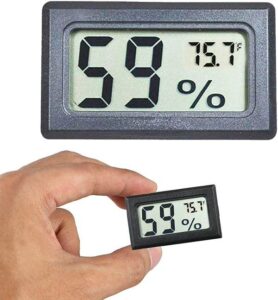
The violin is a natural instrument: it is made out of wood. And wood expands with humidity and retracts when the air becomes dry. This can have many consequences on the setup of the instrument, the tension of the strings on the bridge. The sound can be affected, and even cracks can happen to the body of the instrument. In eastern countries, the extremely humid atmosphere can cause the glue to melt and the body and the ribs and back to open slightly!
So the first thing you need if you travel far or in different climates is a small hygrometer to carry in your violin case if it didn’t come with one. This one has a really small form factor and is cheap on Amazon. It fits easily in a violin case.
Fight humidity in your violin case with dehumidifiers
If you’re going somewhere where it’s humid, take along a dehumidifier. There’s a number of products out there that can be used to reduce your instrument’s humidity if necessary. The simpler I’ve found to use is for example these silica gel packets , which have a good desiccant action and are easy to fit in my case. Be careful about this, though, as you can easily damage your instrument if you overcompensate for the excess moisture and wind up instead of drying the instrument out. In order to ensure your instrument maintains an optimal moisture level, use a hygrometer to monitor said moisture level in your violin.
Fight dry air with humidifiers
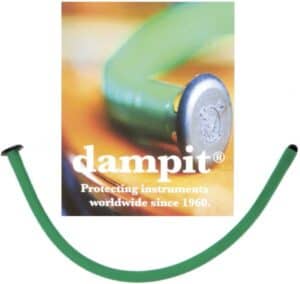
On the other hand, if you’re expecting it to be dry where you’re going, get yourself a humidifying product, such as the well-known Dampit . A Dampit does what you would expect: it gradually releases moisture into your instrument to avoid any humidity problems. Just let your Dampit in a glass of water before inserting it into your violin. Be sure to remove the excess water, of course, by carefully wiping it with a dry towel.
Just as you should be careful not to overdo it with the dehumidifier, be sure not to over-humidify it either. Again, your best bet is to use a hygrometer to keep an eye on your violin’s humidity levels and have the necessary materials on hand to counteract them as needed.
Practicing your violin in a hotel
While traveling with a violin, naturally you’re going to want to practice, but your fellow hotel guests might not be as eager about the notion as you are. In the interest of being considerate towards the other guests, make sure to bring a mute with you, and maybe even consider some other routes to further dampen the volume of your instrument.
If you have an electric violin, you can play without too much noise, as I have detailed in this post . But if you need to practice with your acoustic instrument, then you need to choose the heaviest mute such as a brass mute. I am pretty happy with this one on Amazon , not too expensive considering how practical it is.
It’s probably a good idea to save your playing for daylight hours as well. If it ends up being a problem, the worst-case scenario is someone from the front desk asks you to stop, so don’t be afraid to practice while you’re staying at a hotel.
Hotel safety for your pricy violin
Yes, you need to be considerate of your violin even when it comes to choosing your hotel. Every problem previously mentioned can be a risk in a hotel room if not considered ahead of time. If you can help it, choose a hotel located someplace safe. To mitigate any risk of theft, try to get a room on the higher levels of the hotel. If you’re concerned about improper care or bad intentions from hotel staff, opt to decline housekeeping service during your stay. Depending on the environment, it may also help to keep your violin relatively close to the room’s AC unit for temperature and humidity regulation as needed. As usual, take appropriate measures to monitor these factors and adjust them accordingly.
If you can travel with a cheap instrument or a cheap electric instrument, then things will be easier in all respects. But if you need to bring your pricy acoustic violin, then be extra careful. Ask if the hotel has a big safe in which you could store your instrument. Or if the manager has a safe room for valuables. You might be offered a way to be reassured with special consideration.
Basically, do whatever you can to monitor your violin’s condition when you travel just as you do when you’re at home. Plan your journey ahead of time to avoid any subpar conditions for your violin, and make sure you have the materials on hand to keep it in good shape should any issue arise. Other than that, hit the road, and get ready to ace your next performance.
I have been playing the violin since the age of 6. I have studied, like many, classical music at a conservatory. At the same time, I discovered Miles and Coltrane, BB King and Clapton... So I decided to learn how to improvise, how to free my playing, and how to incorporate these new elements in my music. This new Violin Trend, this is what I want to share with all of you!
Similar Posts
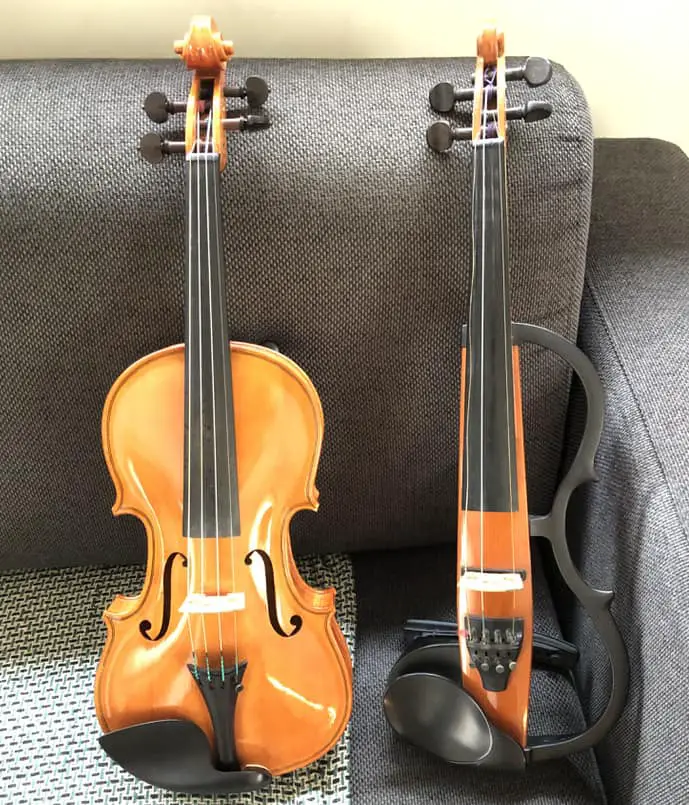
Electric Violin vs Acoustic: a Comparison with Pictures
It doesn’t come directly to mind to buy an electric violin the first time we think about starting. The romantic aspect of violin playing usually involves an acoustic instrument, a Stradivarius.But electric violins are not just for rock stars and not everybody can live in a big house without neighbors and practice at night. So…

Are Electric Violins Quiet, or perhaps even Silent? (With a dB Chart)
As lovely as the violin sounds, its volume has been the detriment to many players’ confidence, and even consideration, of picking the instrument up for a long time. It’s no wonder that electric violins have become so popular over the years considering that fact. Still, can an electric violin completely eradicate that problem? Electric violins…
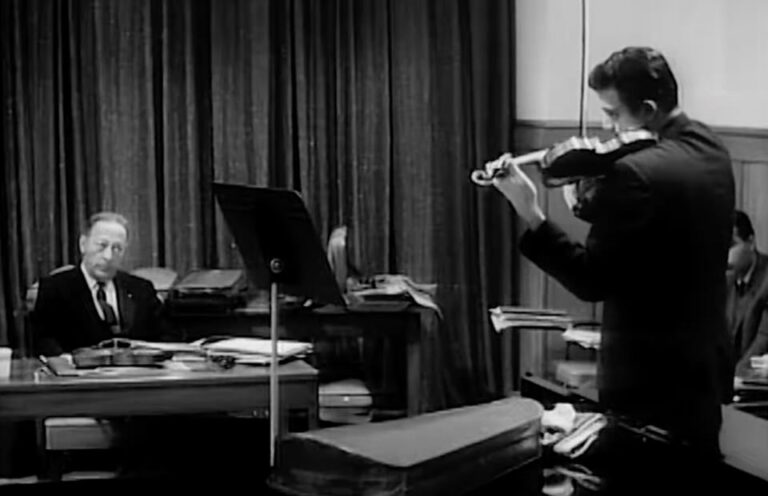
How Often Should I Practice the Violin? Daily vs weekly routine
Playing the violin implies two things: the first is to get always better, and the other is to never get out of shape. The former implies playing as much as possible, the latter not going below a bare minimum. I have explained how long should we play the violin every day in this blog post….
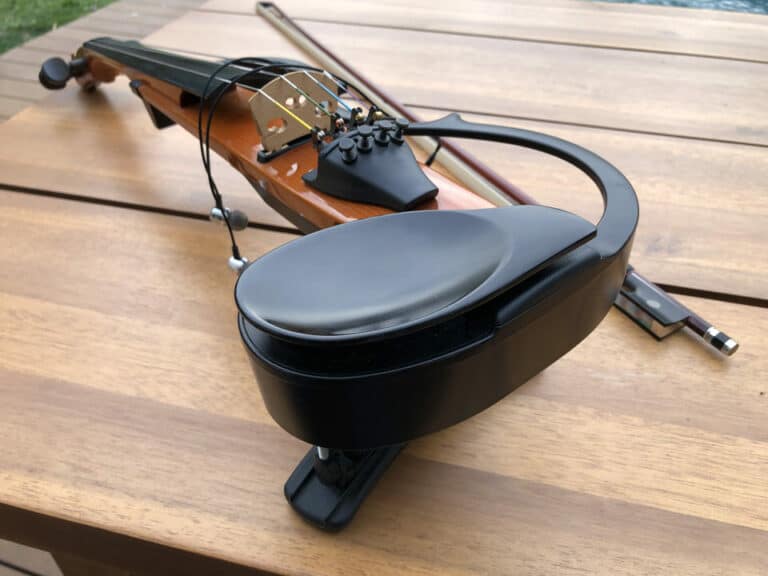
A Complete Test of Yamaha Silent Violins: the SV-100 Series and YSV104
It is the violin where it all started: the Yamaha Silent Violin SV-100. I was there at Lavillette Music Show in Paris back in 1997 when it launched and bought it straight away. So it is the first iteration of this great SV series (SV stands for Silent Violin, of course).Later, Yamaha enhanced and improved…
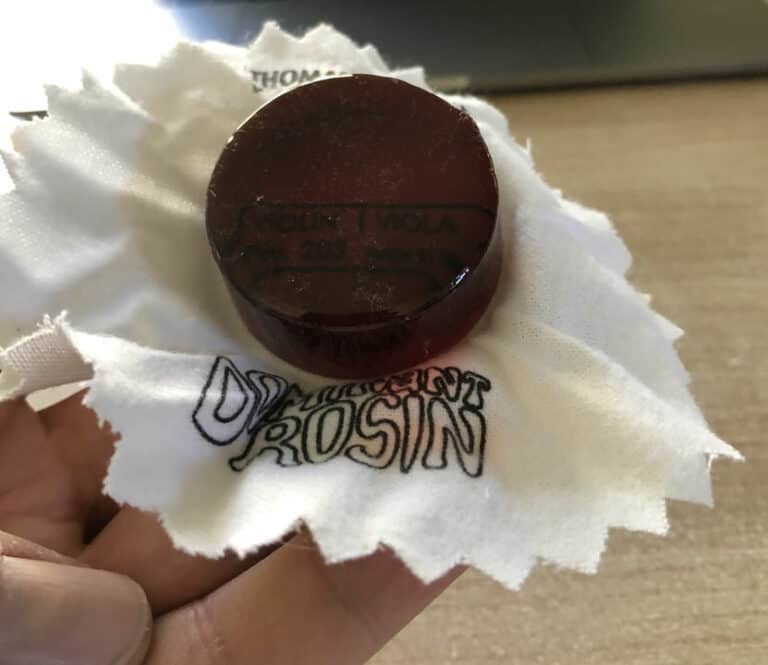
What is Violin Rosin and How to Choose it
Rosin is also known as colophony and is used by string players to coat their bow hair. The resulting white powder grips the string and makes it vibrate and then sing. Without rosin, a bow wouldn’t make any sound at all. It would only slide silently over the string. This is how rosin is important…
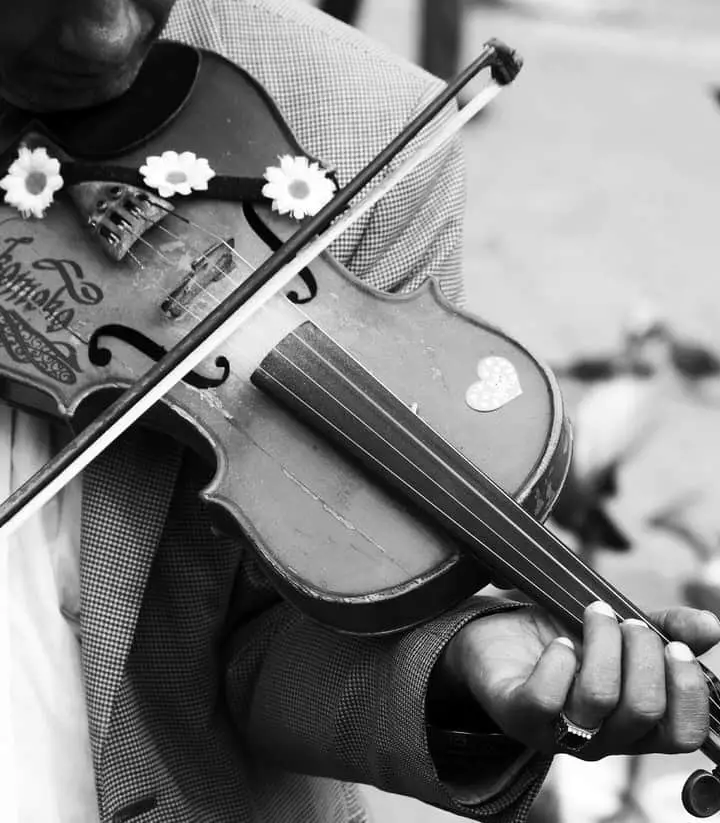
What’s the Difference between a Violin and a Fiddle?
The main difference is about twenty years of training and no one minds if you spill beer on a fiddle. Kidding aside, though, the two instruments are actually the same thing despite how radically different their musical associations are. Surely there’s some kind of difference for there to be such a distinction though, right? Well,…
Virtuoso Channel
Top culture news from top sources. Constantly updated.
- Arts & Culture
- Entertainment
- Classical Music
- Opera & Ballet
- Architecture
- Photography
Rodion Petrov: Vivaldi The Four Seasons, Moscow City Symphony
Related articles
Previous story.
Watch CBS News
What time the 2024 solar eclipse starts, reaches peak totality and ends today
By Sarah Maddox
Updated on: April 8, 2024 / 3:25 PM EDT / CBS News
The 2024 solar eclipse will be visible across North America today. As the moon's position between the Earth and sun casts a shadow on North America, that shadow, or umbra, will travel along the surface from west to east at more than 1,500 miles per hour along the path of totality .
That means the eclipse will start, peak and end at different times — as will the moments of total darkness along the path of totality — and the best time to view the eclipse depends on where you are located. Some places along the path will have more totality time than others.
In Texas, the south-central region had clouds in the forecast , but it was better to the northeast, according to the National Weather Service. The best eclipse viewing weather was expected in New Hampshire, Vermont and Maine, as well as in Canada's New Brunswick and Newfoundland.
What time does the 2024 total solar eclipse start?

The total solar eclipse will emerge over the South Pacific Ocean before the shadow falls across North America, beginning in parts of Mexico. The path of totality , where onlookers can witness the moon fully blocking the sun (through eclipse viewing glasses for safety ), is expected to first make landfall near the city of Mazatlán around 9:51 a.m. MT.
The total solar eclipse will cross over the U.S.-Mexico border into Texas, where it will emerge over Eagle Pass at 12:10 p.m. CT and then peak at about 1:27 p.m. CT.
In Dallas, NASA data shows the partial eclipse will first become visible at 12:23 p.m. CT and peak at 1:40 p.m. CT. The next states in the path of totality are Oklahoma and Arkansas, where the eclipse begins in Little Rock at 12:33 p.m. CT.
Cleveland will see the beginning of the eclipse at 1:59 p.m. ET. Darkness will start spreading over the sky in Buffalo, New York, at 2:04 p.m. ET. Then, the eclipse will reach northwestern Vermont, including Burlington, at 2:14 p.m. ET. Parts of New Hampshire and Maine will also follow in the path of totality before the eclipse first reaches the Canadian mainland at 3:13 p.m. ET.
Although the experience won't be exactly the same, viewers in all the contiguous U.S. states outside the path of totality will still be able to see a partial eclipse. Some places will see most of the sun blocked by the moon, including Washington, D.C., where the partial eclipse will start at 2:04 p.m. ET and peak at about 3:20 p.m. ET.
In Chicago, viewers can start viewing the partial eclipse at 12:51 p.m. CT, with the peak arriving at 2:07 p.m. CT. In Detroit, viewers will be able to enjoy a near-total eclipse beginning at 1:58 p.m. ET and peaking at 3:14 p.m. ET.
New York City will also see a substantial partial eclipse, beginning at 2:10 p.m. ET and peaking around 3:25 p.m. ET.
In Boston it will begin at 2:16 p.m. ET and peak at about 3:29 p.m. ET.
The below table by NASA shows when the eclipse will start, peak and end in 13 cities along the eclipse's path.
What time will the solar eclipse reach peak totality?
Millions more people will have the chance to witness the total solar eclipse this year than during the last total solar eclipse , which was visible from the U.S. in 2017.
The eclipse's peak will mean something different for cities within the path of totality and for those outside. Within the path of totality, darkness will fall for a few minutes. The longest will last more than 4 minutes, but most places will see between 3.5 and 4 minutes of totality. In cities experiencing a partial eclipse, a percentage of the sun will be obscured for more than two hours.
Mazatlán is set to experience totality at 11:07 am PT. Dallas will be able to see the moon fully cover the sun at 1:40 p.m. CT. Little Rock will start to see the full eclipse at 1:51 p.m. CT, Cleveland at 3:13 p.m. ET and Buffalo at 3:18 p.m. ET. Totality will reach Burlington at 3:26 p.m. ET before moving into the remaining states and reaching Canada around 4:25 p.m.
Outside the path of totality, 87.4% of the sun will be eclipsed in Washington, D.C. at 3:20 p.m. ET, and Chicago will have maximum coverage of 93.9% at 2:07 p.m. CT. New York City is much closer to the path of totality this year than it was in 2017; it will see 89.6% coverage at 3:25 p.m. EDT.
Detroit is another city that will encounter a near-total eclipse, with 99.2% maximum coverage at 3:14 p.m. ET. Boston will see 92.4% coverage at 3:29 p.m. ET.
What time will the solar eclipse end?
The eclipse will leave continental North America from Newfoundland, Canada, at 5:16 p.m. NT, according to NASA.
At the beginning of the path of totality in Mazatlán, the eclipse will be over by 12:32 p.m. PT, and it will leave Dallas at 3:02 p.m. CT. The eclipse will end in Little Rock at 3:11 p.m. CT, Cleveland at 4:29 p.m. CDT and Buffalo at 4:32 p.m. ET. Burlington won't be far behind, with the eclipse concluding at 4:37 p.m. ET.
Meanwhile, the viewing will end in Chicago at 3:21 p.m. CT, Washington, D.C. at 4:32 p.m. ET, and New York City at 4:36 p.m. ET.
In Detroit, the partial eclipse will disappear at 4:27 p.m. ET, and in Boston, it will be over at 4:39 p.m. ET.
How long will the eclipse last in total?
The total solar eclipse will begin in Mexico at 11:07 a.m. PT and leave continental North America at 5:16 p.m. NT. From the time the partial eclipse first appears on Earth to its final glimpses before disappearing thousands of miles away, the celestial show will dazzle viewers for about 5 hours, according to timeanddate.com .
The length of the total solar eclipse at points along the path depends on the viewing location. The longest will be 4 minutes and 28 seconds, northwest of Torreón, Mexico. Near the center of the path, totality takes place for the longest periods of time, according to NASA.
Spectators will observe totality for much longer today than during the 2017 eclipse , when the longest stretch of totality was 2 minutes and 32 seconds.
The moon's shadow seen on Earth today, called the umbra, travels at more than 1,500 miles per hour, according to NASA. It would move even more quickly if the Earth rotated in the opposite direction.
What is the longest a solar eclipse has ever lasted?
The longest known totality was 7 minutes and 28 seconds in 743 B.C. However, NASA says this record will be broken in 2186 with a 7 minute, 29 second total solar eclipse. The next total solar eclipse visible from parts of the U.S. won't happen until Aug. 23, 2044.
Sarah Maddox has been with CBS News since 2019. She works as an associate producer for CBS News Live.
More from CBS News

How often do total solar eclipses happen?
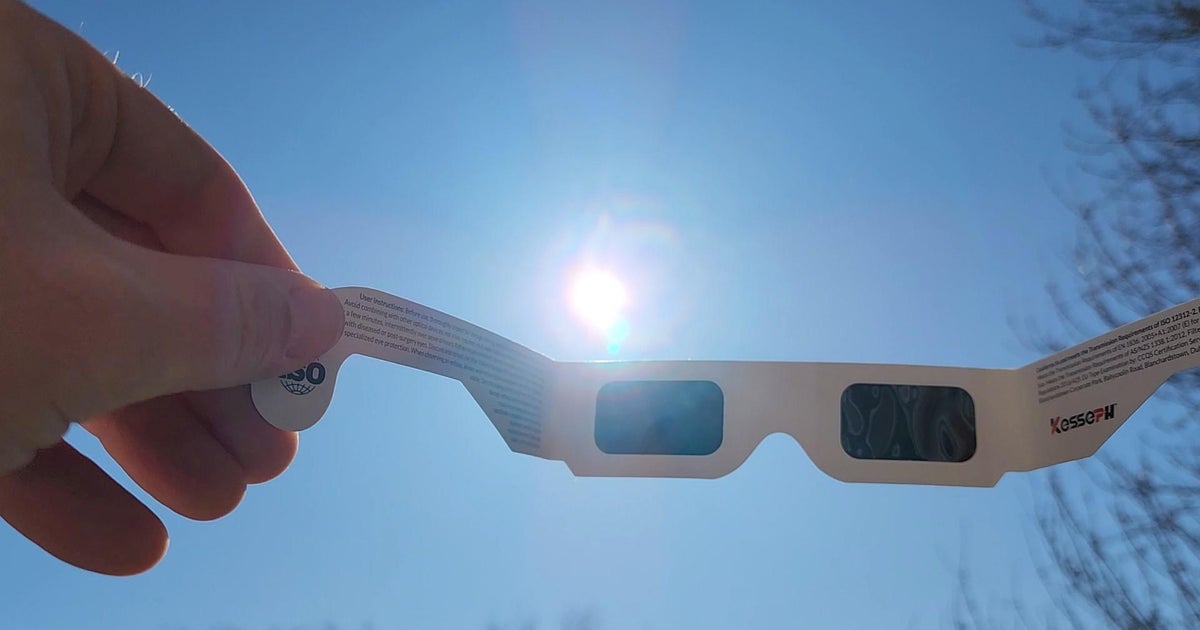
When is the next total solar eclipse in the U.S. after today?

Is it safe to take pictures of the solar eclipse with your phone?

When was the last total solar eclipse in the U.S.? Revisiting 2017
The 2024 solar eclipse is today! Here's everything you need to know to see it in Oklahoma

Today's the day millions of Americans have been waiting for: a total solar eclipse will cross over 15 states this afternoon.
For the first time in more than 100 years, areas of Oklahoma will experience a total solar eclipse. The eclipse will start in southwest Texas and move across the United States, including directly over southeast Oklahoma towns like Broken Bow, Idabel, Hugo and Antlers .
During the eclipse, the moon will completely block out the sun, casting a shadow on the Earth.
Here's everything you need to know to witness the eclipse, including when it will happen, where to watch and what the weather will look like.
Live updates: Monday's solar eclipse is today in Oklahoma, what time will it start?
What is a total solar eclipse?
According to NASA, a total solar eclipse occurs when the moon passes between the sun and earth and completely blots out the sun for a few minutes.
Anyone located in the center of the moon's shadow, known as the path of totality, will experience a total solar eclipse. The sky will darken and, if the weather cooperates, the sun's corona, or outer atmosphere, will be visible.
When is the solar eclipse 2024? When does the solar eclipse start near me?
The 2024 solar eclipse is Monday, April 8, 2024. Its path of totality will cross the United States from approximately 1:27 p.m. to 2:35 p.m. central time. That's when, if you're in the path of totality, the sky will darken for several minutes and the air will get colder.
Use the ZIP code locator below to find out when the eclipse begins and ends in your area — and what it will look like. (Can't see it? Hit refresh.)
What time is the solar eclipse in Oklahoma?
The eclipse will enter Oklahoma as it crosses the Red River at about 12:27 p.m., and exit the state at about 3:07 p.m., according to National Eclipse.
But the total eclipse, the direct casting of the Moon's shadow, will only last from about 1:44 p.m. to 1:51 p.m. in the state, Great American Eclipse estimates .
The center path of the eclipse, where totality lasts the longest, travels through Oklahoma for a mere 31 miles, the shortest distance of any state through which the centerline travels.
How long will the eclipse last in Oklahoma?
The Oklahoma towns that will experience the longest span of totality , or darkness when the moon completely covers the sun, include Idabel and Broken Bow, according to Eclipse2024.org. Totality will last around 4 minutes and 18 seconds in Idabel, and 4 minutes and 16 seconds in Broken Bow.
There are a few unincorporated communities in Oklahoma that will see about an extra second of totality.
When is the solar eclipse in Oklahoma City?
According to Eclipse2024.com , the first of the moon's shadow will be visible over the sun in Oklahoma City just before 12:30 p.m. and the last of the moon's shadow will exit Oklahoma City just after 3 p.m.
If you're hoping to witness the darkness that comes with a total solar eclipse, including getting to see the sun's outer corona, you'll want to make the drive to a city in the path of totality. However, Oklahoma City is much closer to the path of totality than it was during the 2017 total solar eclipse.
For Oklahoma City, this will remain a partial eclipse and safe eclipse viewing glasses will need to be worn throughout the event.
What is the eclipse weather forecast in Oklahoma?
The National Weather Service in Tulsa said there's a moderate to high likelihood the low cloud cover will remain north of the path of totality , which includes a chunk of southeast Oklahoma.
Thick, upper level clouds could stay mostly north as well, leaving mostly thinner cloud conditions across southeast Oklahoma, allowing for the eclipse to be seen through the clouds in these areas and in areas to the northeast.
Oklahoma eclipse weather: Low clouds may stay north of totality, allowing for eclipse viewing
According to USA Today, low clouds are the worst clouds for an eclipse . Wispy, high cirrus clouds would still allow the eclipse to be seen from the ground, while cumulus clouds are more unpredictable.
There is also a threat of severe storms expected in southern Oklahoma starting around 9 p.m. Monday night.
Travel safety tips for 2024 solar eclipse
If you're traveling to the path of totality to view the solar eclipse , either in Oklahoma or another state, here are some tips to ensure the best experience:
- Pay attention to local traffic updates, and bring a physical map with you incase cellular service goes down.
- Fill up on gas before heading into rural areas, where trucks carrying fuel may have trouble reaching due to traffic.
- Keep food, water and medical supplies handy in your vehicle. There's no way to know how long you'll be stuck in traffic.
- Only remove your eclipse glasses during the few minutes of totality, when the face of the sun is completely blocked out.
- Don't stop on the side or shoulder of the road to view the eclipse.
- Arrive to your destination early, and leave late to give traffic time to calm down.
Eclipse festivals, watch parties in Oklahoma
- Oklahoma state parks in the path of the total eclipse include Lake Wister, Talimena, Clayton Lake, Beavers Bend and Raymond Gary.
- Science Museum Oklahoma will host eclipse day activities from 10 a.m. to 2 p.m., including telescopes set up outside for safe viewing, creating indirect eclipse viewers, plus a storytime and crafts inside the museum.
- Fort Towson's 1840s Eclipse Watch Party: At the Fort Towson Historic Site, visitors can explore the historic location, watch demonstrations by reenactors and witness the total solar eclipse in the afternoon.
- Cherokee Landing State Park in Park Hill: eclipse viewing party with refreshments, eclipse glasses and family-friendly activities.
- Tenkiller State Park in Vian: Visitors can make their own shadow viewer, eclipse button and pick up a commemorative eclipse T-shirt and viewing glasses from the park gift shop, and watch the solar eclipse take place in the sky over the lake.
- Fenley Farm s in Valliant: Weekend camping and day passes to view the eclipse. The six-day event will include bonfires, music, singing, storytelling, and a cookout.
- Bigfoot Spring Music Festival in Honobia: live music, food and craft vendors, camping and Bigfoot-themed events
How to make your own eclipse viewer
- To build a box pinhole viewer you'll need a cardboard box, scissors, white sheet of paper, aluminum foil, a pencil, tape and a push pin.
- You'll need to cut the white sheet of paper, so it fits one end of the box, then tape it onto the inside of the box.
- On the opposite side of the paper, cut two holes on either end of the box. One for a viewing hole and the other, cut out a piece of the aluminum foil so it'll cover the hole completely. Tape the foil over the hole.
- Use the push pin to poke a tiny hole in the center of the foil and your pinhole viewer is complete.
When is the next solar eclipse after 2024?
Total solar eclipses are rare, with the next one visible in the US not for another 20 years . The path of totality for the 2044 total solar eclipse will only pass through three states: Montana, North Dakota and South Dakota.
Total solar eclipses with such a wide-reaching audience are even more rare, but much of the US is in luck as the next year, 2045, will bring another total solar eclipse . That time, fifteen states will be in the path of totality, including a much larger portion of Oklahoma.
Solar eclipses can only happen during a new moon, according to the National Weather Service .
Contributing: Kesheira Lately
2018 Primetime Emmy & James Beard Award Winner
R&K Insider
Join our newsletter to get exclusives on where our correspondents travel, what they eat, where they stay. Free to sign up.
A History of Moscow in 13 Dishes
Featured city guides.
- Skip to primary navigation
- Skip to main content
- Skip to primary sidebar
- Skip to footer
TravelAwaits
Our mission is to serve the 50+ traveler who's ready to cross a few items off their bucket list.
19 Unique And Fabulous Experiences In Moscow

- Destinations
Thinking of visiting Russia? When visiting such a famous city, one must, of course, visit the iconic landmarks first. Moscow has plenty of those, most of them in the center of the city, which is very well-planned for tourists. Once you’ve seen the sights that are on most travelers’ lists, it’s time to branch out and visit some of the lesser-known sites, and there are some fascinating places to see and things to do.
I know this list is long, but I just couldn’t help myself. You probably won’t have the time to see them all. But that’s okay. Just scroll through the list and choose what sounds the most interesting to you. Where possible, make sure to book in advance, as things can get crowded, especially during high season.

1. The Red Square, Kremlin, And Surroundings
Red Square (Krasnya Ploshad) is the heart and soul of Russia, and where much of the country’s history has unfolded. This is the most famous landmark in Moscow and indeed the whole country, it’s an absolute must-do! The square is always full of people and has a rather festive atmosphere!
Saint Basil’s Cathedral
This is the famous church with the rainbow-colored, onion-domed roof. The cathedral was commissioned in the 1500s by Ivan the Terrible and according to legend, the Tsar thought it was so beautiful, that he ordered that the architect’s eyes be cut out afterward, so he could never build anything more beautiful! He wasn’t called Ivan the Terrible for no reason!
Lenin’s Mausoleum
The “love-it-or-hate-it” of tourist attractions in Russia. A glass sarcophagus containing the embalmed body of Russian revolutionary, Vladimir Lenin. It may seem a bit bizarre to display the mummy of a person, but it has been there for almost half a century and the 2.5 million visitors who come each year, clearly feel the queuing and thorough body search are worth it, to be in Lenin’s presence.
Pro Tip: no photos and no loud talking are allowed inside the Mausoleum.
Eternal Flame
There is an Eternal Flame in honor of an unknown soldier on the left side of Red Square. The hourly changing of the guards is worth seeing.
The Kremlin is the official residence of the Russian president. You can see it from the outside, or you can take an excursion to one of the museums located inside. This is the biggest active fortress in Europe, and holds a week’s worth of attractions! Once behind the 7,332-feet of walls, there are five squares, four cathedrals, 20 towers, various museums, and the world’s largest bell and cannon to see. Worth a special mention is the Armory Chamber that houses a collection of the famous Faberge Eggs.
Pro Tip: You can only go inside the Kremlin if you are part of a tourist group.

2. Bolshoi Theatre
Bolshoi Theatre translates to “The Big Theatre” in Russian, and the building is home to both the Bolshoi Ballet and Bolshoi Opera — among the oldest and most famous ballet and opera companies in the world.
Pro Tip: It’s hard to get an inexpensive ticket, so if you’re reading well in advance of going to Moscow then try buying tickets on the official website . Last-minute tickets cost around $250 per person. If this is out of your budget, about an hour before a performance, you can try buying a ticket at the entrance from a reseller. Most can speak enough English to negotiate the price.
Tour the Bolshoi Theatre: You can take a group guided tour of the Bolshoi Theatre which focuses on the history and architecture of the theatre and behind the scenes. There’s an English language tour that lasts 2 hours and costs around $300 for a group of up to six.

3. Luxury Shopping At GUM And TSUM
Russia’s main department store, GUM, has a stunning interior that is home to over 100 high-end boutiques, selling a variety of brands: from luxurious Dior to the more affordable Zara. Even if shopping is not on your Moscow to-do list GUM is still worth a visit; the glass-roofed arcade faces Red Square and offers a variety of classy eateries. TSUM, one of the biggest luxury malls in town, is right behind the Bolshoi and GUM. It’s an imposing building with lots of history, and worth a visit just for its design and its glass roof.

4. Christ The Savior Cathedral
This is one of Russia’s most visited cathedrals and is a newer addition to the gorgeous array of Muscovite cathedrals, but don’t let its young age fool you. After perestroika, in the early 90s, the revived Russian Orthodox Church was given permission to build a cathedral on this site. It did the location honors and built the largest temple of the Christian Orthodox Church. The façade is as grand as you’d expect, but it’s the inside that will mesmerize you, with its domes, gold, gorgeous paintings, and decor!
The cathedral is located just a few hundred feet away from the Kremlin and was the site of the infamous Pussy Riot protest against Putin back in 2012.
Pro Tip: Bring a shawl to cover your hair as is the local custom.

5. Gorky Park
Moscow’s premier green space, Gorky Park (Park Gor’kogo) is the city’s biggest and most famous park. There is entertainment on offer here for every taste, from outdoor dancing sessions to yoga classes, volleyball, ping-pong, rollerblading, and bike and boat rental in summer. In winter, half the park turns into a huge ice skating rink. Gorky Park is also home to an open-air movie theater and the Garage Museum of Contemporary Art. There is also Muzeon Art Park, a dynamic contemporary space with a unique collection of 700 sculptures. It is located right in front of Gorky Park.
6. Sparrow Hills Park
If you take a walk from Gorky Park, along the Moscow River embankment, you’ll end up in the city’s other legendary park, Sparrow Hills. Although the park doesn’t offer as many activities as its hip neighbor, it has a great panoramic view of the city
Pro Tip: You can take a free walking tour to all of the above attractions with an English-speaking guide.

7. River Cruising
One of the best ways to experience Moscow, and see all the famous landmarks, but from a different angle, is from the Moscow River. Take a river cruise. Avoid the tourist crowds. There are little nameless old boats that do the cruise, but if you are looking for a more luxurious experience take the Radisson Blu cruise and enjoy the sights with some good food and a glass of wine.

8. Metro Hopping
Inaugurated in the 1930s, the Moscow Metro system is one of the oldest and most beautiful in the world. Started in Stalinist times, each station is a work of art in its own right. I’d recommend touring the stations between 11 a.m. and 4 p.m. This way, you’ll be able to properly see it without the crowds. Ideally, I’d recommend taking a tour with a knowledgeable guide with GuruWalk, who will tell you stories of forgotten stations and how the history of the country is interconnected with the metro development. If going by yourself, then I definitely recommend checking out: Mayakovskaya, Ploschad Revolutsii, Kievskaya, Kropotkinskaya, Kurskaya, and Novoslobodskaya stations.
Visit the free Moscow Metro Museum: For real train enthusiasts, located in the southern vestibule of Sportivnaya station is a small free museum. Here you can take a peek into the driver’s cabin, see a collection of metro tokens from different cities, and see different models of a turnstile, traffic lights, escalator, and more.

9. Moscow State University View
In his effort to create a grander Moscow, Stalin had seven skyscrapers built in different parts of town; they’re called the Seven Sisters. The largest of these buildings and the one with the best view is the main building of the Moscow State University. Although this is a little outside the city center, the view is more than worth it.

10. Izmailovsky Market
Mostly known for the city’s largest flea market, the district of Izmaylovo is home to a maze of shops where you can get just about anything, from artisan crafts to traditional fur hats, handcrafted jewelry, fascinating Soviet memorabilia, and antiquities. It’s also one of Moscow’s largest green spaces. There are often no price tags, so be prepared to haggle a bit. Head to one of the market cafes for a warming mulled wine before continuing your shopping spree.
The History of Vodka Museum is found here, and the museum’s restaurant is the perfect place to sample various brands of the national drink.
Once you’ve covered the more touristy spots, Moscow still has plenty to offer, and the places below will also be full of locals! So for some local vibes, I would strongly recommend the spots below!

11. Moscow City
With a completely different vibe, Moscow City (also referred to as Moscow International Business Center) is like a mini Dubai, with lots of impressive tall glass buildings. Here is where you’ll find the best rooftops in towns, like Ruski Restaurant, the highest restaurant both in Moscow City and in Europe. Moscow City is great for crowd-free shopping and the best panoramic views of the city.

12. Tretyakov Gallery
Tretyakov Gallery started as the private collection of the Tretyakov brothers, who were 19th-century philanthropists. They gave their private collection to the government after their deaths. If there is just one museum you visit in Moscow, I recommend this one!

13. Tsaritsyno Museum-Reserve
Tsaritsyno was a residence of Catherine the Great more than two centuries ago. It became derelict during the Soviet era but has now been fully renovated. With its opulently decorated buildings, gardens, meadows, and forests, Tsaritsyno Park is the perfect place for a green respite in Moscow.

14. Kolomenskoye
A 10-minute metro ride from the city center is Kolomenskoe Museum-Reserve, where you can get an idea of what Russia looked like 200 years ago. You’ll find ancient churches (one dating back to the 16th century), the oldest garden in Moscow, and the wonderful fairytale wooden palace of Tsar Alexey Mikhailovich, father of Peter the Great.

15. Ostankino TV Tower
Built in 1967, Ostankino TV Tower was the tallest free-standing construction in the world at the time, it’s still the 8th tallest building in the world and the highest in Europe. It’s also the best observation deck, with a glass floor and 360-degree views. The speedy elevators take you 1,105 feet in next to no time.
Pro Tip: You need to book in advance; entrance is based on specific ticket times and the capacity is limited and only a certain number of tourists are allowed per day. Don’t forget your passport, you’ll need it to get through security.

16. Zaryadye Park
Zaryadye is a newly opened, landscaped urban park so new you won’t find it in a lot of tour guides. The park is near Red Square and is divided into four climatic zones: forest, steppe, tundra, and floodplains, depicting the variety of climatic zones in Russia.
These last three suggestions are a little quirky, but all are really worth checking out.
17. Museum Of Soviet Arcade Games
Release your inner child playing on 66 arcade machines from the Soviet era! What a great way to spend a couple of hours when tired of visiting museums and palaces. The staff speaks excellent English and are happy to explain how the games work.

18. Moscow Rooftop Tour
Take a 1-hour private Moscow rooftop tour with an experienced roofer. I can just about guarantee none of your friends will be able to say they’ve done it! For your comfort, I recommend wearing comfortable shoes. Take your camera, there are some amazing photo opportunities out there!

19. Sanduny Banya
This classical Russian bathhouse opened its doors in 1808 and is famous for combining traditional Russian banya services with luxurious interiors and service. If you enjoy spas and saunas, then you should experience a Russian bathhouse at least once in your life! Go with an open mind and hire a specialist to steam you as it’s meant to be done — by being beaten repeatedly with a besom (a leafy branch)! This is said to improve circulation, but is best done by a professional!
So there you have my list of things to do in Moscow. I could have gone on and on and on, but I didn’t want to try your patience! There are so many things to do in this vibrant city that you’ll definitely need to allocate several days for exploring.
Here are some other reasons to visit Moscow and Russia:
- 7 Reasons To Put Moscow On Your Travel Bucket List
- Russia 30 Years (And 30 Pounds) Ago
- Massive Mysterious Craters Appearing Again In Siberia

Born and raised in Sydney, Australia, before moving to Africa at the age of 21, Sarah Kingdom is a mountain climber and guide, traveler, yoga teacher, trail runner, and mother of two. When she is not climbing or traveling she lives on a cattle ranch in central Zambia. She guides and runs trips regularly in India, Nepal, Tibet, Russia, and Ethiopia, taking climbers up Tanzania’s Mount Kilimanjaro numerous times a year.

IMAGES
VIDEO
COMMENTS
Violin Travel Set. All 3 parts of the set can be used independently or in different combinations. ... This is the main purpose of the Trinity Set - to transport your violin and bows safely through the check-in procedure, without any discussions with flight personnel and the airline's one-piece-cabin-luggage-only -policy, buying extra seats etc.
Viola $535 Take-Apart Bow $95 . A few unsolicited comments from owners of a practice violin or viola: "I received the travel violin in perfect condition. It surpasses all my expectations concerning quality, playability, and ease of assembly." "The travel violin has turned out to be just what I needed, and I am very pleased with it.
Travel violin bow. Designed to be free from all customs issues, this bow gets down to basics. To begin with, every stick I carve is selected from very nice pieces of Pernambuco. They are chosen them for their acoustics, aesthetics and mechanics. The adjuster is simple, not adorned with mother-of-pearl or any other decoration.
Wipstix is the original travel violin. Imagine where youre violin would take you if it could fit into a 2" diameter piece of PVC pipe? top of page. [email protected]. WIPLSTIX.COM. 828 713 2424. ... and with a 1/8th size bow and inflatable chinrest (sold separately), they will fit inside a 2" diameter by 24" long watertight, traveling ...
Lighter than the average violin bow, the Luma carbon fiber bow enables a facile and nimble response for playing your way through the most challenging musical sections — especially those jumps in spiccato. ... International Travel Approved. CodaBow's carbon fiber Luma bow bears the GlobalBow® trademark. This designation ensures that our ...
OEM 4/4 Natural Acoustic Violin Fiddle with Hard Case, Bow, Rosin Full Size for beginners 2023 - Wood. Brand New. Mansfield, TX, United States. $79.99. $79.99. Free Shipping. Add to Cart. 14-Day Return Policy. NEW OEM 4/4 Violin Set Full Size Fiddle for Adults Solid Wood with Two Bow EVA-330.
Get a separate bow case or a small PVC pipe slightly longer than your bow.; Make sure to loosen the bow hair to prevent it from tightening during the travel period. If the bow hair becomes too tight, it might probably snap. Once it is loosened, pad both sides of the bow, or wrap it with packing material to prevent the bow from moving. Wrap the packed bow in PVC with bubble wrap.
For professionals seeking a bow for outdoor work, for international travel, or as a backup bow, a mid-priced carbon fiber bow can be an excellent choice. Fine Wooden Bows. For the player seeking a fine, traditional, pernambuco or ipe wood bow. ... Light-Weight Carbon Fiber Violin Bows for Professionals - Lightweight, Powerful, and Lightning ...
The dry air dehydrates your skin and body, causing dry skin irritation, thirst, and headaches. Your violin can also "dry out," fall out of tune, and crack. With the help of a violin humidifier, your instrument can better maintain its integrity and be kept in the 45-55% humidity range. Violin humidifiers range in price from $10-$100.
Diamond SX Violin. Buy in monthly payments with Affirm on orders over $50. Learn more. The ultimate gigging bow, now available as a customizable Chroma Experience! Customize This Bow. Please allow up to 10 days for all custom orders. With a traditional design, the CodaBow Diamond SX carbon fiber violin bow offers a more focused, brighter tone ...
1. Fiddlerman Carbon Fiber Violin Bow. Size: 1/16 up to full size. Weight: (full size) 60-64 grams. Material & finish: Carbon fiber bow, real horsehair, leather grip. Best for: Beginner and intermediate violinists. The Fiddlerman Carbon Fiber Violin Bow is a great budget bow for beginning and intermediate violinists.
- Nickle-mounted bows from Marco Raposo - Brazil Buzatto nickle-mounted violin bows - Sousa nickle-mounted violin bows made in Brazil - JonPaul Composite Travel bows made in USA - Nickle-mounted brazilwood bows from Echo Bridge Music - Tanglewood silver- and nickle-mounted bows - Carbon fiber nickle-mounted bows made in China
Details. Price: $715. Weight: 2.6 lb. Size: 4/4 violins. Show More... Shop Bam Cabin Violin Case. As the name suggests, the Bam cabin violin cases were specifically designed by Bam for airline travel. The case itself does not exceed 24 inches in length (maximum carry-on length). There are no bow-holders in the case.
Price: $ 109. Features: ebony frog, simple eye and round massaranduba stick. Dörfler makes excellent violin bows in Germany and really is a brand to look for when buying a wooden violin bow. Massaranduba is a municipality in Brazil making this a brazil wooden (but not pernambuco) violin bow.
Pyle Full Size Beginner Violin Starter Kit, Violin Starter Package with Travel Case & Bow, Extra Strings, Digital Tuner, Shoulder Rest & Cleaning Cloth for Students, Kids, Adults . Visit the Pyle Store. 4.1 4.1 out of 5 stars 568 ratings | Search this page . Color: d) 4/4 Size . $91.99 . $80.04 . $99.99 . 1 option from $163.99 .
No room for a violin! I've started carrying a hyper-portable violin called a WiplStix (www.wiplstix.com) that fits in a 2" hard PVC tube. Its sound is, at best, thin and whiny, but it lets me practice (at least my left hand). Bowing is somewhat limited because a 1/4 size bow is all that fits into the travel container, due to length restrictions.
Bring your violin as your only carry-on bag to go in the overhead compartment. Avoiding having your bow confiscated. If possible, travel with a bow that contains no ivory, no tortoise shell, no pernambuco. If your bow contains no banned items, you don't need special documents. However, to be safe you can write to the maker or manufacturer and ...
The cool thing about the International Travel Violin is that it has a body length of approximately 13 inches (normal 4/4 violin has a 14" body) and a cleverly shortened "scroll-less" pegbox. The result is a full-size instrument with a total length of only 20"! ... In most air travel scenarios, you can also take a bow tube for a full ...
It can be a bit nerve-racking to travel with your most prized violin. So many things can go wrong… theft, heat, shocks. Choose good insurance and a sturdy violin case. Loosen your strings and bow hair. Keep your violin in a climate-controlled room if possible. Monitor hygrometry changes and responds with silica gel desiccant or a Dampit to ...
Walking tour around Moscow-City.Thanks for watching!MY GEAR THAT I USEMinimalist Handheld SetupiPhone 11 128GB https://amzn.to/3zfqbboMic for Street https://...
Born in Moscow, Russia (1978) in the musical family. At the age of 5 began his violin lessons and at the age of 7 appeared as a soloist with Moscow Radio Symphony Orchestra conducted by V. Fedoseev in one of the best Moscow concert halls. Studied in the music school of Queen Sofia in Madrid (1999-2001). Currently studies in Tchaikovsky Moscow ...
New York City will also see a substantial partial eclipse, beginning at 2:10 p.m. ET and peaking around 3:25 p.m. ET. In Boston it will begin at 2:16 p.m. ET and peak at about 3:29 p.m. ET. The ...
The Oklahoma towns that will experience the longest span of totality, or darkness when the moon completely covers the sun, include Idabel and Broken Bow, according to Eclipse2024.org. Totality will last around 4 minutes and 18 seconds in Idabel, and 4 minutes and 16 seconds in Broken Bow. There are a few unincorporated communities in Oklahoma ...
1: Off-kilter genius at Delicatessen: Brain pâté with kefir butter and young radishes served mezze-style, and the caviar and tartare pizza. Head for Food City. You might think that calling Food City (Фуд Сити), an agriculture depot on the outskirts of Moscow, a "city" would be some kind of hyperbole. It is not.
5. Gorky Park. Moscow's premier green space, Gorky Park (Park Gor'kogo) is the city's biggest and most famous park. There is entertainment on offer here for every taste, from outdoor dancing sessions to yoga classes, volleyball, ping-pong, rollerblading, and bike and boat rental in summer.